Midterm Baroque
1/190
Earn XP
Description and Tags
Name | Mastery | Learn | Test | Matching | Spaced |
|---|
No study sessions yet.
191 Terms
Protestant Reformation, iconoclasm
The Protestant Reformation was a religious movement in the 16th century that rejected certain practices of the Catholic Church, leading to the emergence of various Protestant denominations. Iconoclasm during this period involved the destruction of religious images and icons, reflecting a belief that such items were contrary to true worship. (Netherlands-iconclasts)
Counter Reformation (Catholic Reformation)
A movement within the Catholic Church initiated in response to the Protestant Reformation aimed at reforming church practices, reaffirming core doctrines, and combating the spread of Protestantism through the establishment of the Jesuits and the Council of Trent.
Clarity of subject
Accuracy of narrative
stimulation to piety
Council of Trent
A pivotal ecumenical council of the Catholic Church held from 1545 to 1563 that addressed issues of church reform, reaffirmed Catholic doctrine in opposition to Protestant beliefs, and established key practices to guide the faith.
Gabriele Paleotti, Discourse on Images, 1582: docere, delectare, movere
A significant text by Gabriele Paleotti that discusses the role of religious images in art, emphasizing their purposes to teach (docere), delight (delectare), and move the viewer emotionally (movere) towards faith.
Mannerism
An artistic style that emerged in the late Renaissance, characterized by elongated forms, exaggerated poses, and a complex composition. Mannerism often expresses tension and instability, diverging from the balanced and harmonious ideals of earlier Renaissance art. Much inspired by Michelangelo in paintings and sculpture
complex
esoteric
erudite
Academia degli Incamminati, 1582
An art academy established in Bologna, focused on the study and practice of art, promoting a return to the principles of classical art and a systematic approach to painting. It aimed to refine the skill of artists and elevate the status of painting as a profession.
Agostino (on appropriation) from Raphael a feminine grace of line, from Michelangelo a muscular force from Titian strong colors and from Correggio gentle colors
Study of Reclining Boy
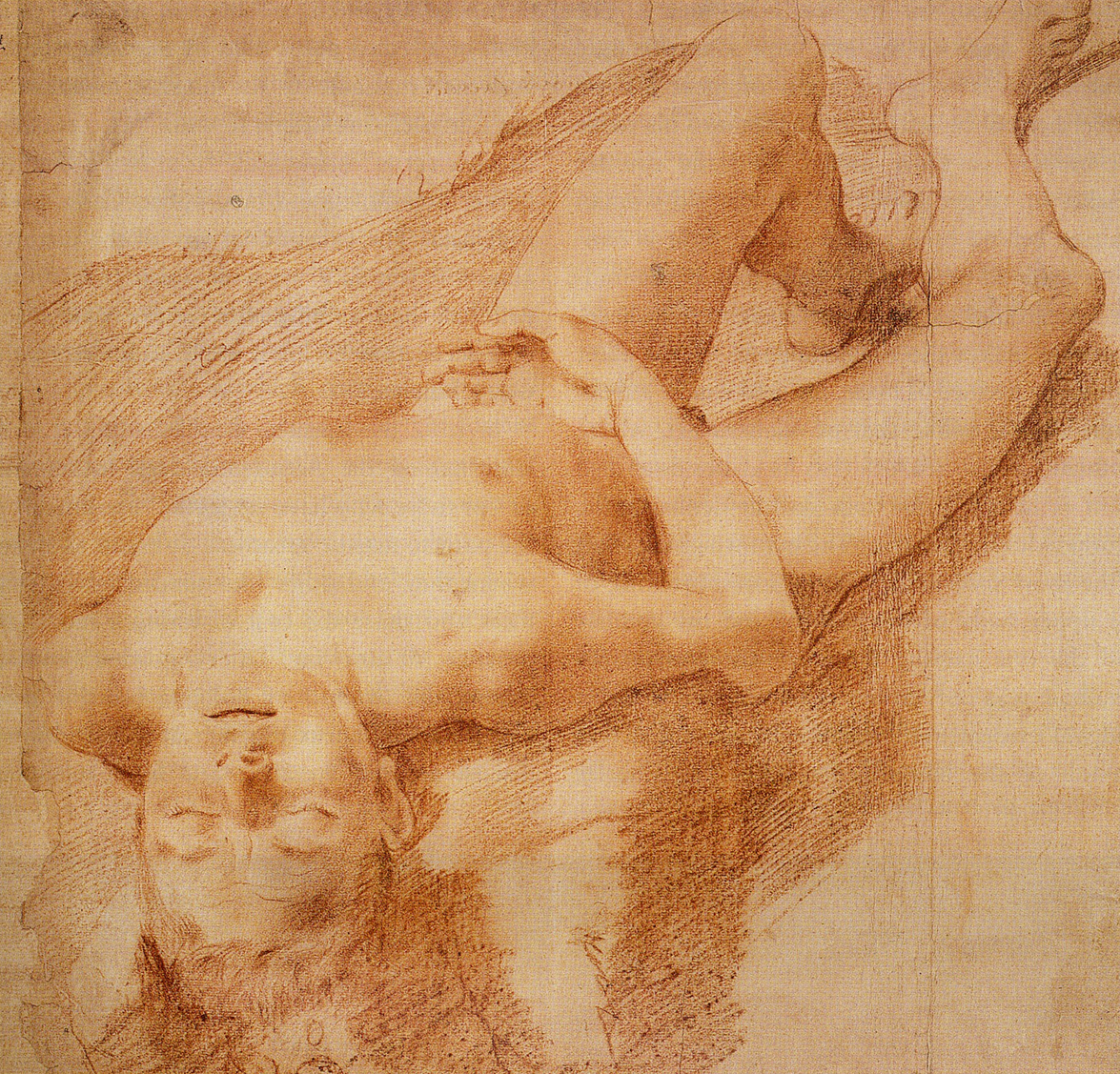
Annibale Carracci
ca. 1580
Period/Movement: Late Renaissance / Early Baroque (Italy, late 16th century)
Original Location: Likely a preparatory study for a larger fresco or painting, possibly for a church, palace, or academic training
Current Location: Various collections (exact location uncertain, possibly in a museum or private collection)
Patron: No specific patron; likely part of Carracci’s studies for future commissions
Material/Media/Medium: Red chalk on paper
Technique: Naturalistic rendering using careful contour drawing and shading to create volume and depth
CONTENT (What can you see?)
A young boy is reclining, his body twisted slightly as he rests.
The pose is relaxed but detailed, with attention to anatomy, musculature, and proportions.
The boy’s limbs are positioned naturally, reflecting movement and weight.
The study is unfinished in some areas, suggesting it was an exercise in capturing the human form.
FORM (Finer details, Elements of Art & Principles of Design)
Line: Soft, precise lines define the form with fluidity and confidence.
Shape & Proportion: The body is carefully rendered with naturalistic proportions.
Value (Light & Shadow): Shading with red chalk creates depth and volume.
Composition: Balanced with an emphasis on anatomical accuracy.
Texture: The chalk medium allows for smooth transitions between light and shadow, creating a lifelike quality.
CONTEXT (Why was this piece created?)
During the late 16th century, the Carracci family was pioneering a shift away from the artificial mannerism of the time, favoring more naturalistic representations.
Italy was experiencing a religious transformation due to the Counter-Reformation, leading to a greater emphasis on clarity and realism in art.
Carracci was training artists in the Accademia degli Incamminati (Academy of the Progressives), where life studies were crucial for artistic development.
FUNCTION (Purpose of the artwork?)
Likely a preparatory study for a larger painting or fresco.
Served as a training exercise to refine Carracci’s ability to depict the human figure naturally.
Possibly used as a teaching aid for students at the Accademia degli Incamminati.
STYLE (Why does this fit into a particular movement or artist's style?)
Characteristic of Carracci’s emphasis on naturalism, rejecting the exaggerated poses of Mannerism.
The use of red chalk aligns with Renaissance and Baroque academic drawing practices.
The dynamic, lifelike pose suggests a shift towards the Baroque style’s focus on movement and emotional depth.
MEANING (What does this artwork represent?)
Reflects the growing interest in human anatomy and realism during the late Renaissance and early Baroque periods.
Represents the transition in art from the idealized, stylized figures of Mannerism to the more grounded and naturalistic depictions of the Baroque.
Demonstrates Carracci’s belief in direct observation as a means of achieving artistic excellence.
Butcher’s Shop
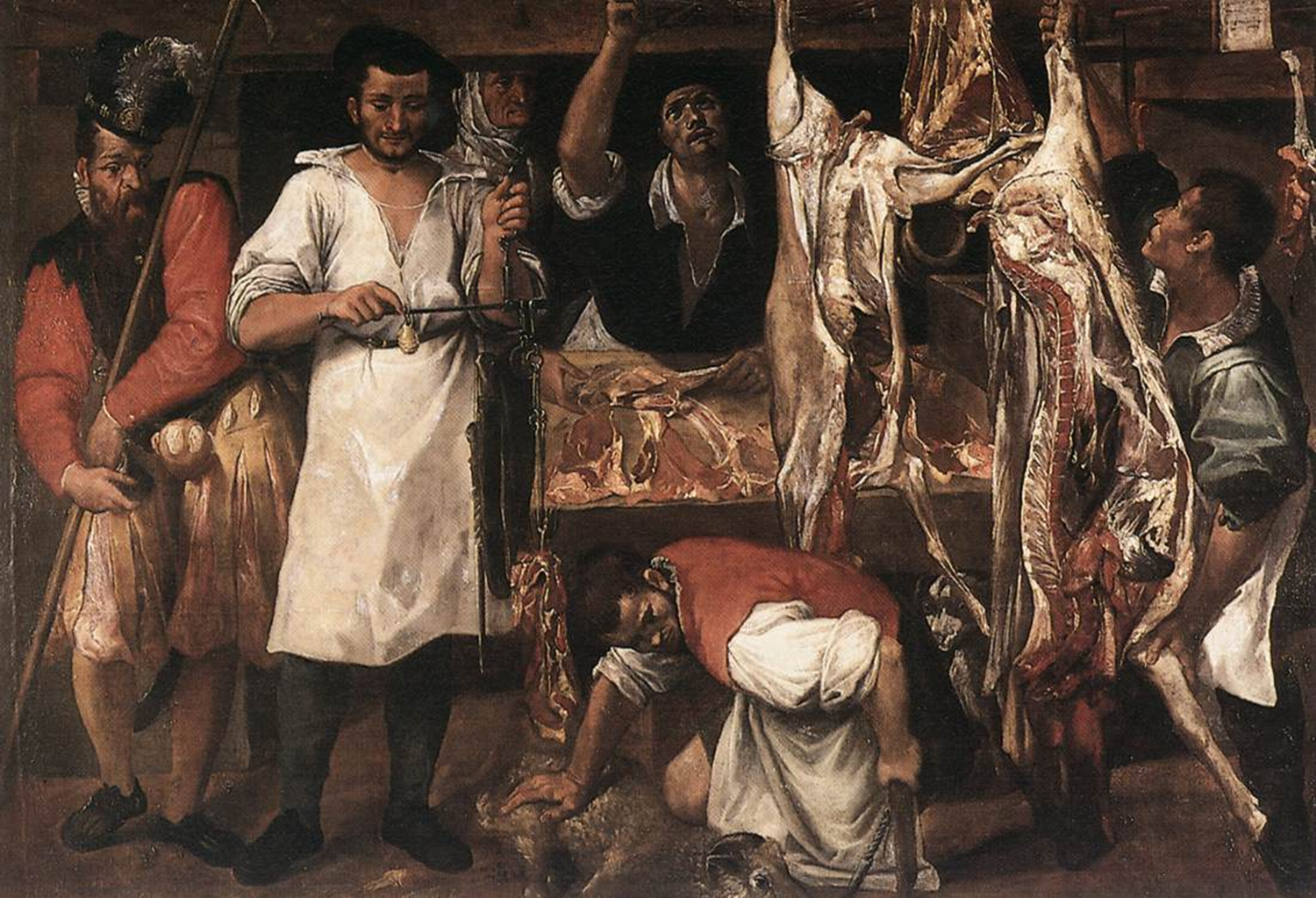
Annibale Carracci
ca. 1580
Period/Movement: Late Renaissance / Early Baroque (Italy, late 16th century)
Original Location: Likely created for a domestic or tavern setting, possibly commissioned by a wealthy patron interested in genre scenes.
Current Location: Christ Church Picture Gallery, Oxford (one version) / Kimbell Art Museum, Texas (another version).
Patron: Uncertain, but possibly commissioned by a merchant or noble interested in contemporary life scenes.
Material/Media/Medium: Oil on canvas
Technique: Bold, expressive brushwork with strong use of chiaroscuro (light and shadow) to enhance realism.
CONTENT (What can you see?)
A detailed and lively depiction of a butcher’s shop filled with meat, workers, and customers.
Several figures are actively engaged in butchering, preparing, and selling meat.
Realistic, sometimes grim details of hanging carcasses, slabs of meat, and butchered animals.
Some figures appear to be portraits, possibly of the Carracci family or local workers.
FORM (Finer details, Elements of Art & Principles of Design)
Line: Strong, dynamic lines lead the viewer’s eye through the composition.
Shape & Proportion: Figures are realistically proportioned, with a focus on anatomical accuracy.
Color: Earthy tones dominate, creating a naturalistic, unidealized representation of daily life.
Value (Light & Shadow): Dramatic contrasts between light and dark add depth and focus to the composition.
Composition: Arranged to capture movement and realism, with overlapping forms creating depth.
Texture: Thick, expressive brushstrokes enhance the rough, tactile nature of the scene.
CONTEXT (Why was this piece created?)
Part of the rise of genre painting, which depicted everyday life rather than religious or mythological subjects.
Created during the Counter-Reformation, a time when art was shifting towards more relatable, human-centered themes.
The Carracci family sought to revive naturalism in art, moving away from the exaggerated Mannerist style.
Could also be a subtle social commentary on class, labor, and the contrast between wealth and manual labor.
FUNCTION (Purpose of the artwork?)
Possibly a decorative piece for a wealthy patron who appreciated scenes of daily life.
May have served as a study of realism, challenging artistic conventions by elevating an ordinary scene into high art.
Could reflect a broader humanist interest in everyday activities and working-class figures.
STYLE (Why does this fit into a particular movement or artist's style?)
Fits within Carracci’s movement towards naturalism, which laid the groundwork for the Baroque period.
Breaks from the idealized, mannered style of the late Renaissance, instead focusing on realism and ordinary people.
Anticipates the Caravaggesque use of stark light contrasts and intense realism.
MEANING (What does this artwork represent?)
Highlights the everyday realities of labor and commerce, a theme rarely depicted in high art at the time.
Could reflect changing attitudes towards work and social class, emphasizing dignity in manual labor.
May serve as a commentary on excess and consumption, contrasting wealth and hardship.
Demonstrates Carracci’s belief that even the most mundane scenes could be elevated through artistic mastery.
Genre scene
A type of painting representing everyday life and ordinary activities, often depicting common people and their environments, developed prominently during the Baroque period.
Crucifixion
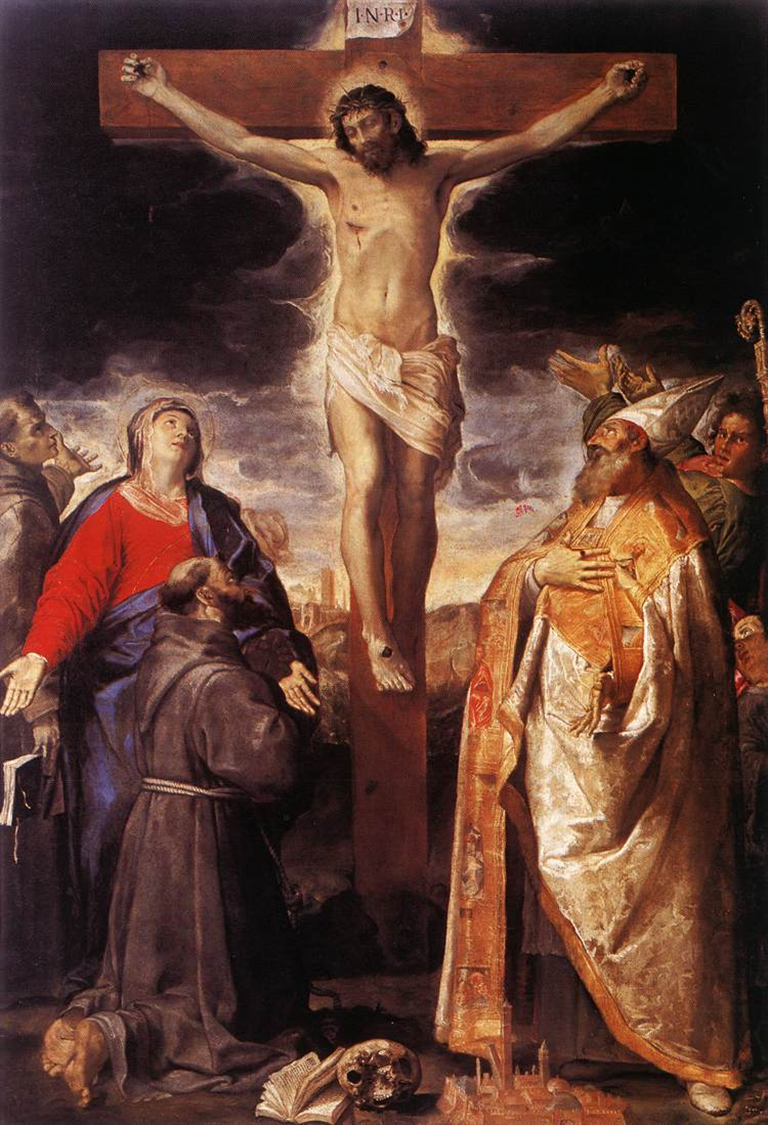
Annibale Carracci
ca. 1583
Period/Movement: Late Renaissance / Early Baroque (Italy, late 16th century)
Original Location: Likely intended for a church altar
Current Location: Santa Maria della Carità, Bologna
Patron: Commissioned for religious devotion, possibly by a church or religious order
Material/Media/Medium: Oil on canvas
Technique: Rich color palette, chiaroscuro, and dramatic composition to enhance emotional impact
CONTENT (What can you see?)
Christ crucified on the cross, surrounded by mourners and possibly angels.
Expressive faces and gestures convey deep sorrow and reverence.
A dramatic sky, emphasizing the moment’s intensity.
FORM (Elements of Art & Principles of Design)
Composition: Strong vertical emphasis on Christ’s body; figures arranged to create depth.
Light & Shadow: Chiaroscuro heightens the sense of divine presence and suffering.
Color: Earthy tones with deep reds and blues enhancing the emotional gravity.
Texture: Smooth rendering of skin, contrasted with rough wooden cross.
CONTEXT (Why was this piece created?)
Part of the Counter-Reformation’s push for emotionally compelling religious imagery.
Reflects Carracci’s shift from Mannerism toward naturalism and deep human emotion.
FUNCTION (Purpose?)
Created for religious devotion and meditation.
Designed to evoke empathy and spiritual reflection in viewers.
STYLE (Why does this fit into a movement?)
Blends Renaissance idealism with early Baroque drama.
Emphasizes naturalism, strong emotion, and dynamic composition, hallmarks of Carracci’s style.
MEANING (What does this represent?)
A powerful expression of Christian sacrifice, redemption, and divine suffering.
Demonstrates Carracci’s ability to convey human emotion in religious art.
Conversion of St. Paul

Ludovico Carracci
1587-89
Period/Movement: Late Renaissance / Early Baroque
Original Location: Likely commissioned for a church setting
Current Location: Pinacoteca di Bologna, Italy
Patron: Unknown, but likely commissioned by a religious institution
Material/Media/Medium: Oil on canvas
Technique: Dramatic lighting, diagonal composition, strong sense of movement
CONTENT (What can you see?)
St. Paul falling from his horse as he experiences a divine vision.
A bright celestial light shining down, illuminating his face.
Soldiers and companions reacting in shock and confusion.
FORM (Elements of Art & Principles of Design)
Composition: Diagonal movement, creating dynamism.
Light & Shadow: Tenebrism (strong contrast between light and dark) enhances drama.
Perspective: Figures positioned at different depths create spatial realism.
Color: Rich earth tones contrast with celestial light.
CONTEXT (Why was this piece created?)
Catholic Church promoted dramatic, emotional religious art during the Counter-Reformation.
Aligns with the Carracci Academy’s emphasis on naturalism and movement.
FUNCTION (Purpose?)
Designed to inspire faith and awe in viewers.
Used as an altarpiece to engage worshippers with the dramatic story of Paul’s conversion.
STYLE (Why does this fit into a movement?)
Early Baroque elements with dramatic movement, emotion, and chiaroscuro.
Demonstrates Ludovico Carracci’s more expressive, theatrical approach to religious scenes.
MEANING (What does this represent?)
Symbolizes spiritual transformation and divine intervention.
Highlights the power of faith to change lives.
Pietà with Virgin and Saints
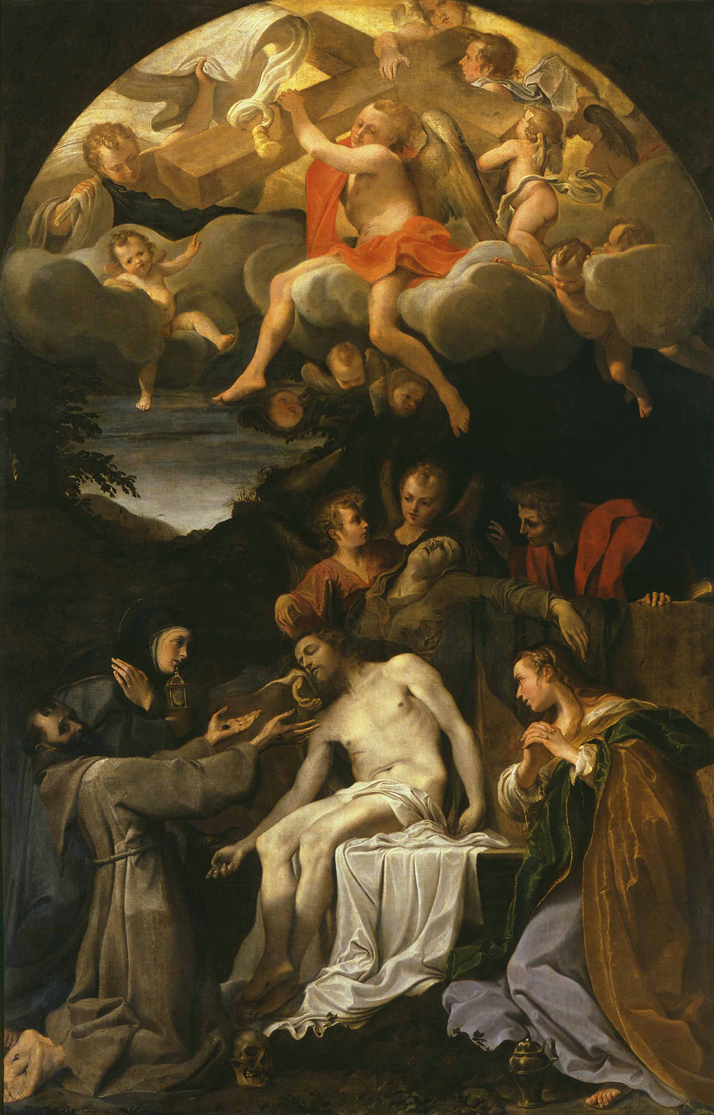
Annibale Carracci
1585
Period/Movement: Late Renaissance / Early Baroque
Original Location: Commissioned for religious devotion, likely for a church.
Current Location: Capodimonte Museum, Naples
Patron: Possibly commissioned by a church or private donor for an altar.
Material/Media/Medium: Oil on canvas
Technique: Soft modeling of figures, delicate use of light, and emotional depth
CONTENT (What can you see?)
The Virgin Mary mourning over Christ’s lifeless body.
Surrounding saints displaying grief and reverence.
A sorrowful yet composed atmosphere, with figures deeply immersed in contemplation.
FORM (Elements of Art & Principles of Design)
Composition: Triangular arrangement creates stability and harmony.
Light & Shadow: Subtle chiaroscuro to enhance form and emotion.
Color: Muted palette with soft blues and earth tones emphasizing grief.
Texture: Smooth blending of tones for a realistic, yet softened effect.
CONTEXT (Why was this piece created?)
Created during the Catholic Church’s Counter-Reformation, which emphasized religious art that evoked emotion and devotion.
Reflects Carracci’s move toward a more naturalistic, emotionally engaging style.
FUNCTION (Purpose?)
Made for religious reflection, likely as an altarpiece.
Designed to inspire empathy and spiritual contemplation.
STYLE (Why does this fit into a movement?)
Blends Renaissance balance with early Baroque emotion.
Less rigid than Mannerist works, showing Carracci’s commitment to realism and natural human expression.
MEANING (What does this represent?)
A meditation on grief, sacrifice, and salvation.
Represents the growing desire for religious art to be deeply personal and engaging.
altarpiece
Work of art that decorates the space above and behind the altar in a Christian church Painting, relief, and sculpture in the round have all been used in altarpieces, either alone or in combination. These artworks usually depict holy personages, saints, and biblical subjects.
eclecticism
The practice of drawing inspiration and elements rom various styles and periods, rather than adhering to a single, unified aesthetic.
sfumato
(Italian for smoked off or blurred) is a technique that creates soft, imperceptible transitions between colors and tones, often blurring edges and contours to achieve a realistic or atmospheric effect
Bargellini Madonna

Ludovico Carracci
1587
Period/Movement: Late Renaissance / Early Baroque
Original Location: Commissioned for the Bargellini family, possibly for a church or chapel in Bologna.
Current Location: Pinacoteca Nazionale, Bologna
Patron: Bargellini family
Material/Media/Medium: Oil on canvas
Technique: Soft, expressive brushwork with dramatic lighting
CONTENT (What can you see?)
The Virgin Mary seated with the Christ Child, surrounded by saints and angels.
A warm, intimate composition with an emphasis on emotional connection.
FORM (Elements of Art & Principles of Design)
Composition: Balanced yet dynamic, with diagonal lines adding movement.
Light & Shadow: Chiaroscuro used to create depth and highlight figures.
Color: Rich, warm tones enhance the divine atmosphere.
CONTEXT (Why was this piece created?)
Reflects Counter-Reformation ideals of accessibility and emotional engagement in religious art.
FUNCTION (Purpose?)
Created for religious devotion, intended to inspire faith and contemplation.
STYLE & MEANING
Early Baroque in its emphasis on naturalism and emotional intensity.
Highlights the Carracci family’s commitment to revitalizing religious art.
Mystic Marriage of St. Catherine
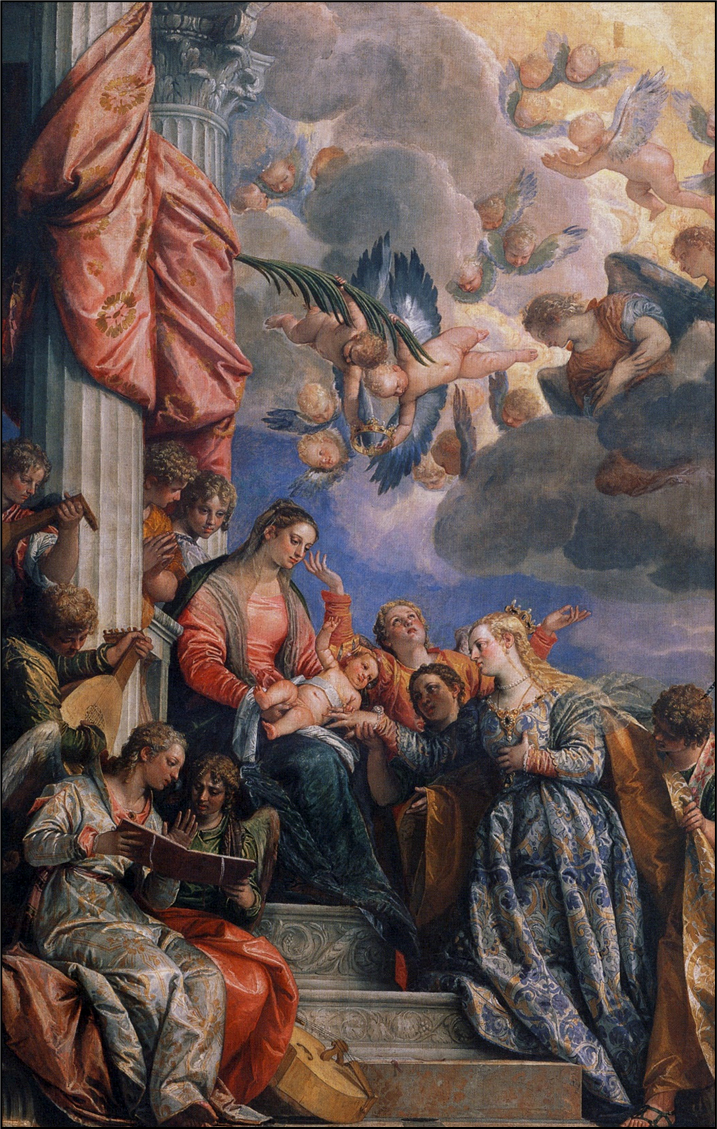
Agostino Carracci
1582
engraving after Veronese
Period/Movement: Late Renaissance
Original Location: Reproduced after Veronese’s painting, intended for broader distribution.
Current Location: Various collections (prints widely distributed).
Patron: Likely a commission to spread Veronese’s imagery.
Material/Media/Medium: Engraving
Technique: Fine linework, hatching, and cross-hatching for shading.
CONTENT
St. Catherine receiving a wedding ring from the Christ Child in a divine vision.
Figures arranged elegantly, with classical drapery and idealized forms.
FORM
Line: Precise, clean engraving lines replicate Veronese’s brushstrokes.
Composition: Symmetrical and harmonious.
CONTEXT & FUNCTION
Reproductions allowed Veronese’s art to reach a wider audience.
Served as a devotional image for those who could not access the original painting.
STYLE & MEANING
Demonstrates Agostino’s skill in translating painterly effects into print.
Reinforces the period’s focus on religious mysticism and divine visions
Madonna with St. Matthew

Annibale Carracci
1588
Period/Movement: Late Renaissance / Early Baroque
Original Location: Likely commissioned for a church in Bologna.
Current Location: Gemäldegalerie, Dresden
Patron: Unknown
Material/Media/Medium: Oil on canvas
Technique: Blends classical composition with naturalistic figures.
CONTENT
The Virgin Mary presenting Christ to St. Matthew.
Warm interaction between the figures, emphasizing a human connection.
FORM
Composition: Pyramid structure with rhythmic movement.
Color: Muted, harmonious tones that enhance the sacred mood.
CONTEXT & FUNCTION
Reflects Counter-Reformation efforts to make religious imagery more accessible.
STYLE & MEANING
Marks Annibale’s transition from Renaissance balance to Baroque drama.
Highlights the role of saints as intermediaries between humans and the divine.
Madonna degli Scalzi
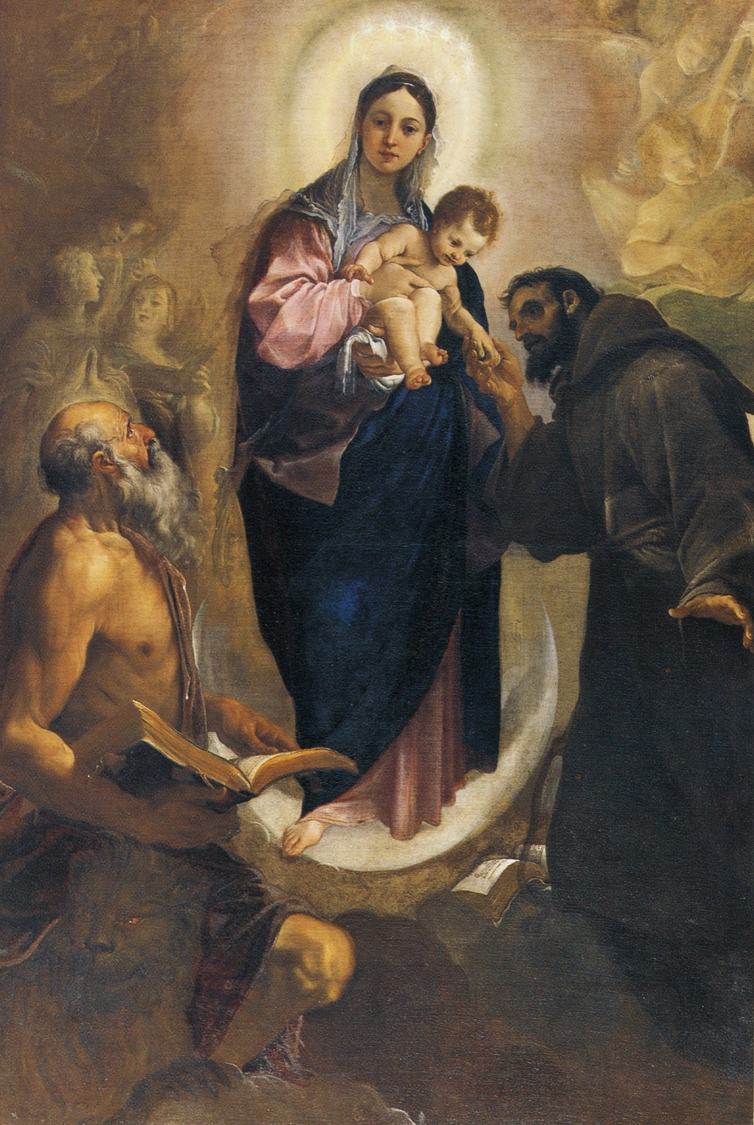
Ludovico Carracci
ca.1590
Period/Movement: Late Renaissance / Early Baroque
Original Location: Church of the Scalzi, Bologna
Current Location: Pinacoteca Nazionale, Bologna
Patron: Religious commission
Material/Media/Medium: Oil on canvas
CONTENT
The Virgin and Christ Child surrounded by angels and saints.
Strong emotional engagement between figures.
FORM
Composition: Dramatic arrangement, with strong vertical emphasis.
Color: Rich, warm tones with deep shadows enhancing contrast.
CONTEXT & FUNCTION
Created to enhance devotion and spiritual contemplation.
STYLE & MEANING
Represents Ludovico’s softer, more expressive approach compared to Annibale.
Emphasizes Baroque dynamism and emotional resonance
Resurrection of Christ
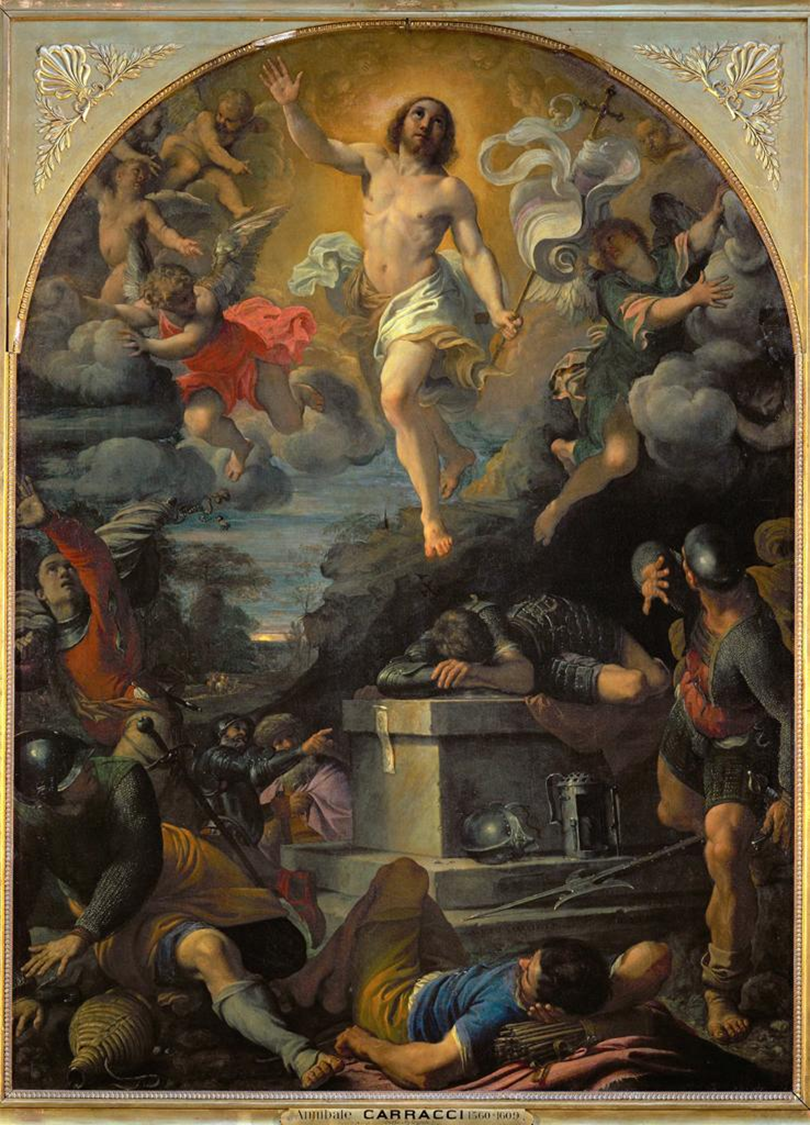
Annibale Carracci
1593
Period/Movement: Early Baroque
Original Location: Commissioned for a church in Bologna.
Current Location: Louvre Museum, Paris
Patron: Religious commission
Material/Media/Medium: Oil on canvas
CONTENT
Christ triumphantly rising from the tomb, surrounded by amazed soldiers.
Dynamic movement with Christ as the focal point.
FORM
Composition: Dramatic upward movement enhances divine ascension.
Light & Shadow: Bright divine light contrasts with dark surroundings.
CONTEXT & FUNCTION
Counter-Reformation emphasis on victory over death and faith in Christ.
STYLE & MEANING
Annibale blends Michelangelo’s muscular figures with Baroque drama.
Symbolizes Christian hope and divine power.
Story of the Founding of Rome
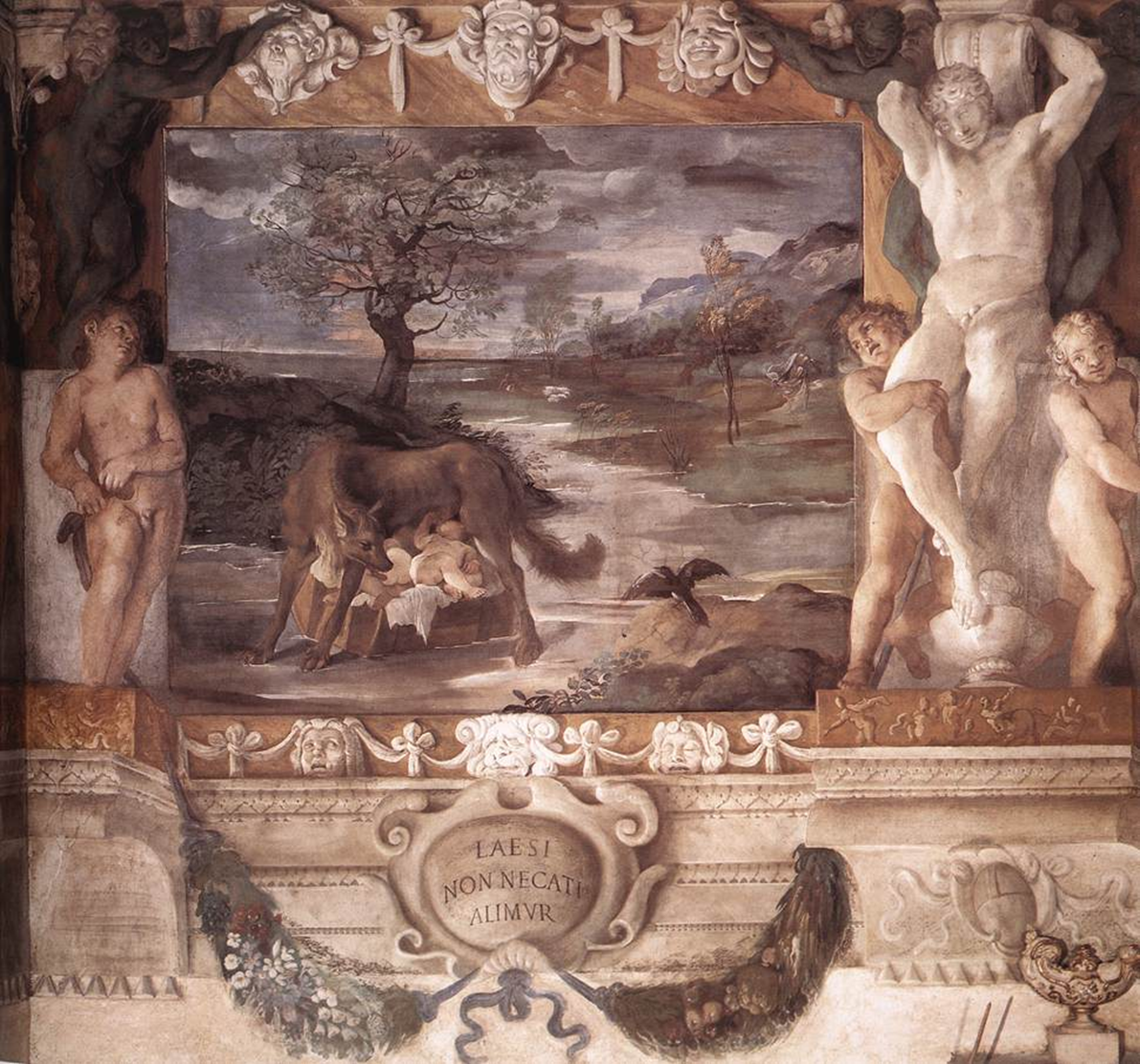
Ludovico Carracci
detail of Romulus and Remus
ca.1590
Palazzo Magnani, Bologna
Period/Movement: Early Baroque
Original Location: Palazzo Magnani, Bologna
Current Location: Palazzo Magnani, Bologna
Patron: Magnani family
Material/Media/Medium: Fresco
CONTENT
Depicts the myth of Romulus and Remus, raised by the she-wolf.
Features dynamic poses and expressive figures.
FORM
Composition: Balanced yet full of movement.
Color: Earthy tones enhance realism.
CONTEXT & FUNCTION
Created to celebrate Bologna’s connection to Roman heritage.
STYLE & MEANING
A fusion of mythological grandeur with early Baroque naturalism.
Highlights Rome’s legendary origins and Ludovico’s storytelling ability.
Lorenzo Magnani
Known for restoring family status of senators subject reflects elevation justified by millennia of distinguished ancestry (all 3 Carracci participated)
herms
A type of sculpture typically a square pillar topped with a bust or head, often representing Hermes or Mercury and frequently featuring male genitalia. They served as protective images boundary markers, and later, decorative elements.
Hercules at the Crossroads
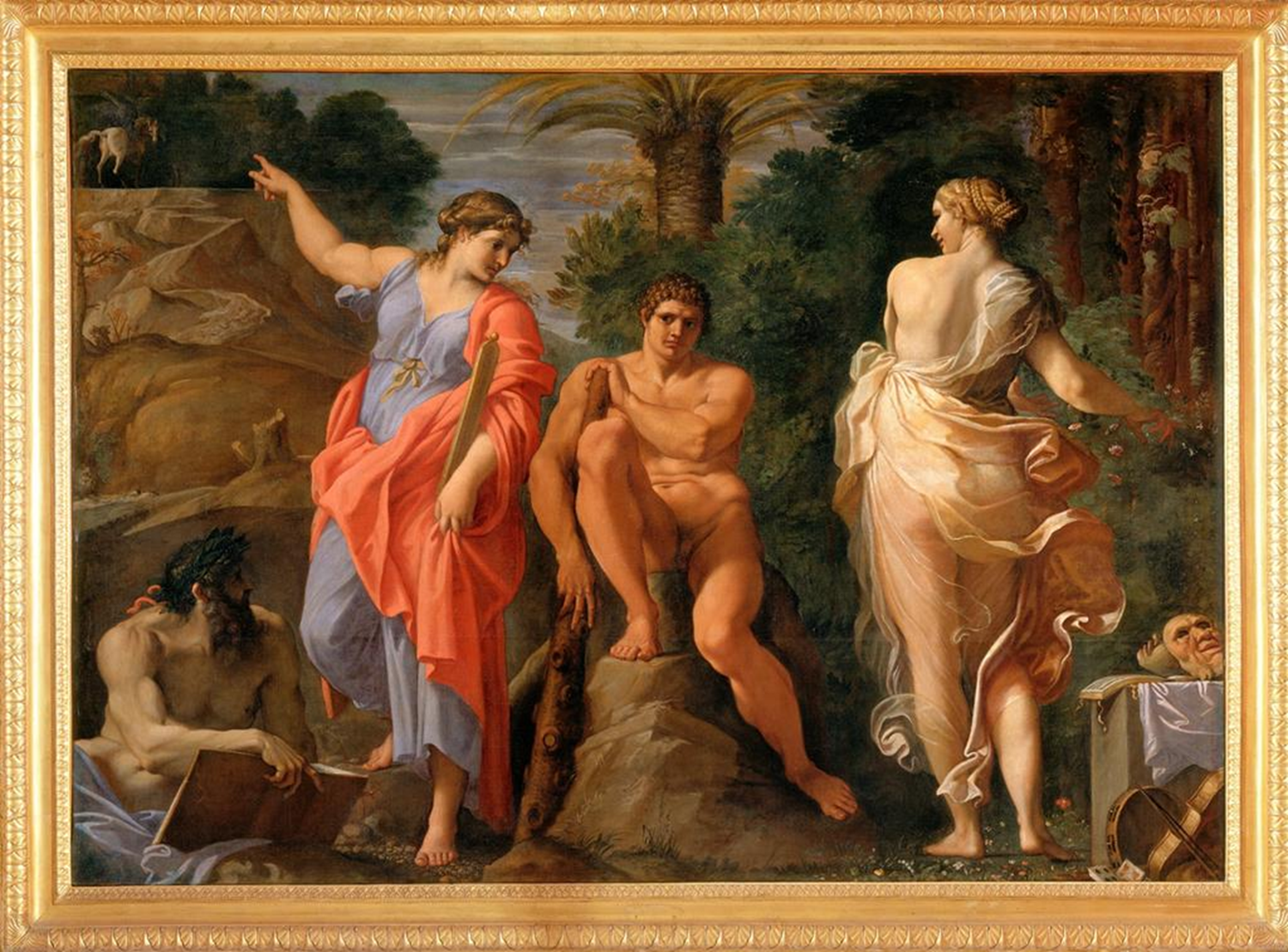
Annibale Carracci
1597
Period/Movement: Baroque
Original Location: Commissioned for Cardinal Odoardo Farnese, Rome
Current Location: Museo di Capodimonte, Naples
Patron: Cardinal Odoardo Farnese
Material/Media/Medium: Oil on canvas
Technique: Classical composition with strong naturalism
CONTENT
Hercules stands at a crossroads, choosing between the path of Virtue (austere, challenging) and the path of Vice (pleasure, ease).
FORM
Composition: Balanced yet dynamic, with diagonal lines adding movement.
Color: Warm tones for Vice, cooler tones for Virtue.
CONTEXT & FUNCTION
Reflects Neoplatonic ideals and moral allegory common in the Renaissance and Baroque.
Serves as a philosophical lesson about moral choices.
STYLE & MEANING
Blends Renaissance classicism with Baroque energy.
Influenced by Michelangelo's muscular figures.
Program
Subjects related to heroic struggle as model for young cardinal. The catholic Church’s intentional use of art as a tool to reinspire faith and counter the Protestant Reformation aiming to create dramatic and emotional works that would appeal to the senses and inspire devotion.
Classicism
A style that blends the grandeur and drama of the Baroque period with the clarity, order and principles of Classical art, emphasizing expression and dynamic movement while adhering to classical principles of symmetry, proportion, and harmony.
Cardinal Odoardo Farnese
A noted patron, commissioned Annibale Carracci to fresco the ceiling of the Palazzo Farnese’s gallery depicting The Loves of the Gods and establishing the qudro riportati technique.
Galleria of the Palazzo Farnese (Farnese Gallery)

Annibale Carracci
1597-1601
Period/Movement: Baroque
Original Location: Palazzo Farnese, Rome
Current Location: Palazzo Farnese, Rome
Patron: Cardinal Odoardo Farnese
Material/Media/Medium: Fresco
Technique: Quadratura (illusionistic ceiling painting)
CONTENT
A grand ceiling fresco celebrating love, mythology, and classical themes, inspired by Michelangelo's Sistine Chapel.
Includes narrative panels framed with painted architecture.
FORM
Illusionistic perspective: Creates depth through trompe-l'œil.
Color: Vibrant, dynamic contrasts emphasizing movement.
CONTEXT & FUNCTION
Commissioned to glorify the Farnese family and its connection to classical antiquity.
STYLE & MEANING
Marks the birth of Baroque ceiling painting.
Inspired by Raphael and Michelangelo but with a more dynamic, theatrical composition.
Idea della Bellezza
the idea of beauty or the concept of beauty
Ovid, Metamorphoses
A collection of mythological tales about transformations, served as a rich source of inspiration for Baroque artists, who drew upon its themes of change, desire and the relationship between mortals and gods.
Triumph of Bacchus and Ariadne
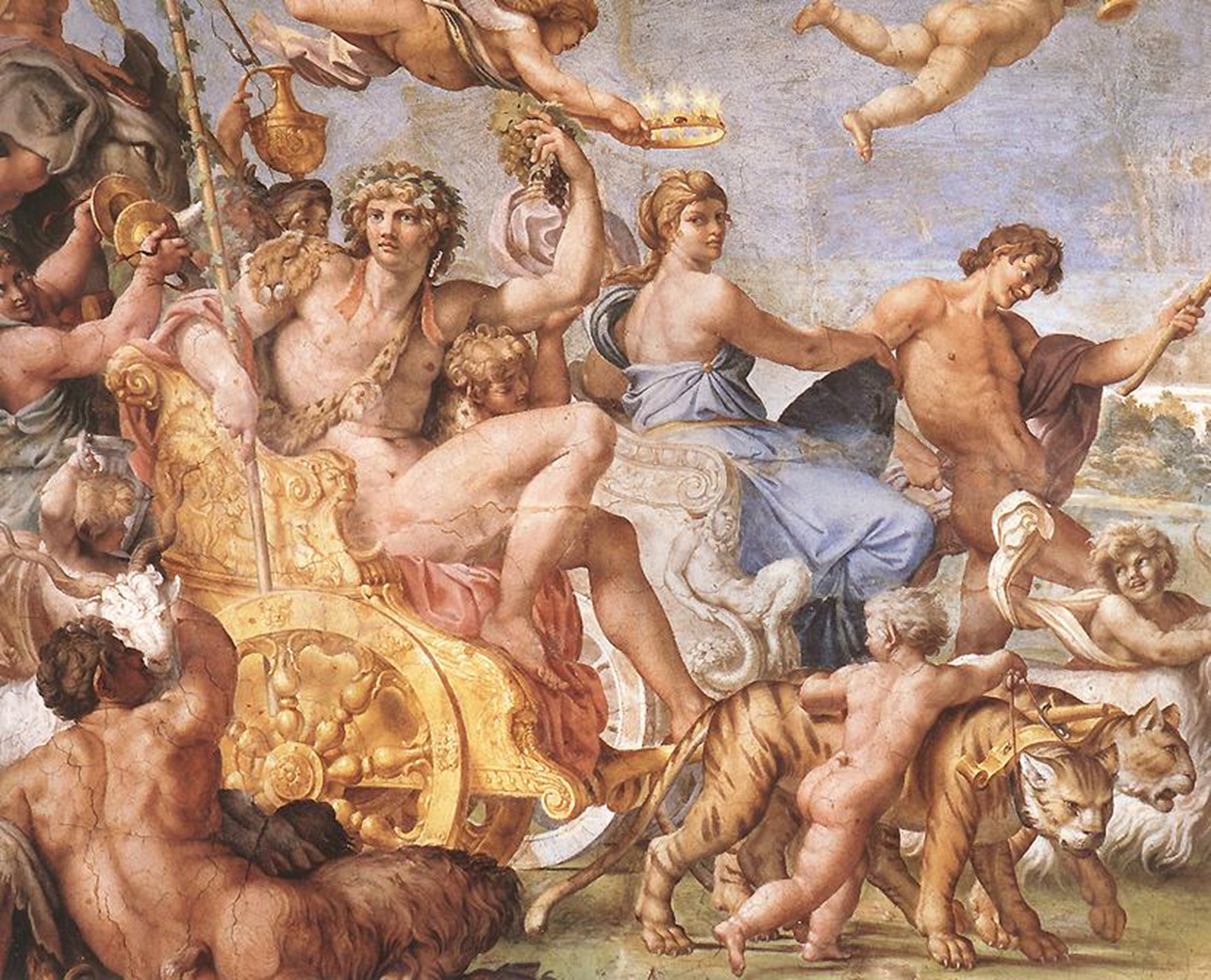
Annibale Carracci
1597-1601
Period/Movement: Baroque
Original Location: Palazzo Farnese, Rome
Current Location: Palazzo Farnese, Rome
Patron: Cardinal Odoardo Farnese
Material/Media/Medium: Fresco
CONTENT
Bacchus, the god of wine, leads a procession celebrating his love for Ariadne, with satyrs, nymphs, and mythological figures.
FORM
Dynamic movement in twisting figures.
Color: Rich, warm palette creating a sense of celebration.
CONTEXT & FUNCTION
Highlights themes of love, transformation, and divine union, fitting aristocratic tastes.
STYLE & MEANING
Inspired by ancient Roman frescoes and Titian’s Venetian colorism.
Amor Vincit Omnia
Latin phrase meaning love conquers all said Roman poet Virgil
quadro riportato
Describes a painted ceiling design that mimics the appearance of framed easel paintings hung overhead.
bacchanal
Depicts wild, drunken revelry honoring Bacchus (Roman god of wine) or Dionysus (Greek god of wine, fertility and ecstasy) often featuring revelers, satyrs and Bacchus himself in an idyllic landscape.
Jupiter and Juno
Annibale Carracci
1597-1601
Period/Movement: Baroque
Original Location: Palazzo Farnese, Rome
Current Location: Palazzo Farnese, Rome
Patron: Cardinal Odoardo Farnese
Material/Media/Medium: Fresco
CONTENT
Depicts Jupiter and Juno’s divine relationship, with Juno reproaching Jupiter.
FORM
Expressive gestures convey emotion.
Rich colors highlight divine presence.
CONTEXT & FUNCTION
Represents themes of power and marriage, appealing to elite patrons.
STYLE & MEANING
Merges Renaissance idealism with Baroque drama.
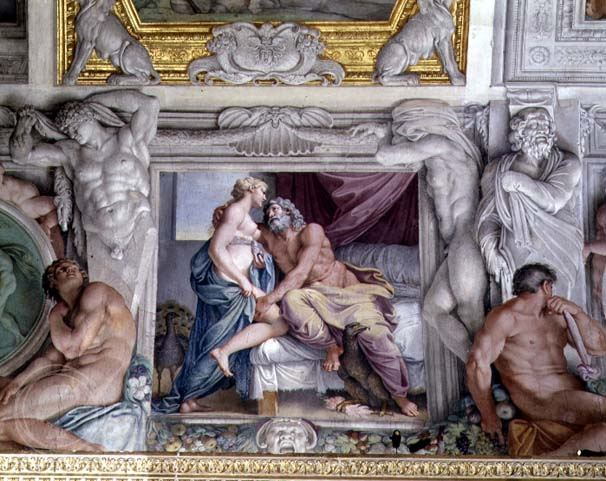
Hyper-classical
Something that is beyond or excessively classical, often implying a heightened or exaggerated adherence to classical standards or principles.
Polyphemus Innamorato
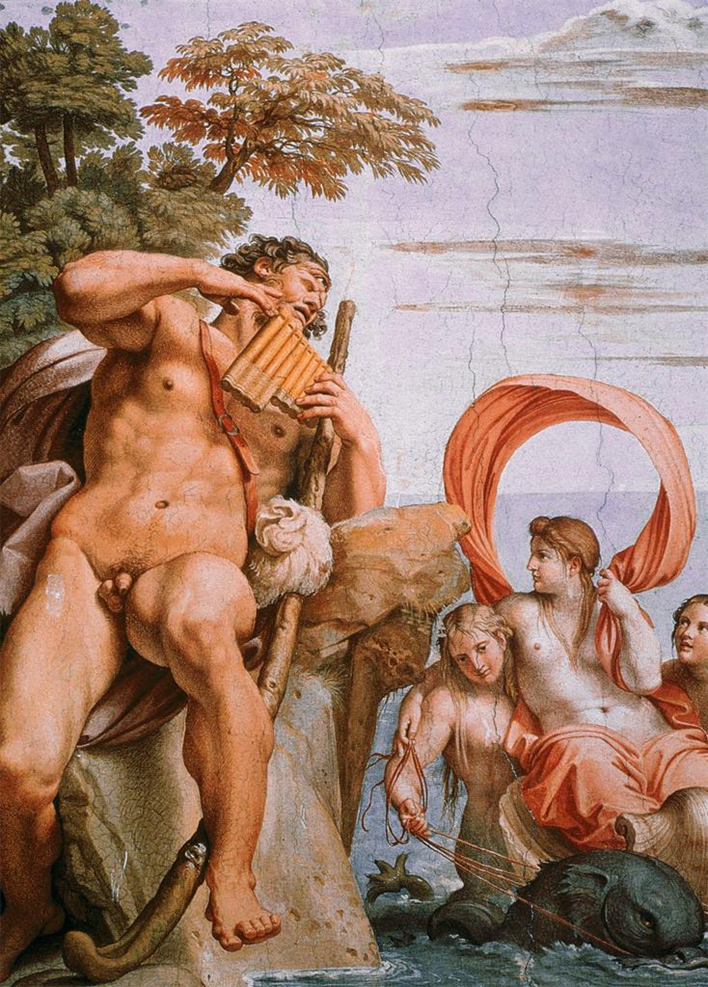
Annibale Crracci
1597-1601
Period/Movement: Baroque
Original Location: Palazzo Farnese, Rome
Current Location: Palazzo Farnese, Rome
Patron: Cardinal Odoardo Farnese
Material/Media/Medium: Fresco
CONTENT
Polyphemus Innamorato: Shows Polyphemus serenading Galatea, in a tender scene.
Polyphemus Furioso: The jealous giant hurls a rock at Acis, turning him into a river.
FORM
Innamorato is soft, dreamy, while Furioso is violent and chaotic.
CONTEXT & FUNCTION
Contrasts love’s gentle side and its destructive force.
STYLE & MEANING
A dramatic example of Baroque storytelling through contrast.
Homer, Odyssey
Explores the themes of homecoming identity and the human struggle against adversity and its depiction in baroque art often emphasizes the dramatic and emotional journeys of Odysseus with artist using powerful imagery and grand compositions to capture the epic’s grandeur.
Polyphemus Furioso
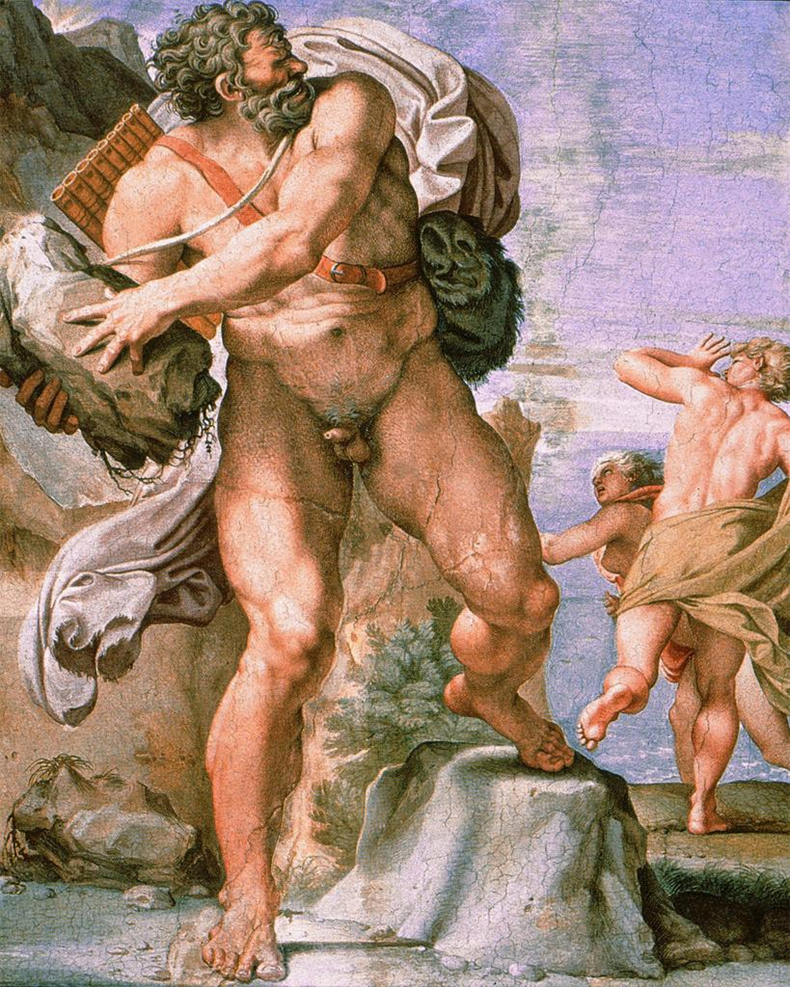
Annibale Carracci
1597-1601
Period/Movement: Baroque
Original Location: Palazzo Farnese, Rome
Current Location: Palazzo Farnese, Rome
Patron: Cardinal Odoardo Farnese
Material/Media/Medium: Fresco
CONTENT
Polyphemus Innamorato: Shows Polyphemus serenading Galatea, in a tender scene.
Polyphemus Furioso: The jealous giant hurls a rock at Acis, turning him into a river.
FORM
Innamorato is soft, dreamy, while Furioso is violent and chaotic.
CONTEXT & FUNCTION
Contrasts love’s gentle side and its destructive force.
STYLE & MEANING
A dramatic example of Baroque storytelling through contrast.
Assumption of the Virgin
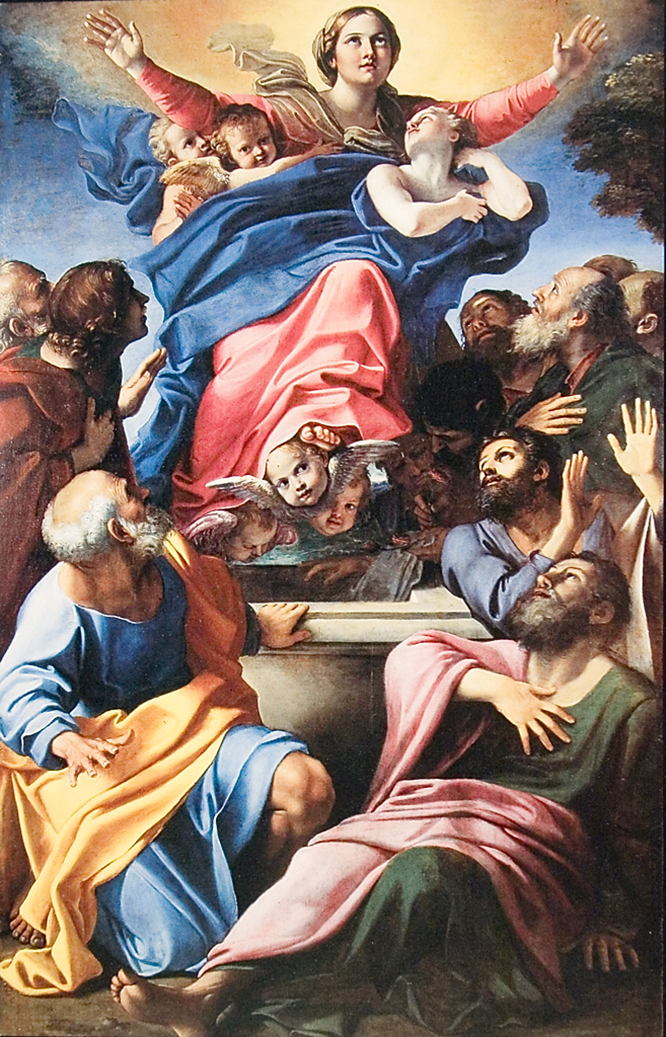
Annibale Carracci
1599
Period/Movement: Baroque
Original Location: Church of Santa Maria del Popolo, Rome
Current Location: Same location
Patron: Religious commission
Material/Media/Medium: Oil on canvas
CONTENT
The Virgin rises to heaven, surrounded by angels and apostles below.
FORM
Upward movement leads viewer’s gaze toward divine ascension.
CONTEXT & FUNCTION
Reflects Counter-Reformation focus on Marian devotion.
STYLE & MEANING
Blends Raphael’s harmony with Baroque dynamism.
Tiberio Cerasi
Was an Italian patron of the arts, best known for commissioning two famous Baroque paintings for his chapel in Santa Maria del Popolo in Rome: The Crucifixion of Saint Peter by Caravaggio and The Conversion of Saint Paul by Caravaggio. He also commissioned an altarpiece, The Assumption of the Virgin, by Annibale Carracci.
Cerasi's commissions are significant in Baroque art because they embody the movement’s dramatic intensity, emotional realism, and dynamic compositions. The Baroque period (late 16th–18th centuries) was marked by theatricality, strong contrasts of light and shadow (chiaroscuro), and a sense of movement, all of which are seen in Caravaggio’s works.
Pieta
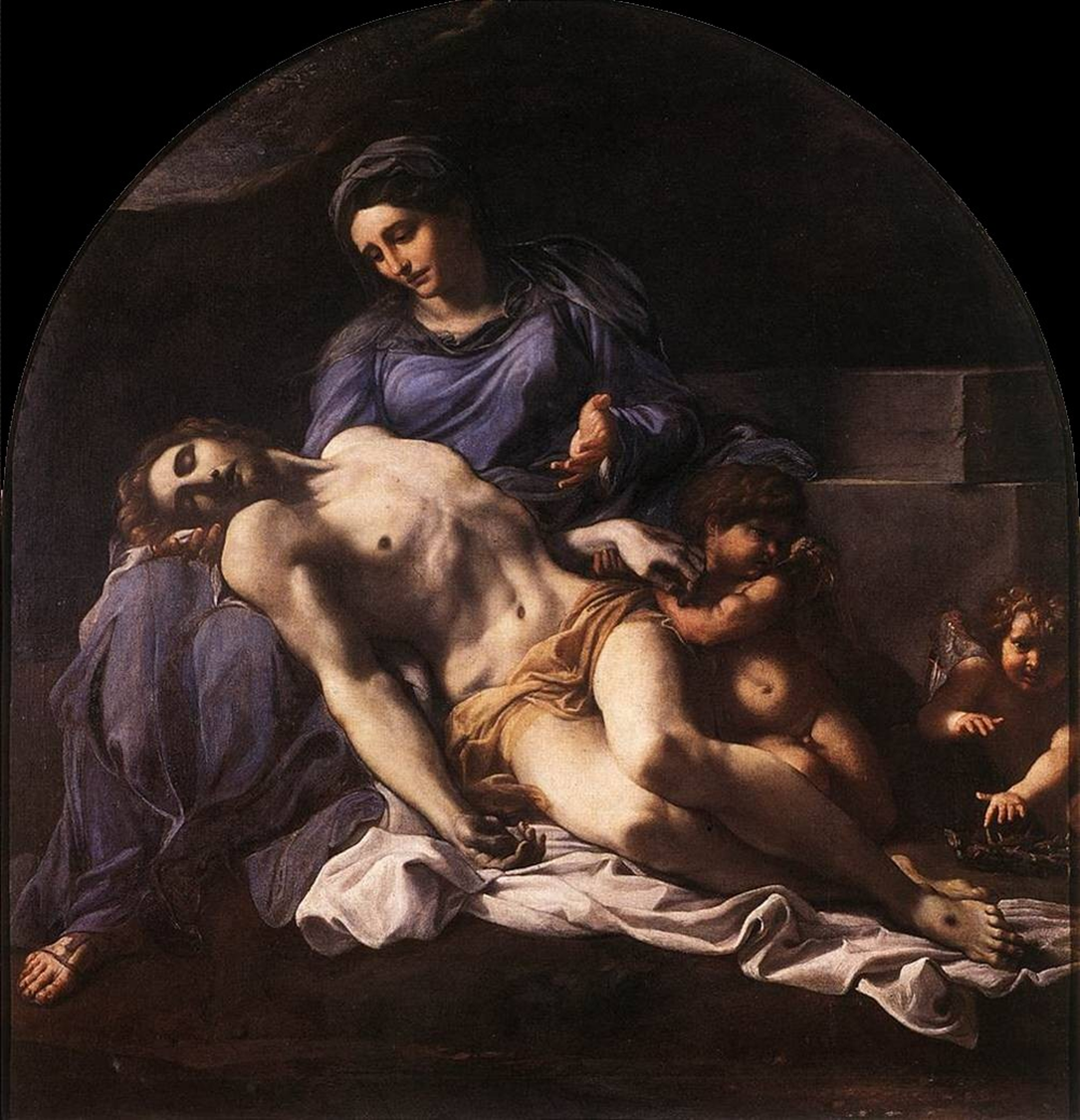
Annibale Carracci
ca. 1599-1600
Period/Movement: Baroque
Original Location: Unknown (likely commissioned for private devotion or a church)
Current Location: Museo di Capodimonte, Naples
Patron: Unknown (possibly a religious commission)
Material/Media/Medium: Oil on canvas
Technique: Highly naturalistic rendering, dramatic use of chiaroscuro
CONTENT
Depicts the Virgin Mary mourning over the lifeless body of Christ.
Christ’s body rests on a white shroud, held by Mary and an angel.
John the Evangelist and another angel stand in sorrow.
The background is dark, emphasizing the emotional weight of the scene.
FORM
Composition: Pyramid-like arrangement, drawing attention to Christ.
Color: Cool, subdued tones heighten the tragic mood.
Lighting: Strong contrasts (chiaroscuro) create depth and highlight the figures’ suffering.
Brushwork: Smooth and refined, enhancing the realism of the figures.
CONTEXT & FUNCTION
Created during the Counter-Reformation, a period when religious art aimed to evoke deep spiritual emotion.
The theme of Christ’s sacrifice and Mary’s sorrow was central to Catholic devotion.
STYLE & MEANING
Reflects Raphael’s influence in composition but with the dramatic emotional intensity of the Baroque.
Inspired later Baroque artists like Guido Reni and Caravaggio.
The work emphasizes human suffering and divine redemption, inviting contemplation.
Paragone
Refers to the debates and discussions about he relative merits and capabilities of different art forms, particularly painting and sculpture and to a lesser extant architecture in context to the Renaissance and Baroque art.
Classical landscape
Refers to landscapes inspired by idealized, harmonious and timeless beauty of classical antiquity.
The Flight into Egypt
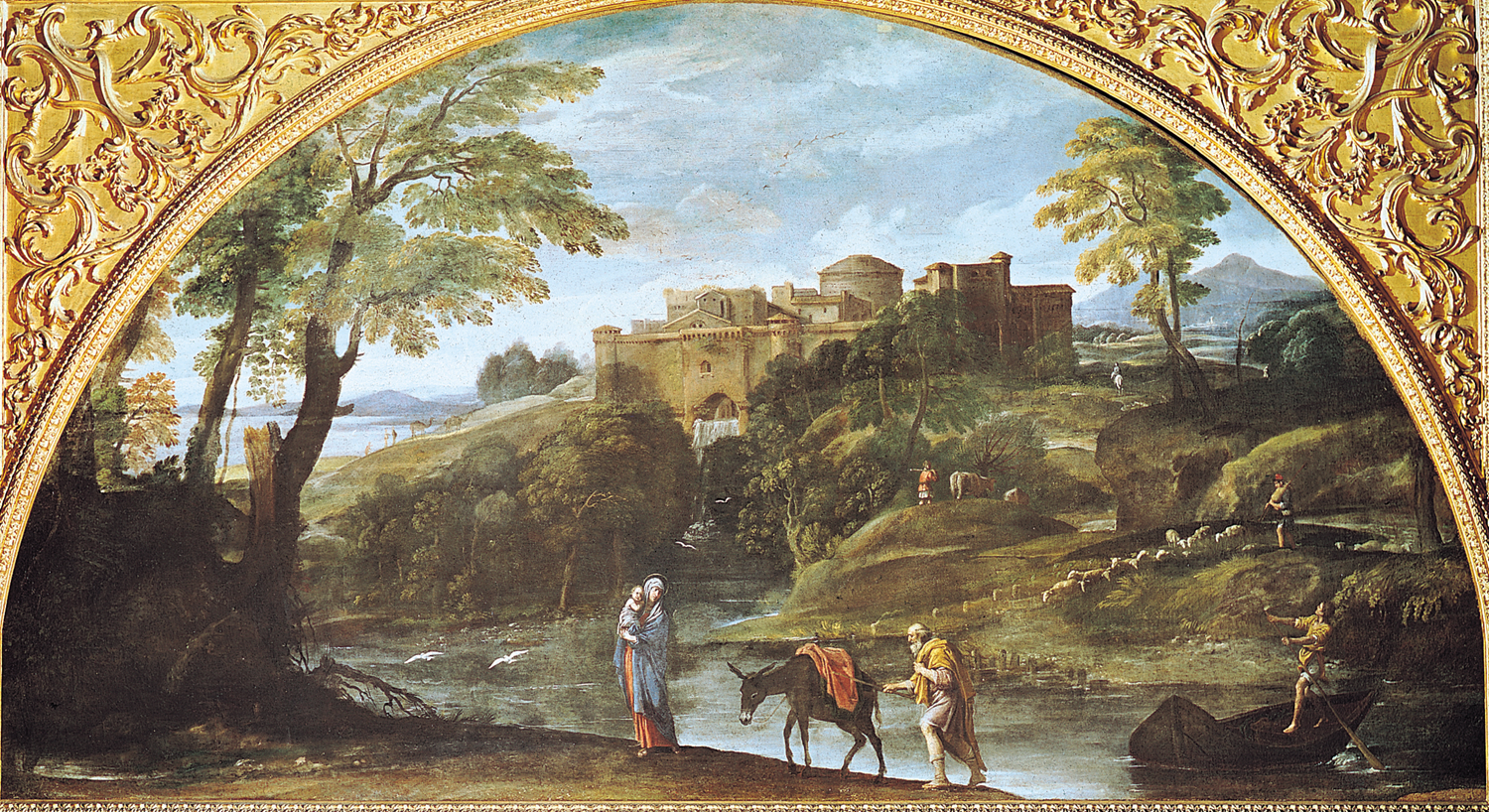
Annibale Carracci
1603-04
Period/Movement: Baroque (Early Baroque Classicism)
Original Location: Commissioned for the Aldobrandini Chapel, Santa Maria in Aracoeli, Rome
Current Location: Galleria Doria Pamphilj, Rome
Patron: Cardinal Pietro Aldobrandini
Material/Media/Medium: Oil on canvas
Technique: Balanced composition, atmospheric perspective, classical landscape painting
CONTENT
Depicts the Holy Family (Mary, Joseph, and the infant Jesus) journeying through a vast landscape as they flee King Herod’s persecution.
The figures are small, blending harmoniously with the surrounding nature.
A serene, idealized countryside stretches in the background, bathed in soft, golden light.
FORM
Composition: Carefully structured, with trees framing the scene and leading the eye toward the vanishing point.
Color: Soft, natural hues create a tranquil atmosphere.
Lighting: Gentle and diffused, enhancing the idyllic feel.
Perspective: Atmospheric perspective adds depth, making the distant landscape appear hazy.
CONTEXT & FUNCTION
Reflects the Baroque interest in landscapes as spiritual settings, influenced by classical ideals.
The work was meant to inspire devotion while also serving as an example of elevated landscape painting.
Part of a series of paintings for the Aldobrandini Chapel, emphasizing divine intervention and protection.
STYLE & MEANING
Marks the beginning of the idealized classical landscape tradition, influencing artists like Claude Lorrain and Nicolas Poussin.
Unlike the more dramatic, intense Baroque works, Carracci’s landscape is calm and structured, emphasizing divine harmony rather than theatrical emotion.
Highlights the connection between the divine and the natural world, a theme that would become central in Baroque landscape painting.
Contado
Refers to the rural area or countryside surrounding a city often under the city’s control
Simone Peterzano
1584-1588 Caravaggio trained under Simone Peterzano “pupil of Titian”
Basket of Fruit

Caravaggio
1597
Period/Movement: Baroque (Naturalism)
Original Location: Unknown
Current Location: Biblioteca Ambrosiana, Milan
Patron: Cardinal Federico Borromeo
Material/Media/Medium: Oil on canvas
Technique: Chiaroscuro, extreme realism, still life
CONTENT
A meticulously painted basket of fruit sits on a ledge against a neutral background.
The fruit is not idealized—some pieces show signs of decay, with withered leaves and blemishes.
Includes grapes, apples, pears, figs, and quinces, detailed with lifelike textures and imperfections.
FORM
Composition: Simple yet striking—a single focal point emphasizing the fruit.
Color: Warm, natural tones; contrast between light and shadow (chiaroscuro).
Lighting: Strong directional light from the left highlights textures.
Perspective: The basket appears slightly unstable, as if about to fall forward, engaging the viewer.
CONTEXT & FUNCTION
One of the earliest independent still life paintings in Western art.
Painted during the Counter-Reformation, aligning with the Catholic Church’s emphasis on realism and moral reflection.
Possible memento mori (reminder of mortality)—the decaying fruit suggests the impermanence of life.
STYLE & MEANING
Shows Caravaggio’s signature naturalism, rejecting idealized beauty in favor of gritty realism.
An innovative take on still life, influencing later Baroque artists like Zurbarán and Velázquez.
Symbolic interpretation: Could represent Christian themes of life’s fragility, the fall of man, and redemption.
alla prima
A painting technique where wet paint is applied to wet paint often in a single sitting resulting in a direct, expressive and spontaneous style.
vanitas
A genre of art particularly still-life painting that uses symbolic objects to represent the transience of life, the futility of earthly pleasures and the inevitability of death, prompting reflection on mortality.
Cardinal Francesco Maria del Monte
Collect artist and specialized in genre scenes: half-length figures with table in foreground and blank background.
Cardsharps
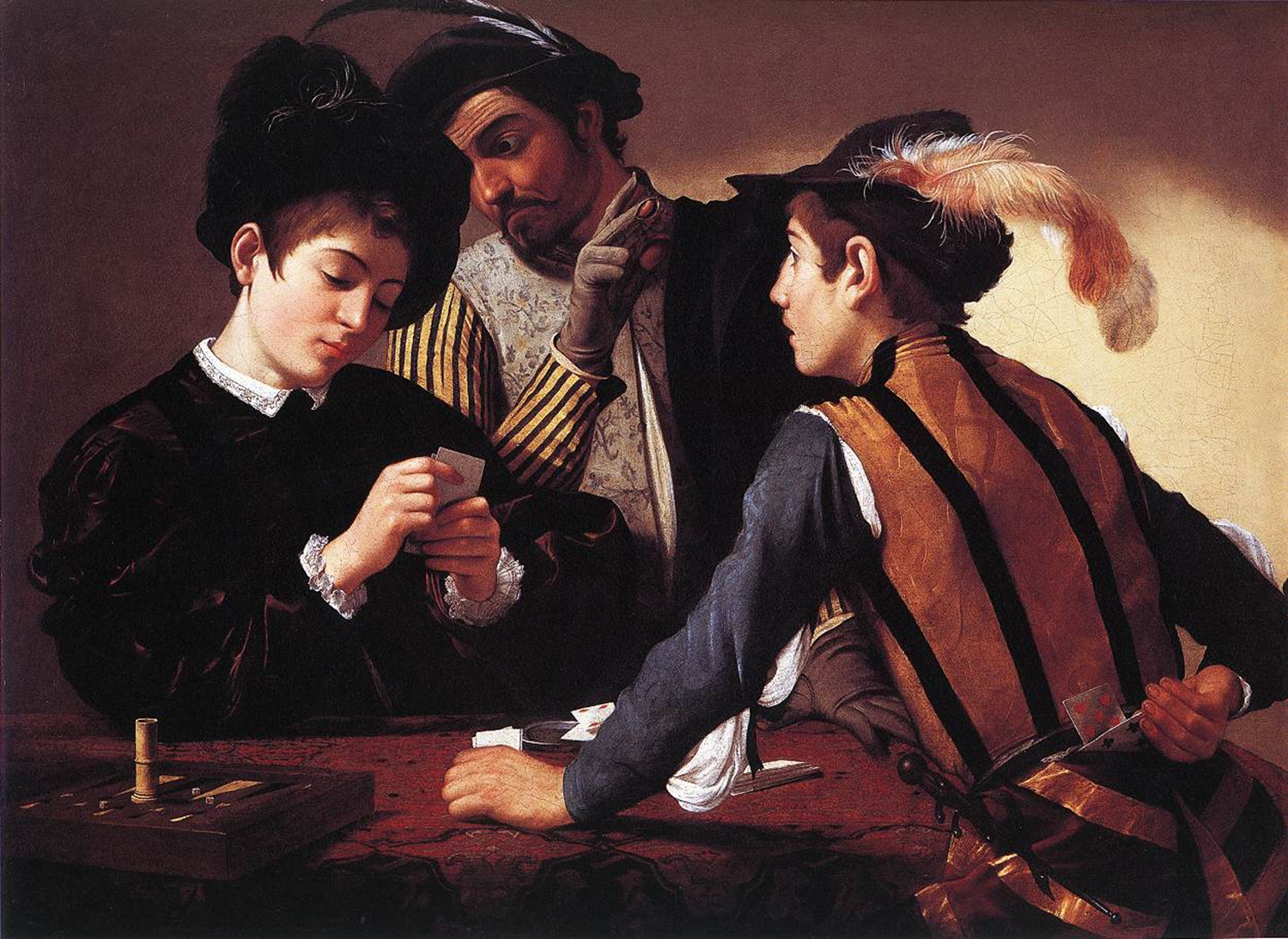
Caravaggio
ca. 1594
Period/Movement: Baroque (Naturalism)
Original Location: Unknown
Current Location: Kimbell Art Museum, Fort Worth, Texas
Patron: Possibly Cardinal Francesco Maria Del Monte
Material/Media/Medium: Oil on canvas
Technique: Chiaroscuro, dramatic realism, psychological tension
CONTENT
Depicts a young, naive nobleman engaged in a game of cards, unaware that he is being cheated.
Two dishonest cardsharps (one older and one younger) conspire against him.
The older cheat signals the younger one, who pulls out a hidden card from his belt.
The boy's elegant clothing contrasts with the rough attire of the swindlers, emphasizing social differences.
FORM
Composition: Asymmetrical and dynamic, leading the viewer’s eye through the deceitful interaction.
Color: Warm and natural tones, with subtle contrasts highlighting the figures.
Lighting: Strong chiaroscuro, creating depth and tension.
Perspective: Tight framing, drawing the viewer into the scene.
CONTEXT & FUNCTION
One of Caravaggio’s early genre paintings, bringing realism and psychological drama to everyday life.
The Counter-Reformation favored moralistic themes, warning against deception and vice.
Possibly an allegory of innocence vs. corruption, showing the dangers of the world.
STYLE & MEANING
Marks Caravaggio’s break from traditional Renaissance idealism, favoring raw, emotional realism.
Influenced later Baroque artists, especially in the use of dramatic lighting and narrative storytelling.
Shows Caravaggio’s fascination with human behavior, foreshadowing his later religious works.
Bacchus
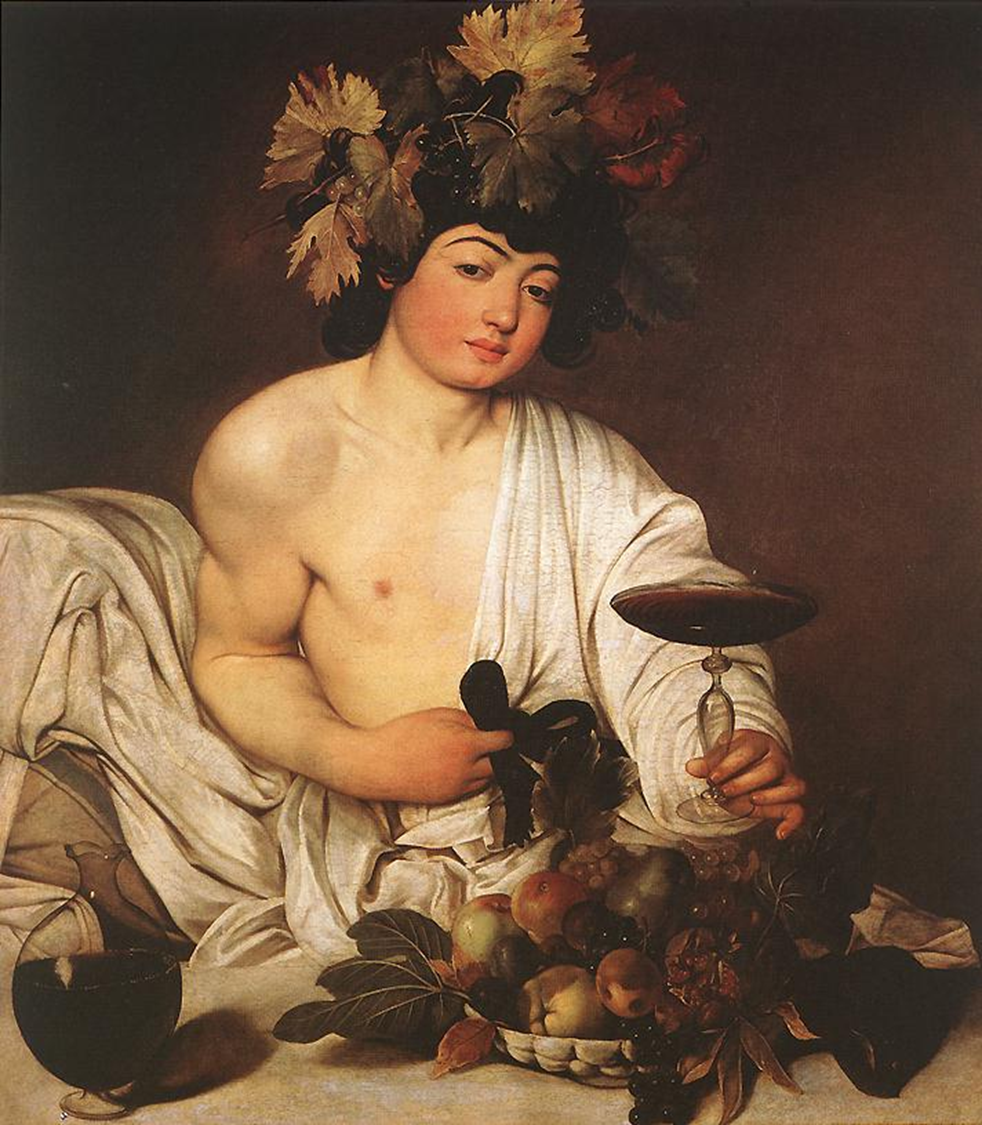
Caravaggio
1595-96
Period/Movement: Baroque (Naturalism)
Original Location: Likely commissioned for Cardinal Francesco Maria Del Monte’s collection
Current Location: Uffizi Gallery, Florence
Patron: Cardinal Francesco Maria Del Monte
Material/Media/Medium: Oil on canvas
Technique: Chiaroscuro, detailed naturalism, Venetian color influences
CONTENT
Depicts Bacchus, the Roman god of wine, in a sensual and humanized manner.
He is reclining on a couch, wearing a loose, draped toga, with a crown of grape leaves on his head.
Holds a shallow glass of wine, seemingly offering it to the viewer.
A bowl of ripe fruit, some decaying, sits in the foreground—perhaps an allusion to the transience of pleasure and life.
His slightly flushed cheeks and suggestive expression hint at intoxication and indulgence.
FORM
Composition: Simple, focused on Bacchus, with a strong triangular structure.
Color: Warm, natural tones; rich reds, browns, and golden hues add to the sense of physicality.
Lighting: Strong chiaroscuro creates depth, making Bacchus almost emerge from the dark background.
Perspective: The tilted wine glass and gaze directly engage the viewer, inviting participation.
CONTEXT & FUNCTION
Caravaggio’s work was created during the Counter-Reformation, yet Bacchus is secular, not religious—showing the influence of classical themes in elite circles.
The erotic and inviting nature of Bacchus may have been meant to entertain and provoke.
The inclusion of overripe fruit suggests the fleeting nature of youth and pleasure (a subtle memento mori).
Reflects Caravaggio’s mastery of naturalism, moving away from the traditional idealized depictions of gods.
STYLE & MEANING
Unlike classical or Renaissance depictions of Bacchus, Caravaggio presents him as a real, human figure, not an idealized deity.
His use of realism and psychological depth makes the painting feel intimate and modern.
Influences later Baroque artists, especially in the way it blends sensuality and naturalism.
castrato
A male singer who underwent castration before puberty to preserve their high, soprano or alto-like voice.
The Lute Player
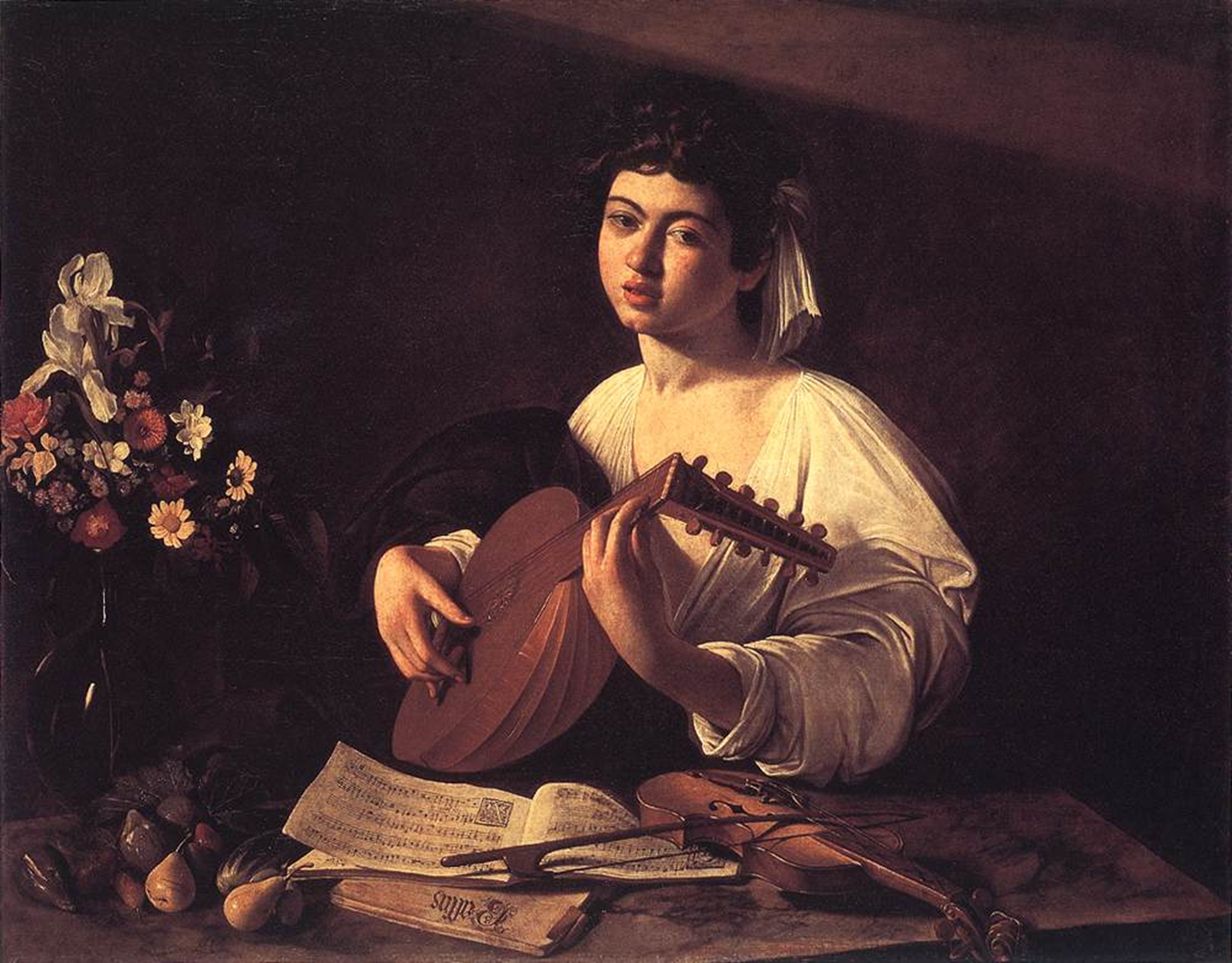
Caravaggio
ca. 1596
Period/Movement: Baroque (Naturalism)
Original Location: Commissioned for Cardinal Francesco Maria Del Monte’s private collection
Current Locations:
Hermitage Museum, St. Petersburg (Version 1)
Metropolitan Museum of Art, New York (Version 2)
Badminton House, Gloucestershire (Possibly a third version)
Patron: Cardinal Francesco Maria Del Monte
Material/Media/Medium: Oil on canvas
Technique: Chiaroscuro, detailed naturalism, Venetian color influence
CONTENT
A young musician, dressed in fine clothing, plays a lute, looking downward in concentration.
The still life arrangement includes a violin, sheet music, and a delicate glass vase with flowers—objects that emphasize themes of music, love, and fleeting beauty.
The boy’s soft facial features and sensuous expression suggest androgyny, a common theme in Caravaggio’s early works.
Some versions of the painting include a Latin inscription on the sheet music, possibly referencing a romantic or melancholic theme.
FORM
Composition: Carefully arranged objects create a harmonious balance, guiding the viewer’s eye through the scene.
Color: Warm, natural tones; the rich fabrics and textures contrast with the delicate transparency of the glass vase.
Lighting: Caravaggio’s signature chiaroscuro creates depth, making the figure and objects emerge from the background.
Perspective: The tilted lute and violin on the table create a sense of depth and immersion, inviting the viewer into the scene.
CONTEXT & FUNCTION
Likely intended for elite entertainment and appreciation, as music was a central theme in aristocratic culture.
Music was associated with intellectual refinement and the pleasures of the senses, fitting Del Monte’s interests in music and science.
The fragile beauty of the flowers and musical moment may suggest the ephemeral nature of life and love (memento mori theme).
STYLE & MEANING
Caravaggio's hyper-realism and psychological depth separate this from earlier Renaissance depictions of musicians.
Venetian color influence (especially from Giorgione) is evident in the soft lighting and warm palette.
A major work demonstrating Caravaggio’s ability to blend still life, portraiture, and narrative into a single composition.
The Magdalene
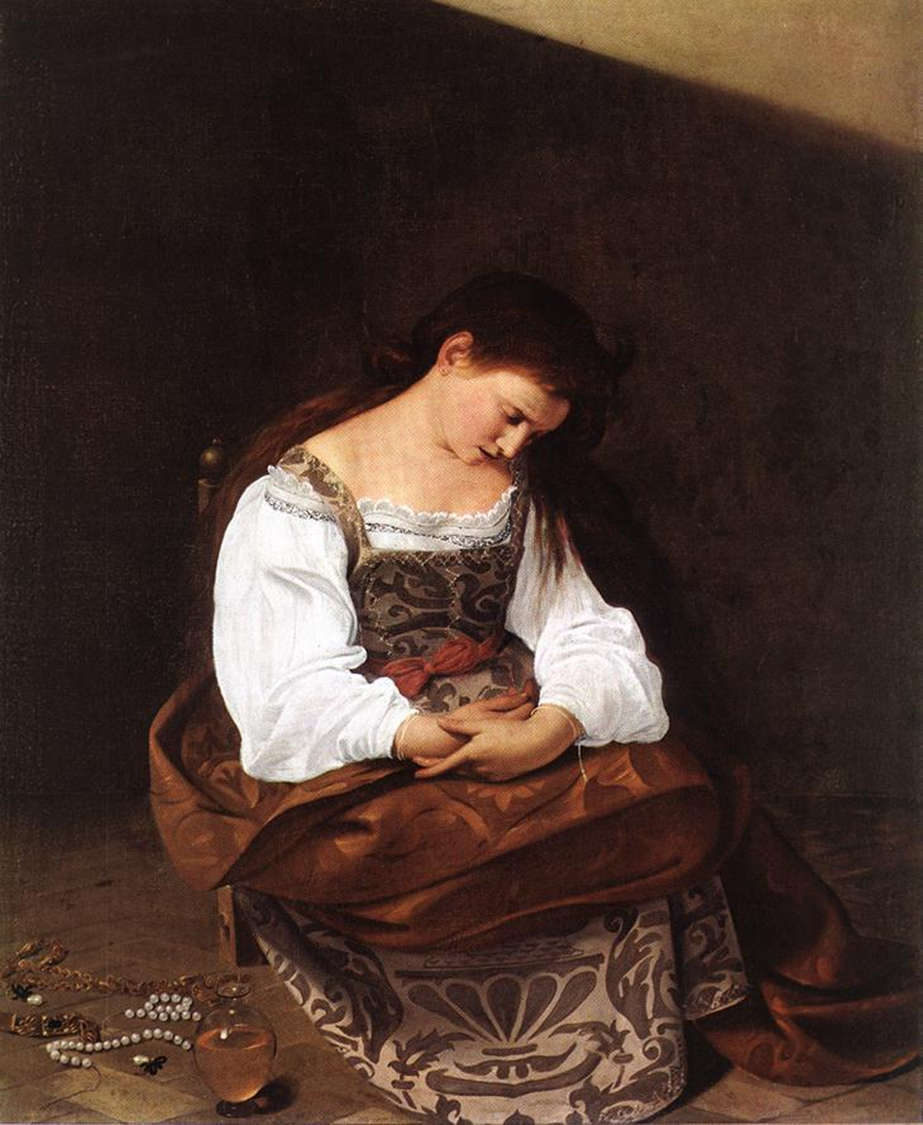
Caravaggio
1596-7
Period/Movement: Baroque (Naturalism)
Original Location: Commissioned for an unknown patron, possibly a private devotional piece
Current Location: Doria Pamphilj Gallery, Rome
Patron: Unknown
Material/Media/Medium: Oil on canvas
Technique: Chiaroscuro, detailed naturalism, emotional realism
CONTENT
Depicts Mary Magdalene, seated on a low stool, dressed in rich yet simple clothing, with her head bowed in sorrow.
Jewelry scattered on the floor symbolizes her renunciation of her past as a courtesan.
Unlike traditional depictions, there are no extravagant religious symbols—the emphasis is on human emotion and introspection.
The background is dark and empty, drawing attention to her figure and the moment of reflection.
FORM
Composition: Simple and intimate, focusing on Magdalene’s internal transformation.
Color: Warm, earthy tones; the contrast between the golden light and deep shadows enhances realism.
Lighting: Dramatic chiaroscuro emphasizes her downcast face and emotional state.
Perspective: The slightly tilted angle of the jewelry on the floor subtly leads the viewer’s eye toward her hands and contemplative pose.
CONTEXT & FUNCTION
Created during the Counter-Reformation, when the Catholic Church promoted personal repentance and spiritual transformation.
Depicting Mary Magdalene as an ordinary woman, rather than an idealized saint, aligns with Caravaggio’s naturalism and emotional depth.
Encourages devotional reflection, allowing viewers to relate to her as a sinner seeking redemption.
STYLE & MEANING
Caravaggio’s innovative realism breaks away from previous idealized, decorative representations of saints.
The absence of extravagant religious symbols shifts the focus to inner spirituality rather than external grandeur.
The contrast between worldly luxury (jewelry) and spiritual contemplation reinforces themes of repentance and redemption.
A highly influential work, inspiring later Baroque depictions of saints with psychological depth and realism.
Rest on the Flight into Egypt
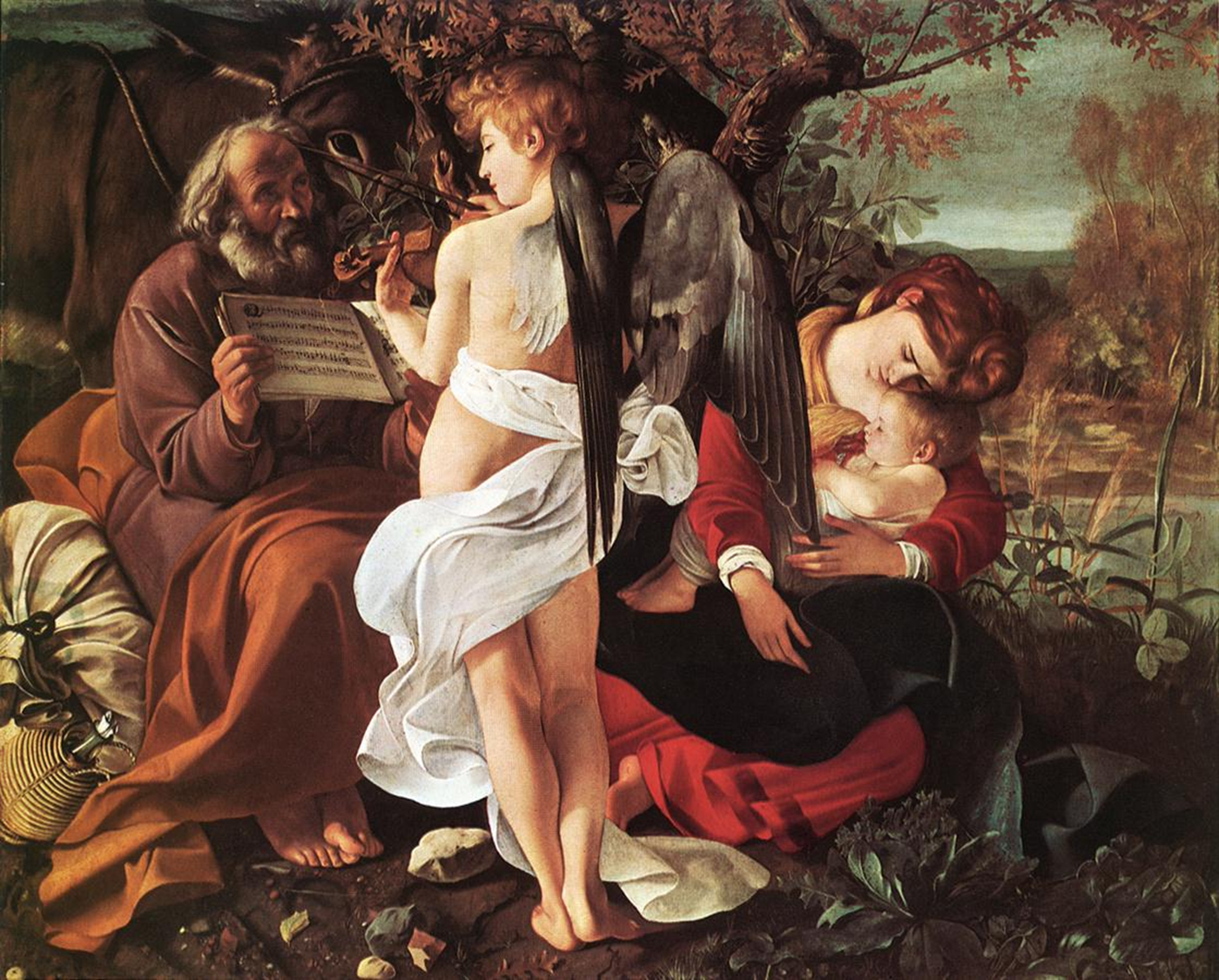
Caravaggio
1596-97
Period/Movement: Baroque (Naturalism)
Original Location: Likely commissioned for a private patron, possibly for Cardinal Francesco Maria Del Monte
Current Location: Galleria Doria Pamphilj, Rome
Patron: Possibly Cardinal Francesco Maria Del Monte
Material/Media/Medium: Oil on canvas
Technique: Chiaroscuro, atmospheric naturalism, Venetian-inspired color
CONTENT
The painting illustrates a quiet moment during the Holy Family’s journey to Egypt.
Mary is asleep, cradling the infant Jesus in her lap, suggesting maternal warmth and exhaustion.
Joseph is holding sheet music for an angel, who is playing the violin, creating a mood of divine harmony and rest.
A donkey stands in the background, reinforcing the idea of travel and exile.
FORM
Composition: Diagonal arrangement of figures, creating a gentle, flowing movement.
Color: Warm, earthy tones with soft natural light reminiscent of Venetian painting.
Lighting: Gentle chiaroscuro, emphasizing the divine presence of the angel while maintaining realism.
Perspective: Carefully structured to draw attention to the angel and the Holy Family, blending religious and natural elements.
CONTEXT & FUNCTION
Aligns with Counter-Reformation ideals, encouraging a humanized, intimate connection with sacred figures.
The inclusion of music as divine communication reflects the contemporary belief in harmony as a symbol of celestial order.
Unusual depiction of the Flight into Egypt, emphasizing rest and tenderness rather than hardship.
Possibly meant for private devotional use, promoting contemplation of faith, family, and divine guidance.
STYLE & MEANING
Breaks from traditional religious iconography, favoring a realistic, human portrayal of the Holy Family.
Soft, naturalistic figures contrast with more dramatic Baroque religious imagery.
Demonstrates Caravaggio’s early interest in light, shadow, and emotional depth, foreshadowing his later masterpieces.
Influences later Baroque depictions of religious scenes, emphasizing intimate moments over grandiose storytelling.
Judith Beheading Holofernes
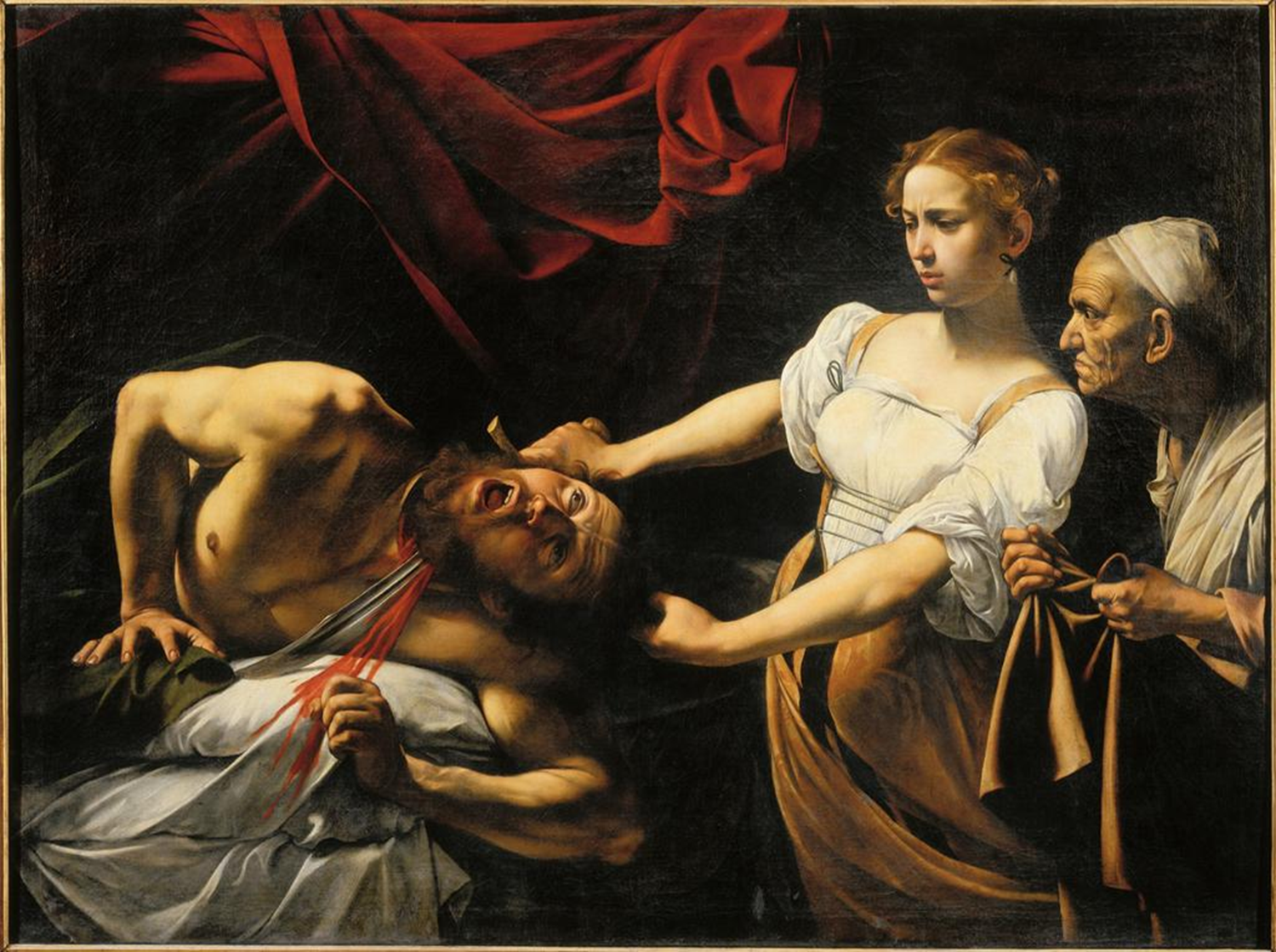
Caravaggio
ca. 1598
Period/Movement: Baroque (Naturalism, Tenebrism)
Original Location: Likely commissioned for a private patron
Current Location: Galleria Nazionale d’Arte Antica, Rome
Patron: Unknown
Material/Media/Medium: Oil on canvas
Technique: Chiaroscuro, tenebrism, intense realism
CONTENT
The biblical story of Judith, a Jewish widow, decapitating the Assyrian general Holofernes to save her people.
Judith, dressed in elegant clothes, grasps Holofernes’ hair while using his own sword to cut through his neck.
Holofernes' face is contorted in pain and horror, with blood spurting from his wound.
An elderly servant, Abra, assists Judith, watching intently.
The background is dark, heightening the dramatic intensity of the moment.
FORM
Composition: Triangular arrangement of figures, focusing on Judith’s poised strength and Holofernes’ struggle.
Color: Stark contrast between Judith’s pale skin, the dark background, and the deep red of the blood.
Lighting: Dramatic tenebrism—harsh light on Judith and Holofernes against a nearly black background.
Perspective: Close-up view, making the scene intimate and shocking.
CONTEXT & FUNCTION
Aligns with Counter-Reformation ideals, emphasizing divine justice and heroic female virtue.
The story of Judith as a symbol of triumph over tyranny was widely used in religious and political contexts.
Highly theatrical and emotional, engaging the viewer in the violence and psychological tension.
Influences later Baroque artists like Artemisia Gentileschi, who painted multiple versions of Judith’s story.
STYLE & MEANING
Extreme realism, seen in Holofernes’ pained expression and the gory detail of the execution.
Judith’s detached yet determined gaze contrasts with traditional Renaissance depictions, which showed her as either seductive or purely virtuous.
Reflects Caravaggio’s signature style of emotional immediacy and unidealized figures, making the biblical scene shockingly real.
Establishes Caravaggio’s reputation for bold, intense storytelling, setting the stage for his later dramatic works.
Matteo Contarelli
Commissioned Caravaggio to paint three paintings for the Contarelli Chapel in the Church of San Luigi del Francesi in Rome depicting scenes from the life of Saint Matthew: The Calling of Saint Matthew, The Inspiration of Saint Matthew and The Martyrdom of Saint Matthew.
The Martyrdom of St. Matthew
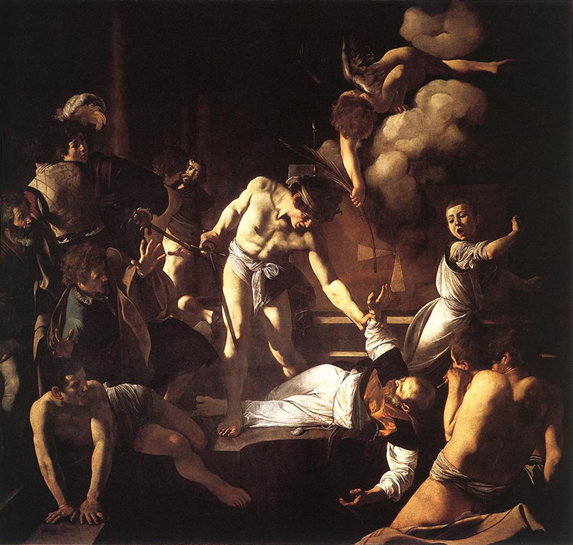
Caravaggio
1599-1600
Period/Movement: Baroque (Naturalism, Tenebrism)
Original Location: Contarelli Chapel, San Luigi dei Francesi, Rome
Current Location: Still in its original location, Contarelli Chapel, San Luigi dei Francesi, Rome
Patron: Cardinal Matteo Contarelli
Material/Media/Medium: Oil on canvas
Technique: Chiaroscuro, tenebrism, dynamic composition
CONTENT
Depicts the moment of St. Matthew’s martyrdom, when he is attacked by a soldier inside a church.
Matthew, in white robes, is on the ground, reaching out in fear and surprise.
A ruthless executioner, partially nude, prepares to deliver the fatal blow.
Witnesses react with shock and horror, creating a sense of chaos.
An angel above extends a palm branch, symbolizing martyrdom and divine reward.
Caravaggio includes a self-portrait in the background, observing the event.
FORM
Composition: Diagonal lines create a sense of movement and urgency.
Color: Stark contrasts between light and shadow intensify the drama.
Lighting: Extreme tenebrism, highlighting Matthew and the executioner while plunging much of the scene into darkness.
Perspective: The foreshortened figures pull the viewer into the violent, emotional moment.
CONTEXT & FUNCTION
Commissioned as part of Caravaggio’s series for the Contarelli Chapel, celebrating St. Matthew’s life.
Reflects Counter-Reformation ideals, emphasizing martyrdom, divine grace, and human suffering.
The intense realism and dramatic energy break from Mannerist traditions, making the event feel immediate and real.
Encouraged emotional engagement and religious devotion in viewers.
STYLE & MEANING
Revolutionary use of realistic, unidealized figures in a sacred narrative.
Psychological intensity, as seen in Matthew’s desperate reach and the executioner’s determination.
Contrast between earthly violence and divine presence (angel) reinforces themes of sacrifice and salvation.
One of Caravaggio’s first major public commissions, cementing his status as a leading Baroque artist.
tenebroso
from Italian meaning dark, gloomy, mysterious, describes a style of painting characterized by extreme contrasts of light and dark where darkness dominates and a spotlight effect is used to highlight key elements.
The Calling of St. Matthew
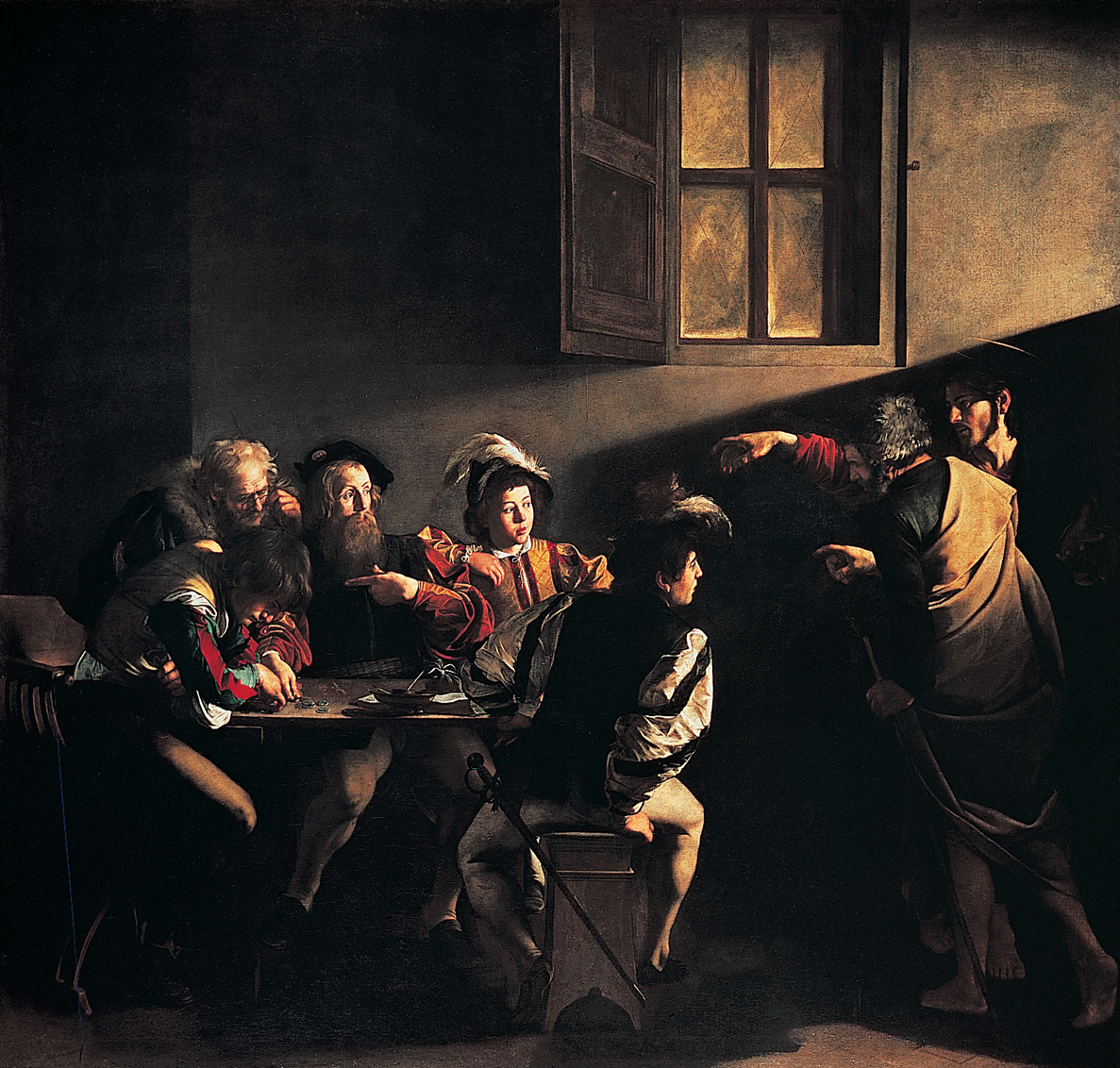
Caravaggio
1599-1600
Period/Movement: Baroque (Naturalism, Tenebrism)
Original Location: Contarelli Chapel, San Luigi dei Francesi, Rome
Current Location: Still in its original location, Contarelli Chapel, San Luigi dei Francesi, Rome
Patron: Cardinal Matteo Contarelli
Material/Media/Medium: Oil on canvas
Technique: Chiaroscuro, tenebrism, dynamic composition
CONTENT
Depicts the biblical moment when Jesus calls Matthew, a tax collector, to follow him.
Jesus, cloaked in shadow, extends his hand, pointing at Matthew, mirroring Michelangelo’s gesture in the Creation of Adam.
Matthew, seated at a table with other tax collectors, looks up in surprise and uncertainty, his hand pointing at himself as if to say, "Me?"
The figures wear contemporary clothing, making the sacred event feel immediate and real.
A strong diagonal beam of light symbolizes divine intervention.
FORM
Composition: Divides the scene into two groups—Jesus and Peter on the right, Matthew and the tax collectors on the left.
Color: Earthy tones with dramatic contrasts between light and shadow.
Lighting: Extreme tenebrism, with the light functioning as both a natural and spiritual force.
Perspective: The diagonal light leads the viewer’s eye toward Matthew, emphasizing the moment of spiritual awakening.
CONTEXT & FUNCTION
Part of Caravaggio’s St. Matthew cycle for the Contarelli Chapel, showcasing his innovative approach to religious art.
Reflects Counter-Reformation ideals, making biblical stories relatable and emotionally engaging.
The setting in a tavern-like environment places the sacred event within a recognizable, everyday scene, appealing to common worshippers.
Encourages viewers to see themselves in Matthew’s position, questioning their own call to faith.
STYLE & MEANING
Revolutionary use of contemporary settings and clothing in biblical scenes.
Gesture and light replace traditional iconography, making the divine subtle yet powerful.
The ambiguous identity of Matthew (is he the bearded man or the young man counting money?) encourages multiple interpretations.
A landmark painting in Baroque art, influencing later depictions of religious conversion and divine intervention.
Inspiration of St. Matthew (1st version)
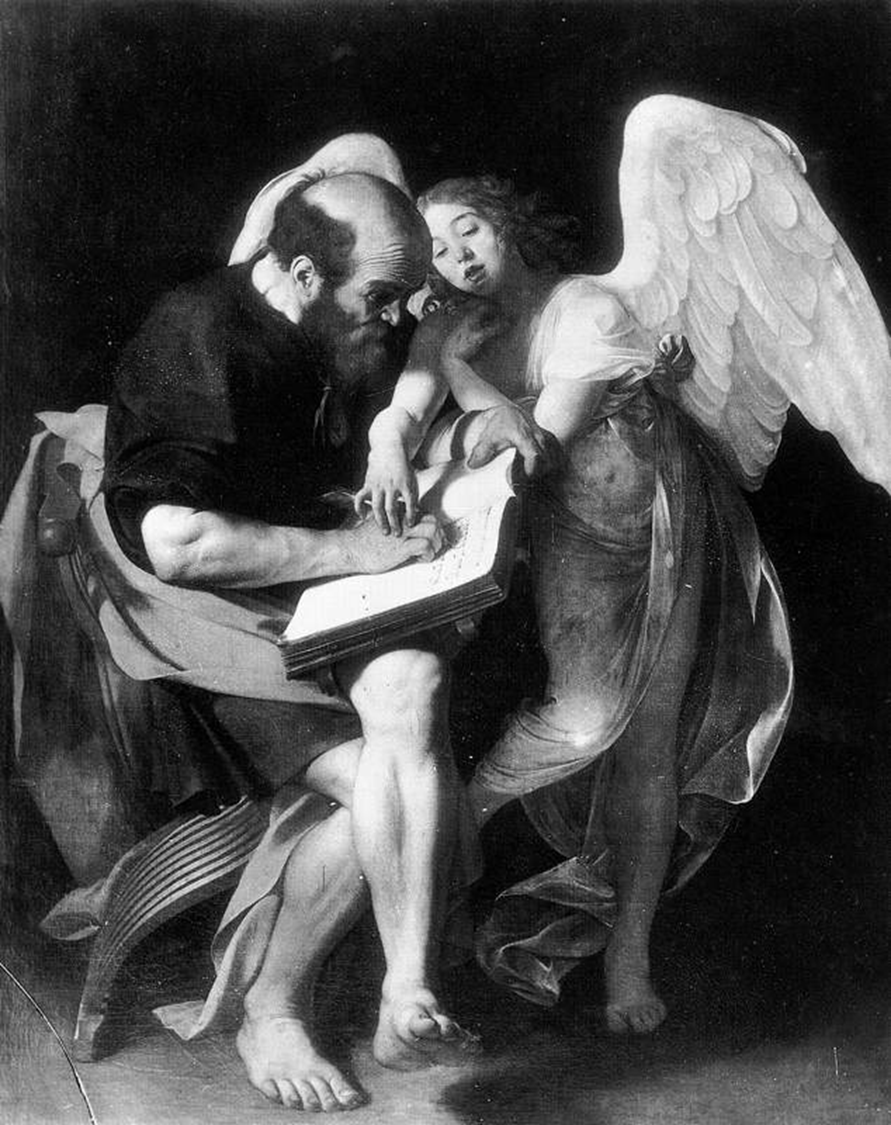
Caravaggio
1602 (destroyed)
Period/Movement: Baroque (Naturalism, Tenebrism)
Original Location: Originally intended for the Contarelli Chapel, San Luigi dei Francesi, Rome
Current Location: Destroyed
Patron: Cardinal Matteo Contarelli
Material/Media/Medium: Oil on canvas
Technique: Chiaroscuro, tenebrism, dynamic realism
CONTENT
The painting portrayed St. Matthew being inspired by the angel to write his gospel.
St. Matthew, seated, is shown in the act of writing, with a furrowed brow, indicating concentration.
An angel is shown hovering above, holding a quill and guiding Matthew’s hand as he writes.
St. Matthew’s posture is informal, emphasizing the human aspect of divine inspiration.
The light emanates from the angel, casting shadows that highlight the intimate nature of the interaction.
FORM
Composition: St. Matthew is placed to the left, with the angel positioned above and to the right, creating a strong diagonal interaction.
Color: Subdued tones, with rich browns and soft golds focusing on the figures.
Lighting: Intense tenebrism, highlighting the figures with strong contrasts between light and shadow to evoke divine presence.
Perspective: The angel’s interaction with Matthew creates a sense of spiritual engagement, but grounded in the earthly realm through their everyday expressions and clothing.
CONTEXT & FUNCTION
Commissioned for the Contarelli Chapel, along with The Calling of St. Matthew and The Martyrdom of St. Matthew.
A key work in Caravaggio’s innovative approach to sacred subjects, emphasizing realism and psychological depth.
Unfortunately, this first version was destroyed, possibly due to disagreements with the patron, as it was rejected by the church.
It likely showed a more earthy, intense scene of divine inspiration, in line with Caravaggio’s typical style of depicting biblical figures in contemporary settings.
STYLE & MEANING
The rejection of this version likely reflects the church’s reluctance to embrace Caravaggio’s gritty realism, which might have been deemed too human or informal for a sacred space.
Caravaggio’s interest in psychological depth would have been evident here, portraying St. Matthew’s internal process of divine inspiration rather than a traditional, idealized depiction.
The light and shadows would have been used to symbolize divine illumination or the presence of the Holy Spirit.
The focus on the ordinary in portraying a holy figure connects to the Counter-Reformation’s emphasis on personal connection to the divine.
Inspiration of St. Matthew (2nd version)
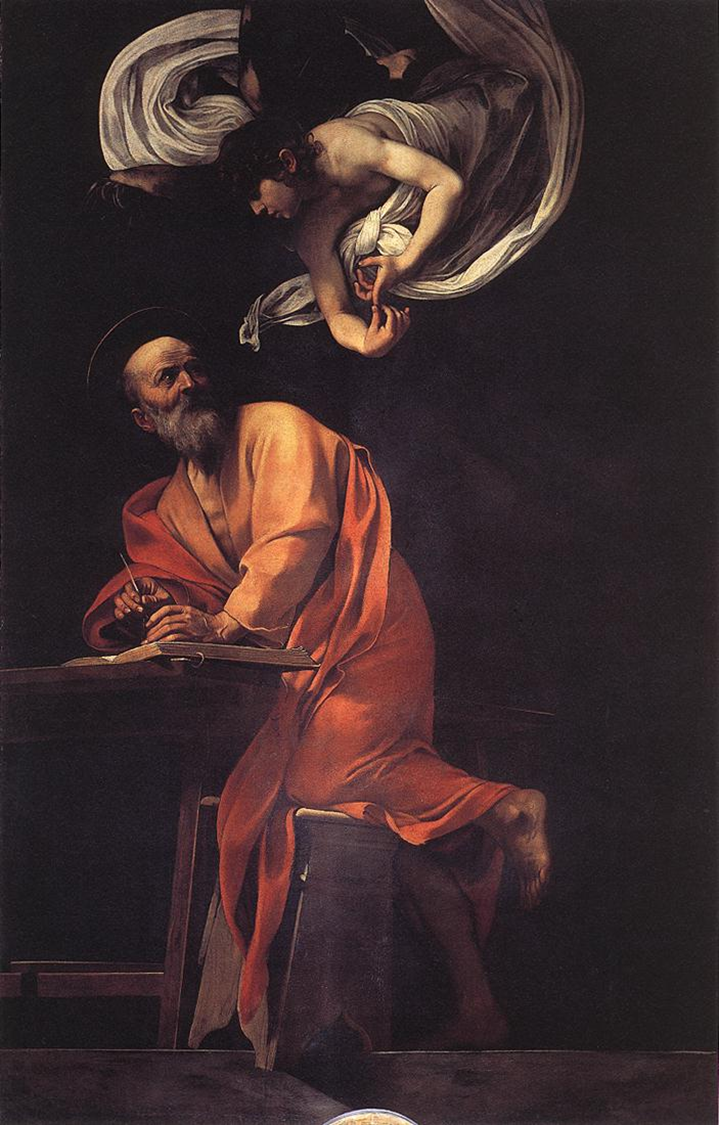
Caravaggio
1602
Period/Movement: Baroque (Naturalism, Tenebrism)
Original Location: Contarelli Chapel, San Luigi dei Francesi, Rome
Current Location: Galleria Doria Pamphilj, Rome
Patron: Cardinal Matteo Contarelli
Material/Media/Medium: Oil on canvas
Technique: Chiaroscuro, tenebrism, dynamic realism
CONTENT
The painting depicts St. Matthew, now in a more formal position, inspired by an angel as he writes his Gospel.
St. Matthew is seated at a desk, writing with pen and paper, and looks upward with an expression of awe and contemplation.
The angel, appearing in the upper right corner, holds a quill, inspiring St. Matthew through its divine influence.
Light from the angel illuminates Matthew, emphasizing the moment of divine revelation and inspiration.
FORM
Composition: The angel is positioned above Matthew, creating a strong diagonal line between them, emphasizing the spiritual connection.
Color: Earthy tones dominate the painting, with light accents highlighting Matthew’s face and the quill held by the angel.
Lighting: Use of tenebrism to create a sharp contrast between the illuminated figures and the surrounding darkness, reinforcing the spiritual presence of the angel.
Perspective: The figures are framed to draw the viewer’s eye toward the interaction between St. Matthew and the angel, reinforcing the moment of divine inspiration.
CONTEXT & FUNCTION
This second version was created after the first version was rejected by the church. The revised version was accepted and became part of the Contarelli Chapel series.
Caravaggio’s dramatic, realistic style was controversial, as it strayed from traditional religious depictions by emphasizing the human emotions and realities of the holy figures.
The second version of the painting adheres more closely to the expectations of the Church, focusing on the sanctity of the moment rather than the more informal, gritty realism seen in the first.
STYLE & MEANING
This version is more conventional in its approach, aligning with the church’s preference for reverence in religious subjects.
The more serene and contemplative expression of St. Matthew in this version contrasts with the more earthly, emotional portrayal in the first version.
The use of light to highlight the angel’s influence underscores the idea of divine guidance, which was important in the Counter-Reformation as the Church sought to inspire a personal connection to the divine.
The transition in style between the two versions reflects Caravaggio’s ability to adapt his bold naturalism to different contexts while maintaining his emphasis on emotional depth.
decorum
The appropriate behavior, speech and conduct expected in a given situation. Latin meaning seemly or fitting.
TIberio Cerasi
An Italian nobleman and the founder of the Church of Santa Maria del Popolo in Rome. Was a treasurer to Clement VIII. He became prominent in the early 16th century, serving as a papal chamberlain under Pope Gregory XIII. Cerasi is known for his patronage of the arts, commissioning works from famous artists like Caravaggio and Annibale Carracci for the chapel he established in the church, which played a significant role in the Baroque artistic movement.
Martyrdom of St. Paul
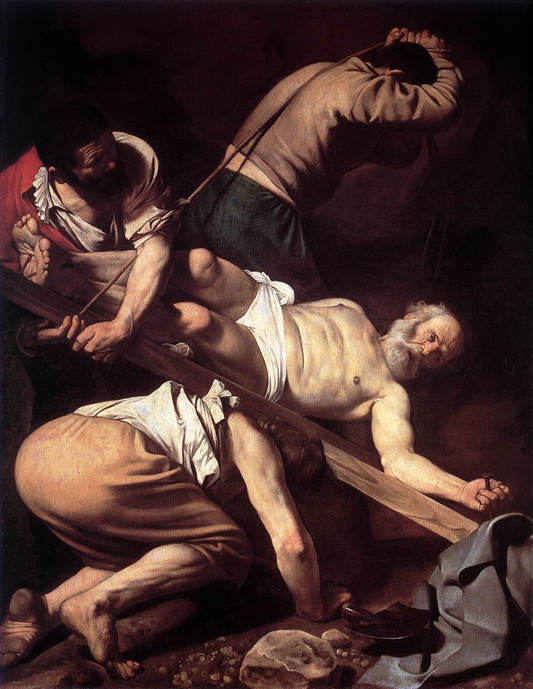
Caravaggio
1600
Period/Movement: Baroque (Naturalism, Tenebrism)
Original Location: Santa Maria del Popolo, Rome
Current Location: Vatican Museums, Vatican City
Patron: Commissioned by Cardinal Tiberio Cerasi
Material/Media/Medium: Oil on canvas
Technique: Chiaroscuro, tenebrism, dynamic realism
CONTENT
Depicts the martyrdom of St. Peter, who is crucified upside down on a wooden cross.
The scene is set in a dark, chaotic environment, with St. Peter’s figure dramatically illuminated from the right, emphasizing his suffering and devotion.
Soldiers are depicted as unconcerned and brutal, reinforcing the violence of the moment.
The background is almost entirely dark, with the light focused on St. Peter, symbolizing his divine strength despite his earthly suffering.
One of the soldiers appears to grab hold of the cross, while another assists in raising it, creating a sense of imminent violence.
FORM
Composition: The composition creates a sense of movement, with diagonal lines forming from the cross and the figures’ postures, enhancing the drama of the scene.
Color: Deep, earthy tones, with dramatic highlights on St. Peter and his tormentors.
Lighting: Strong tenebrism illuminates only the figures in the foreground, creating a stark contrast between light and shadow. The use of light on St. Peter’s face emphasizes his strength and holiness in the face of martyrdom.
Perspective: The forceful diagonals create a sense of movement and urgency, drawing the viewer into the brutal scene of martyrdom.
CONTEXT & FUNCTION
This painting was commissioned for the Cerasi Chapel in Santa Maria del Popolo, Rome, as part of a larger series depicting the martyrdoms of St. Peter and St. Paul.
The intensity of the scene was meant to inspire devotion and reverence among the viewers, showcasing the strength of faith and ultimate sacrifice.
The use of tenebrism highlights the psychological and physical suffering of St. Peter, making it more relatable to the viewer and emphasizing the human cost of martyrdom.
This painting reflects the Counter-Reformation’s emphasis on personal engagement with faith, making the sacred events feel immediate and real.
STYLE & MEANING
The dramatic realism and psychological depth Caravaggio employed marked a departure from earlier, more idealized depictions of martyrdom.
The focus on human suffering, combined with the intimate lighting, conveys the real emotional weight of the scene, making it more accessible to the viewer.
The upside-down crucifixion highlights St. Peter’s humility and his willingness to suffer for his faith, reinforcing his sanctity.
The contrast between light and dark reflects the spiritual battle between good and evil, with the divine light highlighting St. Peter’s faith even in the face of death.
The painting is a powerful expression of the sacrifice of saints, marking a significant shift in Baroque religious art by emphasizing raw emotion and realism.
The Conversion of St. Paul (1st version)
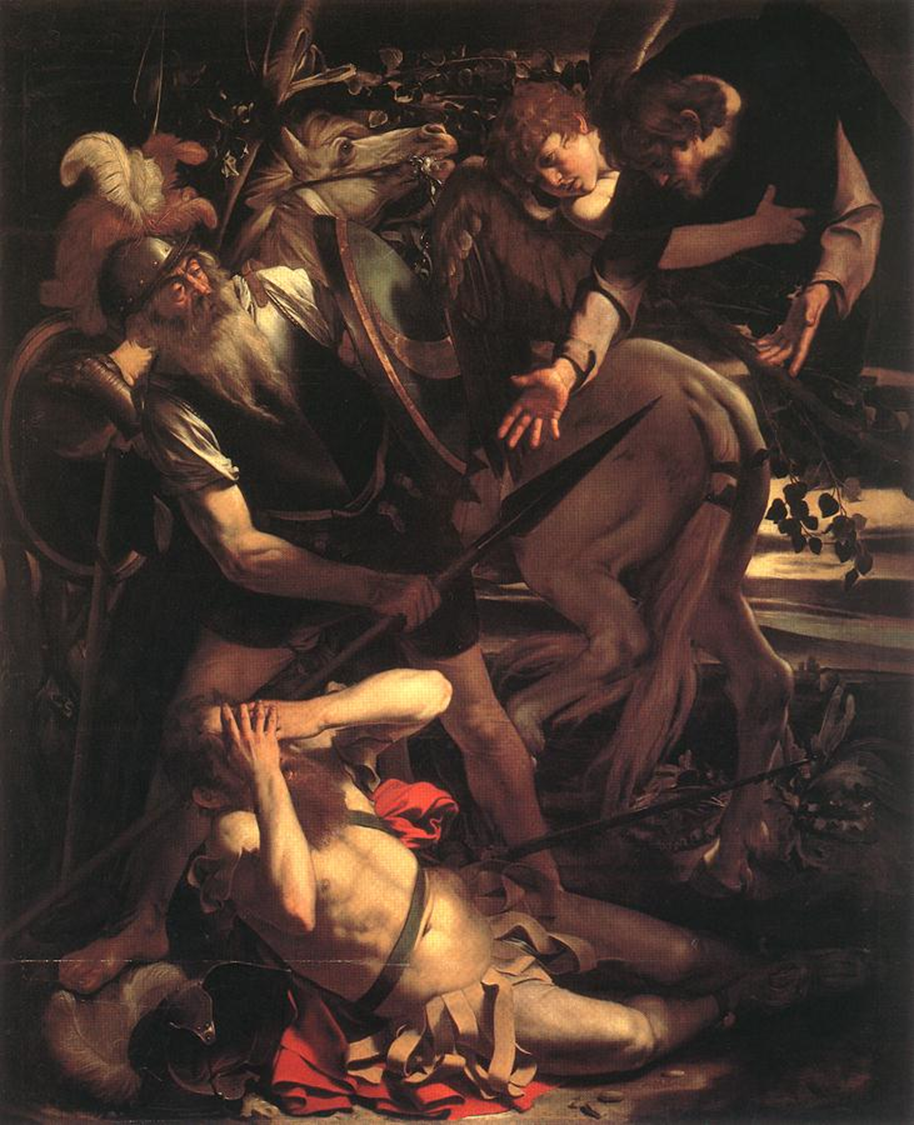
Caravaggio
1600
Period/Movement: Baroque (Naturalism, Tenebrism)
Original Location: Commissioned for the Cerasi Chapel, Santa Maria del Popolo, Rome
Current Location: Destroyed
Patron: Cardinal Tiberio Cerasi
Material/Media/Medium: Oil on canvas
Technique: Chiaroscuro, tenebrism, dramatic realism
CONTENT
The scene depicts the moment of St. Paul’s conversion on the road to Damascus, where Paul is struck by a divine light and falls off his horse.
St. Paul, blinded by the light, lies on the ground while his horse rears up in fear.
The light from the heavens symbolically illuminates Paul, emphasizing the divine nature of the event.
A figure (possibly a companion) appears to help Paul, drawing attention to the dramatic physicality of the moment.
The scene is depicted with intense realism, capturing the vulnerability and human emotion in the midst of divine intervention.
FORM
Composition: The action is framed with strong diagonals, as St. Paul’s body is placed at a dramatic angle on the ground, drawing the viewer’s eye to the central divine light.
Color: Rich, earthy tones dominate the scene, with vivid contrasts of light emphasizing the event’s spiritual and emotional intensity.
Lighting: Tenebrism is used to create stark contrasts between light and shadow, with the bright light representing divine intervention, and the surrounding darkness suggesting the moment of spiritual blindness and awakening.
Perspective: The strong contrast between light and dark intensifies the psychological drama, focusing attention on Paul’s physical and spiritual transformation.
CONTEXT & FUNCTION
This work was part of the Cerasi Chapel cycle in Santa Maria del Popolo, Rome, alongside The Martyrdom of St. Peter and The Crucifixion of St. Peter.
The Conversion of St. Paul was a significant event in Christian history, and Caravaggio’s depiction focuses on the sudden and overwhelming nature of the divine experience.
The rejection of the first version of this painting led to the creation of a second version, which is now in the Odescalchi Balbi Collection, where Caravaggio adjusted his approach to better fit the church’s expectations.
STYLE & MEANING
Realism and Emotional Depth: Caravaggio emphasizes the human side of St. Paul’s conversion, with a focus on physicality and emotion, in contrast to more idealized depictions.
The strong contrasts between light and dark highlight the divine presence and suggest the inner spiritual battle Paul experiences.
The vulnerability of Paul’s figure as he lies on the ground symbolizes his spiritual awakening and humbling experience before God.
The first version of the painting was rejected, possibly because of the earthiness of the depiction, as Caravaggio’s works often elicited controversy for their bold naturalism and emphasis on raw, unvarnished emotion.
The work is significant because it represents the personal nature of religious experience in Baroque art, emphasizing the individual's encounter with the divine.
The Conversion of St. Paul
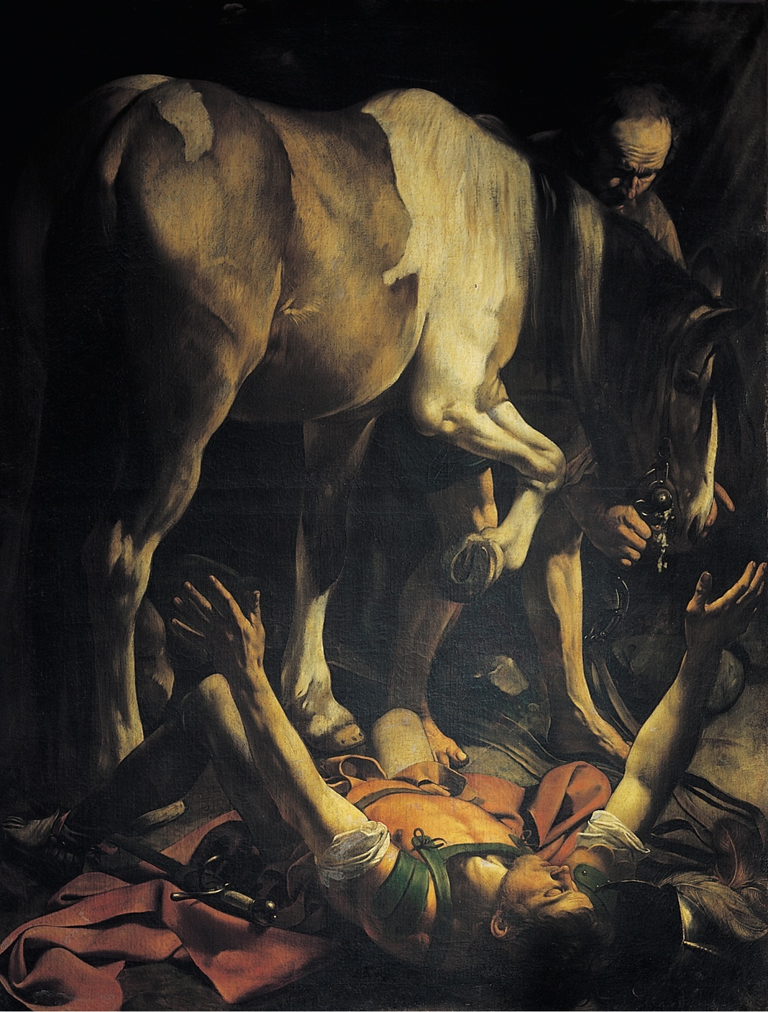
Caravaggio
1601
Period/Movement: Baroque (Naturalism, Tenebrism)
Original Location: Santa Maria del Popolo, Rome (Cerasi Chapel)
Current Location: Odescalchi-Balbi Collection, Rome
Patron: Cardinal Tiberio Cerasi
Material/Media/Medium: Oil on canvas
Technique: Chiaroscuro, tenebrism, dramatic realism
CONTENT
The scene depicts the moment of Saint Paul’s conversion on the road to Damascus, where he is struck by a divine light, causing him to fall from his horse.
Saint Paul is shown lying on the ground, looking upward in awe, his eyes wide open but still blinded by the light.
The light from above appears almost divine and overwhelming, symbolizing the presence of God.
A companion or servant is depicted in the background, holding the reins of Paul’s horse as the animal rears in fear.
The strong physicality of the moment, with Paul’s intense fall and the chaos surrounding the horse, emphasizes the dramatic and overwhelming nature of the conversion.
FORM
Composition: The painting is framed with strong diagonals, emphasizing the dynamics of the fall and the divine light. The diagonal line created by the horse’s raised front leg leads the viewer’s eye to Paul’s figure.
Color: Caravaggio uses rich dark tones in the background, with the bright light focused on Paul, creating a stark contrast between the divine illumination and the darkness.
Lighting: Tenebrism is a key technique here, with the light from above creating a sharp contrast between Saint Paul’s illuminated face and the dark background, heightening the emotional intensity of the conversion.
Perspective: The perspective is dramatic, with the viewer's focus placed directly on Saint Paul’s vulnerable and awe-struck face, with the powerful light from above enhancing his divine encounter.
CONTEXT & FUNCTION
Commissioned for the Cerasi Chapel in Santa Maria del Popolo alongside The Martyrdom of St. Peter, this painting was intended to be part of a visual narrative that honored the apostles and their martyrdoms.
The work was created during the Counter-Reformation, a period where the Catholic Church emphasized a personal, emotional connection to the divine.
The dramatic realism and intense emotional focus reflect the Church’s desire to connect with the viewer’s spiritual experience and evoke strong devotional feelings.
STYLE & MEANING
Realism and Emotion: Caravaggio’s depiction of Saint Paul’s conversion is marked by raw emotional depth, emphasizing the human experience of a divine encounter.
Psychological Impact: The blinding light and physical vulnerability of Paul symbolize his moment of spiritual transformation. This realistic portrayal of the sacred event brings it closer to the viewer, making it more immediate and relatable.
Tenebrism: The use of light and dark is critical in symbolizing the spiritual transition from darkness (sin) to light (grace). The overpowering divine light contrasts sharply with the surrounding darkness, symbolizing the divine intervention in Paul’s life.
Symbolism of Humility: Saint Paul’s physical position on the ground, falling from his horse, emphasizes his humility and vulnerability, even as the light of God is reaching him, a common theme in Baroque religious art.
Historical Impact: The painting is an iconic Baroque work that combines dramatic storytelling with deep emotional resonance, marking the transition of religious art into a more personal, relatable experience for the viewer.
Supper at Emmaus
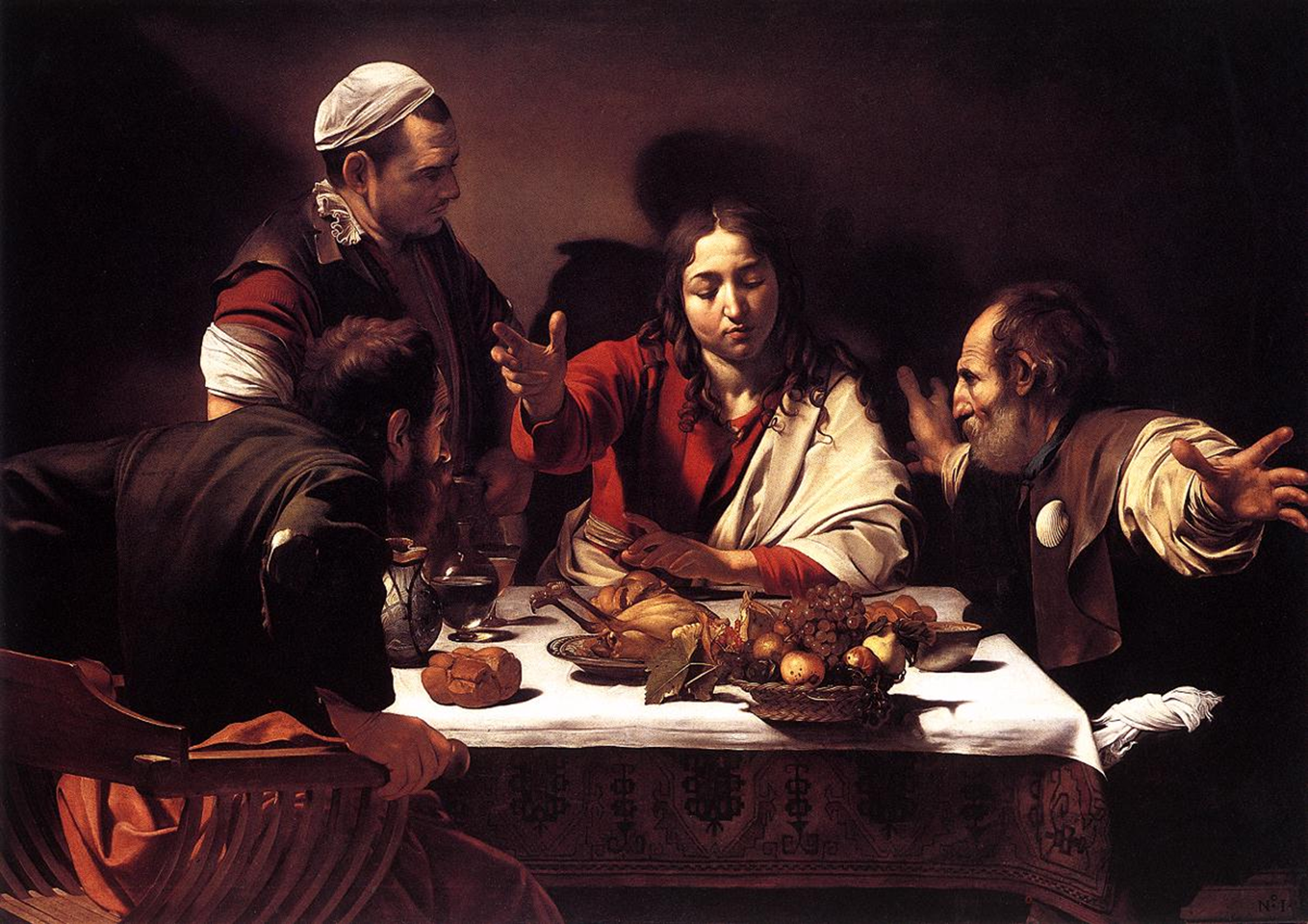
Caravaggio
1601-2
the older one on the right raising his hands in surprise.
The food on the table, including a dish of fish and bread, adds a realistic touch, grounding the divine moment in a familiar, everyday setting.
FORM
Composition: The composition is balanced, with Christ at the center, surrounded by the disciples, creating a moment of dramatic interaction. The spatial arrangement draws the viewer's attention directly to Christ’s hand and blessing.
Color: Earthy tones dominate the scene, with vivid highlights on Christ’s face and hands, creating a focal point that draws the eye. The darker background emphasizes the divine light surrounding Christ and his act of blessing.
Lighting: Caravaggio uses strong tenebrism, with light focused on Christ and the disciples, while the background remains shrouded in darkness, heightening the mystical and divine nature of the revelation.
Perspective: The low angle perspective draws the viewer into the scene, creating a sense of intimacy and immediacy. The figures are portrayed in a realistic manner, with clear attention to physical detail, which makes the miraculous event feel more immediate and relatable.
CONTEXT & FUNCTION
Commissioned by Cardinal Francesco del Monte for the San Luigi dei Francesi church in Rome, Supper at Emmaus was created as part of a series for the church, alongside Caravaggio’s Calling of St. Matthew and Martyrdom of St. Matthew.
The painting was created during the Counter-Reformation, a time when the Catholic Church emphasized art that engaged the viewer emotionally and brought religious themes into personal, relatable terms.
The use of realism in depicting a sacred event was part of Caravaggio’s innovative approach to religious art, creating a connection between the divine and the everyday.
STYLE & MEANING
Realism and Intimacy: Caravaggio’s use of realistic figures and everyday objects in a holy scene creates a sense of intimacy and personal engagement with the viewer, making the divine revelation feel tangible and immediate.
Chiaroscuro and Tenebrism: The dramatic light and shadow emphasize the moment of revelation, with the light on Christ’s face and hand symbolizing his divine nature. The dark background contrasts with the brightness of the central figures, symbolizing the contrast between the earthly and the divine.
Symbolism: The bread and fish represent the Eucharist, symbolizing Christ’s body and his sacrificial death, while the disciples’ surprise and recognition suggest the divine mystery of the resurrection.
Historical Significance: Caravaggio’s work is noted for its psychological realism and emotional intensity, moving away from idealized religious figures to show more relatable human reactions. This was a break from the past and aligned with the Counter-Reformation’s focus on spiritual engagement through personal and immediate experiences.
Amor vincit omnia (Love Conquers All)
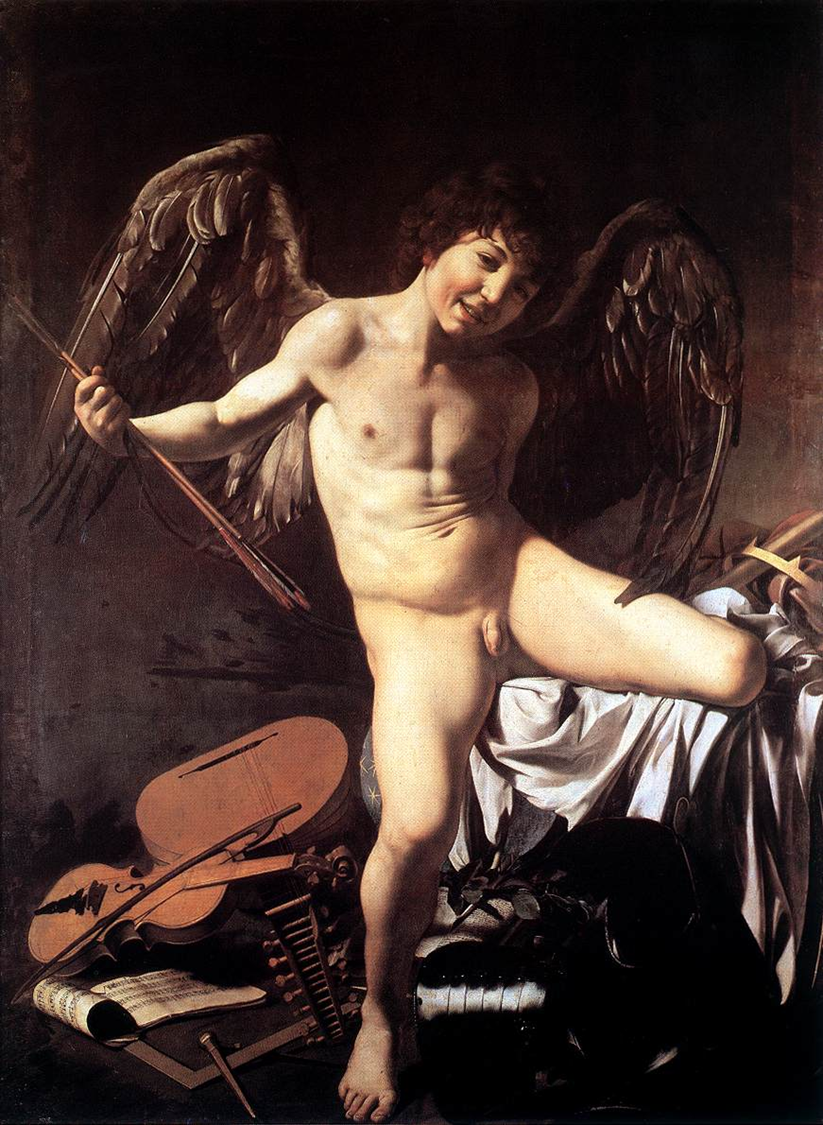
Caravaggio
1602-3
Period/Movement: Baroque (Naturalism, Tenebrism)
Original Location: Commissioned by the Cardinal del Monte for a private collection in Rome
Current Location: Palazzo Barberini, Rome
Patron: Cardinal Francesco del Monte
Material/Media/Medium: Oil on canvas
Technique: Chiaroscuro, tenebrism
CONTENT
The painting depicts Cupid (Amor), the Roman god of love, as a young, semi-nude figure holding a bow and arrows while stepping on a collection of symbolic objects that represent various forms of human achievement, including a musical instrument, military helmet, weapons, and art supplies.
Cupid’s gesture of triumph suggests that love overpowers all worldly accomplishments and forces.
Cupid’s blindfolded eyes emphasize the irrational and unpredictable nature of love that can conquer everything, regardless of reason or power.
The background is intentionally dark, emphasizing the light on Cupid, which aligns with Caravaggio’s characteristic use of tenebrism to focus attention on the subject.
FORM
Composition: The figure of Cupid is placed centrally, creating a strong sense of verticality. His stance and positioning emphasize the idea of dominance and victory over the objects beneath him.
Color: The palette is dominated by earthy tones and rich reds, with light illuminating Cupid and the objects beneath him, accentuating the contrast with the dark background.
Lighting: Caravaggio’s characteristic use of tenebrism creates a stark contrast between light and dark, highlighting the symbolic figure of Cupid and imbuing the work with a sense of divine authority.
Perspective: The perspective in the composition creates a dynamic interaction between the viewer and the objects under Cupid’s feet, symbolizing the dominance of love over all earthly pursuits.
CONTEXT & FUNCTION
Amor Vincit Omnia was commissioned for Cardinal del Monte, a patron known for his interest in the cult of love and its metaphorical power.
The painting was created at a time when Caravaggio was at the height of his fame, known for his ability to turn classical subjects into emotional, realistic depictions of human figures and allegories.
The painting is seen as a playful and provocative depiction of love’s triumph over worldly power and reason, reflecting the philosophical and intellectual currents of the time, which often engaged with classical mythology and human emotions.
It was likely intended for private enjoyment rather than a public commission, showcasing Caravaggio’s ability to infuse allegorical subjects with emotional and psychological depth.
STYLE & MEANING
Symbolism of Triumph: Cupid’s pose and symbolic objects beneath his feet suggest that love overcomes all human institutions, including power, art, and reason. This reflects the Renaissance and Baroque interest in human emotion as a dominant force.
Naturalism and Realism: Caravaggio’s depiction of Cupid as a youthful, realistic figure rather than an idealized representation emphasizes the humanity of the allegory, making it more relatable and emotionally impactful.
Psychological Depth: Cupid’s blindfold highlights the irrational nature of love, while the dark background accentuates the dramatic light on Cupid, elevating the figure to a position of divine authority.
Rejection of Conventional Ideals: By portraying a classical figure like Cupid in such a realistic, almost vulnerable manner, Caravaggio rejected the idealized, ethereal depictions of mythological subjects common at the time, instead infusing the painting with emotional intensity.
Historical Significance: The painting embodies the Baroque principles of drama, emotion, and intensity. It also plays with the theme of the unpredictable and uncontrollable nature of love, which was a recurring theme in both Renaissance and Baroque art.
Marchese Giustiniani
An influential Italian nobleman known for his extensive contributions to the arts and culture during the Renaissance period. He played a significant role in the patronage of various artists and philosophers, thus promoting the cultural enrichment of his time. The Giustiniani family was notable not only for their wealth but also for their political influence. The Marchese established several institutions and collections that advanced the appreciation of art and scholarship. His support helped artists flourish, and his legacy includes the fostering of artistic talent that contributed to the development of Baroque and Renaissance art.
Death of the Virgin
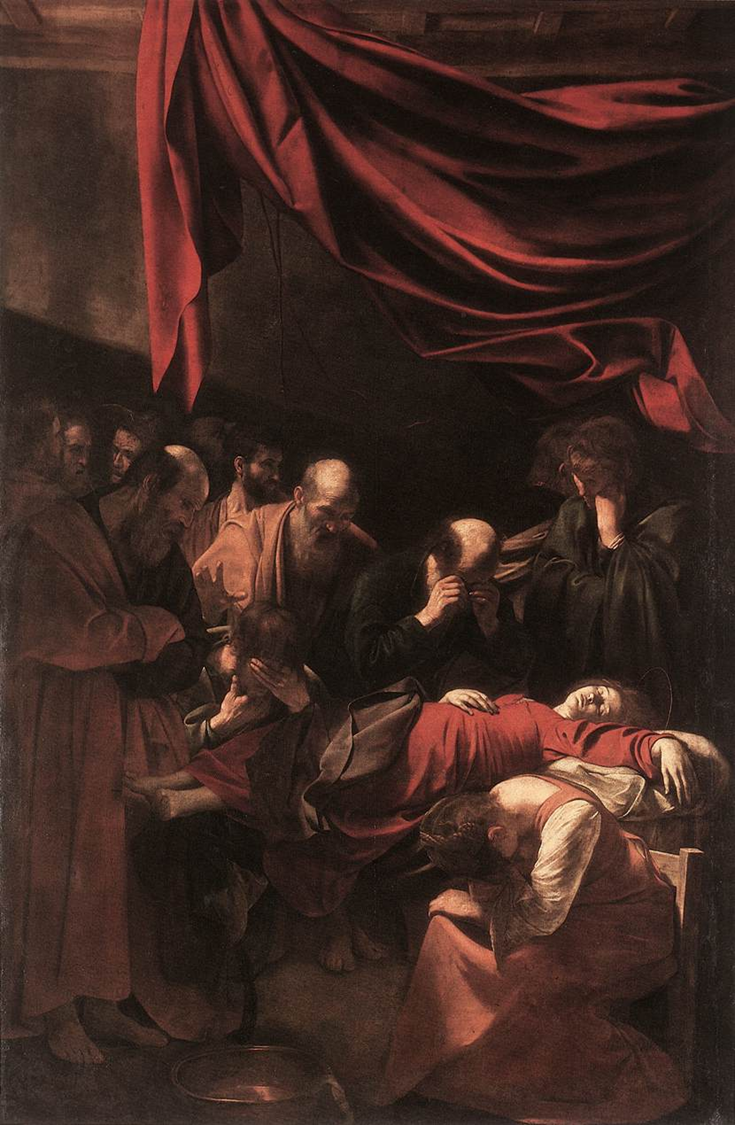
Caravaggio
ca. 1601-02
Period/Movement: Baroque (Naturalism, Tenebrism)
Original Location: Originally commissioned for the Contarelli Chapel in San Luigi dei Francesi, Rome
Current Location: The painting was rejected by the church, and it is now in the Louvre Museum, Paris
Patron: The commission was likely from the Cardinal del Monte
Material/Media/Medium: Oil on canvas
Technique: Chiaroscuro, Tenebrism, Realism
CONTENT
The painting depicts the moment of the Virgin Mary's death, with her body lying in a state of repose, surrounded by grieving apostles and other figures.
Mary is depicted with an earthly, real appearance, in contrast to the idealized representations often seen in religious art. Her face is pale and lifeless, and her hands rest quietly on her chest, emphasizing the reality of death rather than the divine.
The apostles and figures gathered around her bed show deep emotional response, with some in anguish, while others appear to hold vigil, which emphasizes the human sorrow at the passing of the Virgin.
The emotional realism and the physicality of the figures underline the human aspect of the sacred event—a departure from idealized portrayals of the death of holy figures.
FORM
Composition: The central positioning of Mary’s body draws attention to her physical absence of life, while the surrounding figures convey an emotional response. The figures are arranged in a balanced manner around Mary, which emphasizes both human grief and the divine.
Color: The rich earth tones and deep shadows in the background create an atmosphere of quiet mourning, while the light source from the left highlights the Virgin’s face and the hands of the figures, drawing attention to the realism of the moment.
Lighting: Tenebrism is used masterfully to create a stark contrast between light and shadow, with the figures illuminated in a way that enhances their emotional intensity. The dim background and focused lighting on the figures enhance the somber, reflective mood.
Perspective: Caravaggio’s use of space and perspective creates a feeling of intimacy, bringing the viewer close to the tragic moment. The viewer is positioned as though they too are part of the gathering of figures around Mary.
CONTEXT & FUNCTION
Commissioned for the Contarelli Chapel in San Luigi dei Francesi in Rome, the painting was rejected by the church due to its unconventional realism, particularly the way Caravaggio portrayed Mary’s death.
The painting was completed during the Counter-Reformation, a time when the Catholic Church was emphasizing art that could connect emotionally with the viewer and present religious subjects in a more humanized light.
The rejection of the work may also have been related to the controversy surrounding Caravaggio’s realism, which challenged traditional representations of holy figures in religious art.
The painting reflects Caravaggio's characteristic approach to religion: presenting sacred subjects with realistic human emotions and portraying divine figures as flesh and blood rather than as idealized icons.
STYLE & MEANING
Realism and Human Emotion: Caravaggio’s naturalism is evident in his portrayal of Mary as a real woman. Unlike many previous depictions of the Virgin's death, in which she is often shown sleeping peacefully or glorified, Caravaggio shows the reality of death with physical decay, grief, and raw emotion.
Symbolism of Death: The pale face and lifeless pose of the Virgin highlight the realism of her passing, while her closed eyes and stillness emphasize the finality of death, an essential theme in the painting. The figures of the apostles convey the human sorrow at this event, which contrasts with the typical depictions of a divine, transcendent death.
Tenebrism and Light: The lighting, focusing on Mary and the surrounding figures, highlights their physicality and emotion, while the darkness of the background adds a sense of void or loss, deepening the somber mood of the work.
Rejection and Controversy: The painting was considered blasphemous by some due to its raw, unidealized depiction of Mary, showing her as physically dead rather than gloriously sleeping or being assumed into heaven. This, combined with the earthy realism of the figures, made it difficult for the Church to accept at the time.
Historical Significance: Death of the Virgin marks a radical shift in religious art, moving away from idealized and ethereal depictions of holy figures toward a more raw, emotional approach. It reflects Caravaggio's vision of depicting sacred moments in a deeply human and relatable way.
Laerzio Cherubini
An Italian artist of the late Renaissance and early Baroque periods, active in the late 16th and early 17th centuries. He is often recognized for his work as a painter and architect, particularly in Rome, where he contributed significantly to the decorative arts of the period. Cherubini is best known for his frescoes and altarpieces, showcasing a blend of Mannerist and emerging Baroque styles. His notable commissions include work for prominent churches and noble families, illustrating the transition in artistic styles during his lifetime. Cherubini's technique often involved dynamic compositions and a vivid use of color, positioning him as a noteworthy figure in the evolution of Italian painting during this transformative era.
Peter Paul Rubens, Duke of Mantua
A Flemish Baroque painter known for his dynamic compositions, vivid color palette, and ability to convey movement and emotion. In addition to being a leading artist of his time, Rubens was also a diplomat and a cultured individual, making important connections across Europe. He was made the Duke of Mantua in 1627, a title that connected him to the powerful Gonzaga family. This title enhanced his status and allowed him to further his artistic influence. Rubens' works often depicted historical, mythological, and religious themes, characterized by dramatic lighting and energetic figures. Notable masterpieces include 'The Descent from the Cross' and 'The Garden of Love.' Rubens founded an extensive workshop that trained many artists, ensuring that his style and techniques would influence generations to come. His contributions to art were not only significant in terms of painting but also in terms of the diplomatic and cultural exchange during the Counter-Reformation in Europe.
Entombment
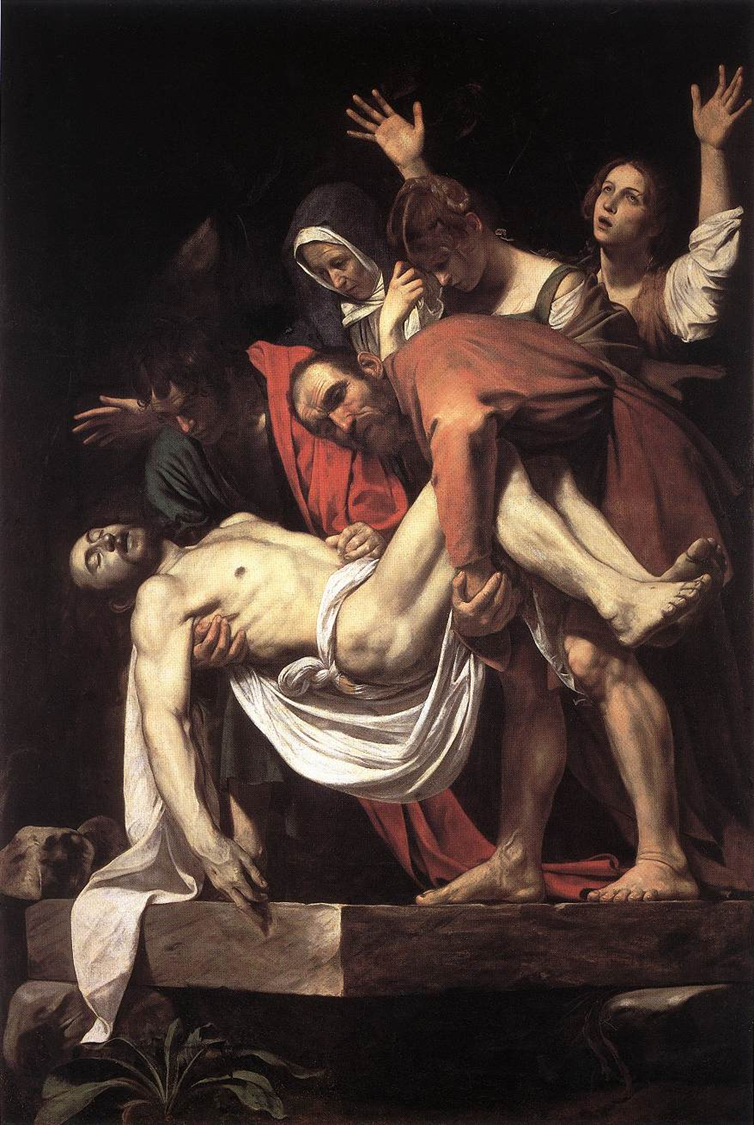
Caravaggio
1602-03
Period/Movement: Baroque (Naturalism, Tenebrism)
Original Location: Originally for the Chapel of Santa Maria in Vallicella (Chiesa Nuova) in Rome
Current Location: Galleria Borghese, Rome
Patron: Commissioned by Cardinal Scipione Borghese
Material/Media/Medium: Oil on canvas
Technique: Chiaroscuro, Tenebrism, Realism
CONTENT
The painting depicts the entombment of Christ, with Christ’s body being lowered into a tomb by a group of figures: Joseph of Arimathea, Nicodemus, and others.
The physicality of Christ's body is emphasized, with realistic rendering of his wounds and lifelessness, as well as the gravity of the moment. His body is shown as heavy, underscoring his humanity and the reality of death.
The figures surrounding Christ display emotional expressions of sorrow and reverence, while the use of light focuses on Christ’s body, highlighting the tragic moment and the drama of the scene.
A strong contrast is made between the darkness of the surrounding space and the illuminated figures, which focuses attention on Christ’s dead body and the figures’ human emotions.
FORM
Composition: The composition is dynamic with Christ’s body positioned diagonally, creating a sense of movement as his body is lowered into the tomb. The figures around him are shown in active positions, emphasizing the effort and gravity of the moment.
Color: The rich reds and browns dominate the palette, while the figures are bathed in a light source that contrasts with the dark background, using chiaroscuro to highlight the realism and emotion.
Lighting: As typical in Caravaggio’s works, light and shadow are used dramatically in Entombment. The strong contrast of light creates a sense of depth and emphasizes the gravity of Christ’s death. The highlighted body of Christ becomes the central focal point, symbolizing his sacrifice and death.
Perspective: The foreground and figures are given significant emphasis, and the scene is presented closely to the viewer, making it feel like an intimate and personal experience of the event.
CONTEXT & FUNCTION
The painting was commissioned by Cardinal Scipione Borghese for the Chapel of Santa Maria in Vallicella, as part of a larger series of works that highlighted the themes of Christ's death and resurrection.
Caravaggio’s approach to religious subjects during the Baroque period was in line with the Counter-Reformation, which emphasized emotional and dramatic depictions of religious scenes to inspire devotion.
The use of realistic figures and the focus on human emotions was unconventional for its time, especially with the raw portrayal of Christ's dead body. The painted moment evokes a highly emotional response from the viewer, making it a personal reflection on Christ’s sacrifice.
STYLE & MEANING
Realism: As with many of Caravaggio's works, Entombment highlights the physicality of Christ’s death by focusing on the lifelessness of his body. His wounds and heavy body are rendered realistically, underscoring the human aspect of the divine and the inevitability of death.
Tenebrism: Caravaggio uses tenebrism to create a strong contrast between light and shadow, which helps to intensify the emotion in the scene. The figures are highlighted by the light, while the background remains dark, suggesting the mourning and grief of the moment.
Symbolism of Sacrifice: Christ’s dead body, though central, is shown without divine glory or idealization, emphasizing his sacrifice. The figures surrounding him are shown in various states of grief and reverence, expressing the human impact of the sacrifice.
Religious Significance: The entombment is a pivotal moment in the Passion of Christ, symbolizing the momentary defeat of death before the resurrection. It highlights the human suffering involved in Christ’s sacrifice for humanity's redemption.
Artistic Innovation: Caravaggio’s choice to depict Christ’s death with such raw, visceral emotion and realism was groundbreaking at the time. Unlike the often idealized and glorified depictions of Christ's death in earlier works, Caravaggio’s approach made the divine more accessible, connecting the viewer to the sacred event on a personal, human level.
ultima maniera
Translate to last style or final manner in Italian and it refers to a late stylistic phase in the art of certain artists, particularly in the context of Mannerism
Supper at Emmaus
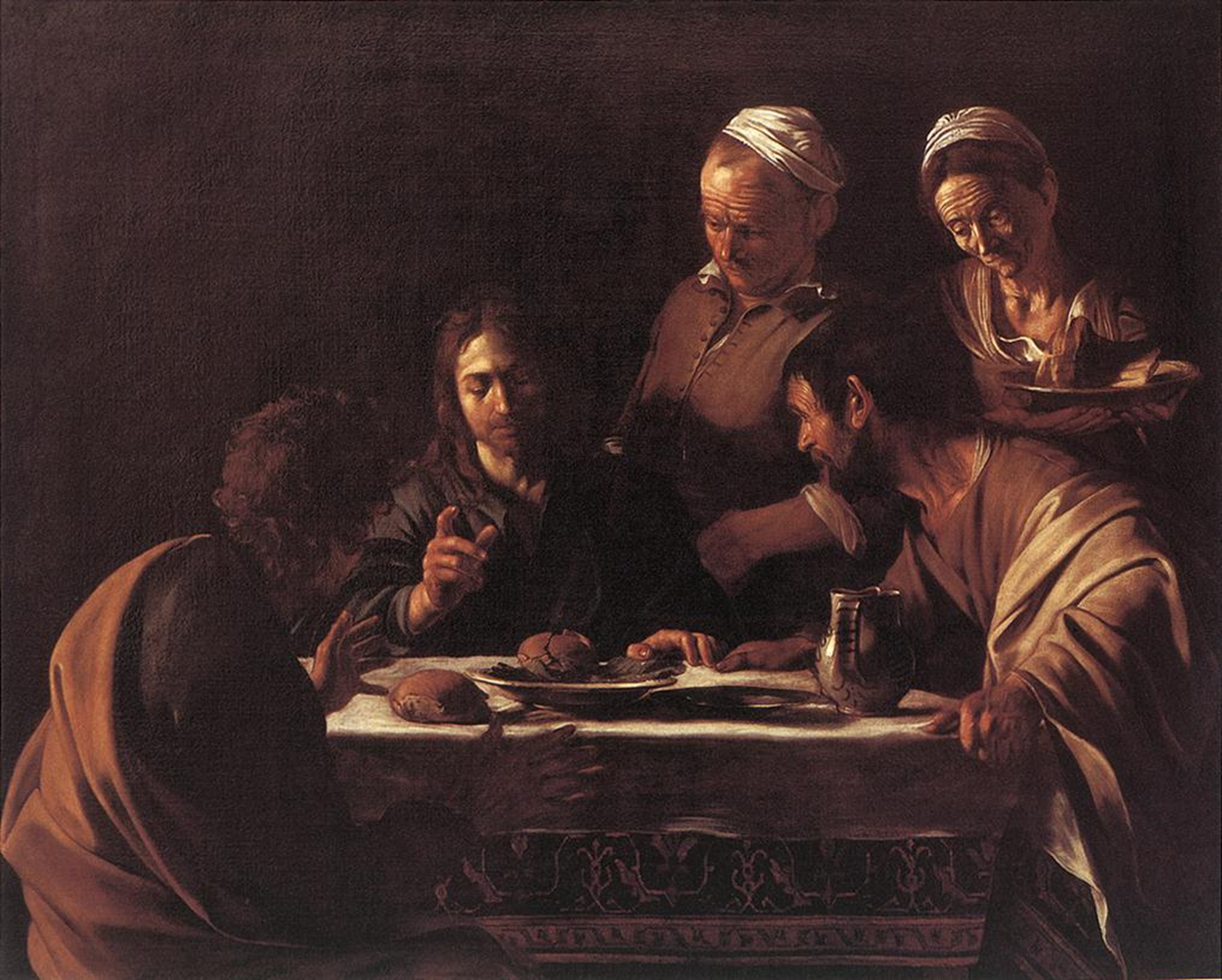
Caravaggio
1606
Period/Movement: Baroque (Naturalism, Tenebrism)
Original Location: Commissioned for the San Giovanni dei Fiorentini, Rome
Current Location: National Gallery, London
Patron: Commissioned by Cardinal del Monte
Material/Media/Medium: Oil on canvas
Technique: Chiaroscuro, Tenebrism, Realism
CONTENT
The painting depicts the moment when Christ reveals his identity to two of his disciples after his resurrection, during a meal in Emmaus.
The scene captures the moment of recognition, with one disciple on the left throwing his hands up in astonishment, while the other, on the right, reaches towards Christ's raised hand.
Christ is shown in realistic attire of a simple traveler, and his figure is in the center of the action, emphasizing the moment of revelation. The bread on the table is a key element, symbolizing Christ's body and referencing the Eucharist.
The disciples' expressions of surprise and wonder draw attention to the divine mystery of Christ’s appearance.
FORM
Composition: The composition places Christ at the center of the scene, with the two disciples positioned on either side. This creates a triangular composition, focusing the viewer’s attention on the interaction between Christ and his disciples.
Color: The color palette is dominated by warm earth tones and deep shadows, contrasting the illuminated figures with the darkness of the surrounding space, a signature technique of Caravaggio’s tenebrism.
Lighting: Caravaggio uses dramatic lighting to highlight the divinity of Christ and the moment of revelation. Christ’s figure is bathed in light, while the figures of the disciples and the rest of the scene are shrouded in shadow. This light serves as a visual metaphor for Christ bringing enlightenment to his followers.
Perspective: The realistic perspective and attention to details of the setting, such as the table and bread, immerse the viewer in the moment. The physicality of the figures, combined with the depth and focus, creates a sense of intimacy and immediacy.
CONTEXT & FUNCTION
The painting was created during a period of religious conflict in Europe, particularly the Counter-Reformation, when the Catholic Church was emphasizing the use of art to convey religious truths and inspire emotional responses from the faithful.
Caravaggio’s choice to depict the disciples in a highly realistic and emotional manner was innovative and aligned with the Baroque style, which emphasized drama and personal engagement with the viewer.
The symbolism of the meal, with Christ breaking the bread, would have resonated with the Catholic emphasis on the Eucharist and Christ’s presence in the sacrament.
STYLE & MEANING
Realism and Human Emotion: As in many of Caravaggio's works, the depiction of the disciples' astonishment and Christ’s simple attire are rendered with a level of realism that brings the sacred event closer to the viewer. The real human reactions in the scene contrast with the divine revelation of Christ’s identity.
Symbolism of the Eucharist: The bread on the table and the gesture of Christ breaking it symbolize the Eucharistic sacrifice, reminding the viewer of the spiritual significance of the scene. This references the Last Supper and the sacrament of communion, reinforcing the Catholic message of Christ's sacrifice and presence.
Tenebrism: The lighting contrasts between the illuminated figures and the dark background create a dramatic effect, enhancing the emotional intensity of the moment. The use of light symbolizes Christ as the source of enlightenment, revealing his divine nature to the disciples.
Theme of Recognition: The central theme of the painting is recognition—the moment when the disciples finally realize the identity of Christ. This theme resonates with the idea of faith and understanding, as Christ’s appearance is both a physical revelation and a spiritual awakening for the disciples.
Artistic Innovation: Caravaggio's approach to religious themes through naturalistic details and dramatic realism was revolutionary, making holy figures and events more relatable and emotionally impactful. The humanization of divine moments in his works helped elevate the Baroque style by making it more accessible and evocative for the viewer.
Beheading of St. John the Baptist
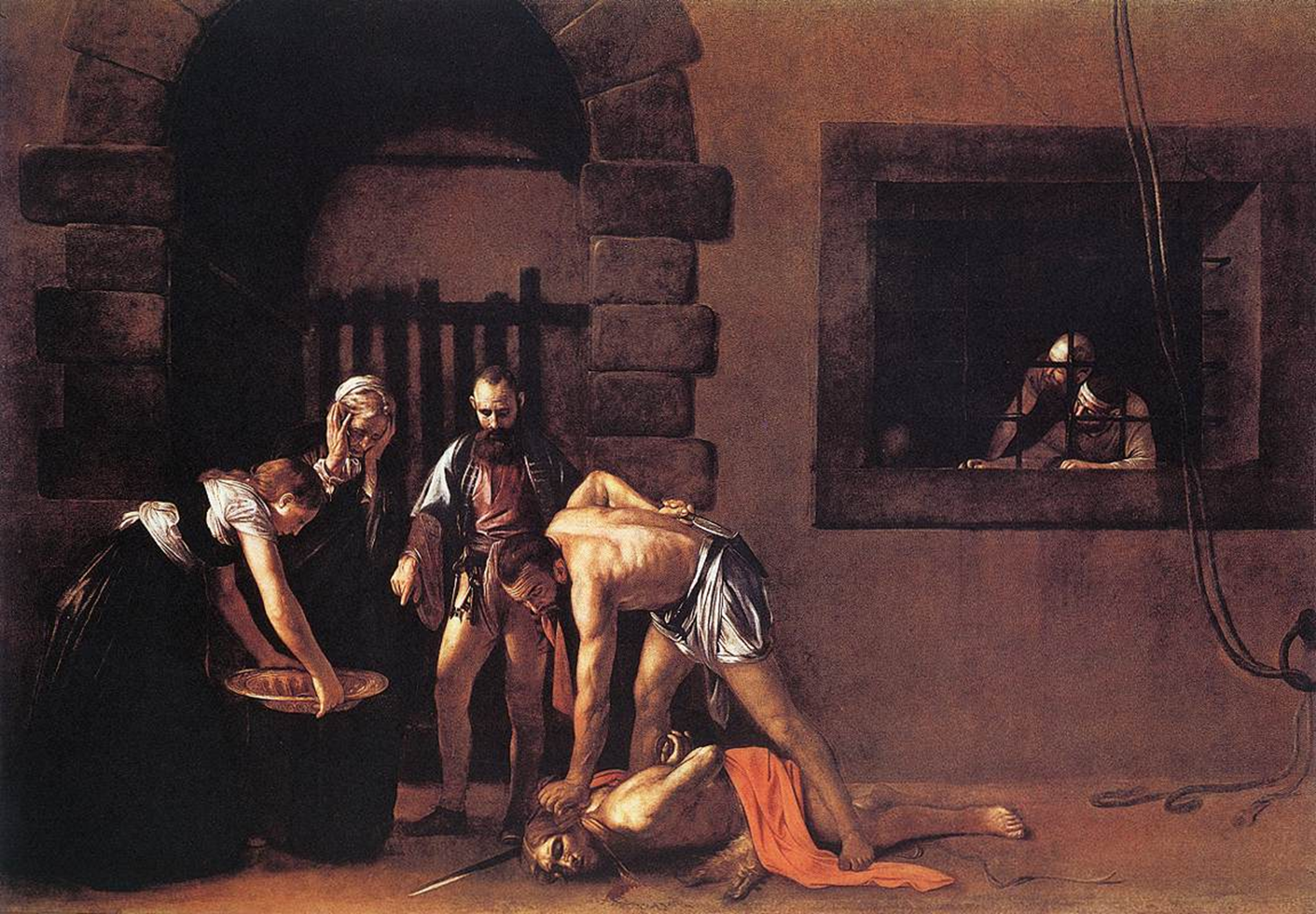
Caravaggio
1608
Period/Movement: Baroque (Naturalism, Tenebrism)
Original Location: St. John's Co-Cathedral, Valletta, Malta
Current Location: St. John's Co-Cathedral, Valletta, Malta
Patron: Commissioned by the Knights of St. John, Malta
Material/Media/Medium: Oil on canvas
Technique: Chiaroscuro, Tenebrism, Realism
CONTENT
The painting depicts the dramatic moment of the beheading of St. John the Baptist. St. John is shown lying on the floor, his head on a platter, about to be handed over by the executioner.
The executioner, a strong, muscular figure, holds a raised sword, while an attendant stands ready to carry the severed head.
The dark, shadowy background enhances the violence of the scene and emphasizes the gory realism of the moment.
St. John’s serene expression contrasts sharply with the brutality of the act, creating a sense of horror and pathos.
FORM
Composition: The composition centers on the figure of St. John, whose body is positioned diagonally, with his severed head placed in the foreground. This creates a dynamic contrast between the stillness of death and the violent action surrounding him.
Color: The deep reds and earth tones highlight the violence of the scene, while the white of St. John’s robe contrasts with the dark background, making the figure stand out.
Lighting: True to Caravaggio’s style, strong contrasts of light and shadow (tenebrism) are used, focusing on St. John’s body and head, creating an intense, dramatic effect. The light symbolizes the divine sanctity of St. John, while the shadows suggest the darkness of the execution.
Perspective: The realistic perspective and close-up view immerse the viewer in the brutal reality of the moment of death. The foreground focuses on the intimate details, such as the bloodied body and the stillness of the head, which enhances the shock factor.
CONTEXT & FUNCTION
Commissioned for St. John's Co-Cathedral in Malta, the painting was created as part of a larger cycle of works for the Knights of St. John.
The painting’s graphic depiction of violence and death served to evoke a strong emotional response from viewers, especially in the context of the Catholic Counter-Reformation, where art was used to emphasize themes of martyrdom, sacrifice, and the confrontation of sin.
The work reflects the religious devotion of the time, drawing attention to St. John’s martyrdom and his holy status, especially within the military and religious context of the Knights of St. John.
STYLE & MEANING
Realism and Naturalism: Caravaggio’s realistic treatment of the figures and bloodied details emphasizes the horror and reality of the scene. The raw human emotion is palpable, making the viewer confront the gruesome violence.
Chiaroscuro and Tenebrism: Caravaggio’s signature use of light and shadow creates a striking contrast between the sanctity of St. John and the darkness of his execution. The light on the saint’s body and head makes him appear almost divine, suggesting that he sacrificed himself for his faith. Meanwhile, the shadows surrounding the executioners and the background underscore the evil and brutality of the act.
Martyrdom and Religious Symbolism: The decapitation of St. John symbolizes the ultimate sacrifice for faith, positioning him as a martyr. His serene expression, despite the brutality of his death, reflects his spiritual triumph and faithfulness in the face of violence.
Violence and Emotion: The emotionally charged nature of the scene — highlighting the coldness of the execution and the peacefulness of the saint — invites reflection on the contrast between life and death, sacrifice and sin, and the spiritual significance of martyrdom.
ARTISTIC INNOVATION
Caravaggio’s focus on realism and naturalism set this piece apart from the more idealized depictions of religious figures in previous works. His raw portrayal of violence and death was shocking to contemporaries, but also deeply resonant with the Baroque emphasis on emotional engagement with the viewer.
This dramatic, almost cinematic treatment of the scene, combined with the tenebrism technique, creates a powerful emotional experience that underscores the spiritual and moral lessons of the scene.
Knight of St. John
Formally known as the Sovereign Military Hospitaller Order of Saint John of Jerusalem, of Rhodes, and of Malta, is a religious order founded in the late 11th century during the Crusades. Established initially to care for sick and injured pilgrims in the Holy Land, the order evolved into a military organization tasked with defending the Christian faith. The Knights became prominent in the Mediterranean region, seizing control of various islands, most notably Rhodes and Malta.
During their peak in the 16th century, the Knights of St. John were known for their military prowess and played a vital role in various naval battles, including the famous Great Siege of Malta in 1565, where they successfully defended the island against the Ottoman Empire. Their stronghold in Malta became a center for Christian naval power, allowing them to disrupt Ottoman trade and bolster Catholic influence in the region.
The order still exists today, with a focus on humanitarian efforts and charitable activities, although its military functions have diminished. The Knights of St. John are distinguished by their unique eight-pointed cross, which symbolizes the eight obligations of the knights, including to live in truth, to be faithful, to be merciful, and to endure persecution. The legacy of the Knights continues to influence various aspects of Western art, architecture, and culture, as many historical structures and cities reflect their impact.
Burial of St. Lucy
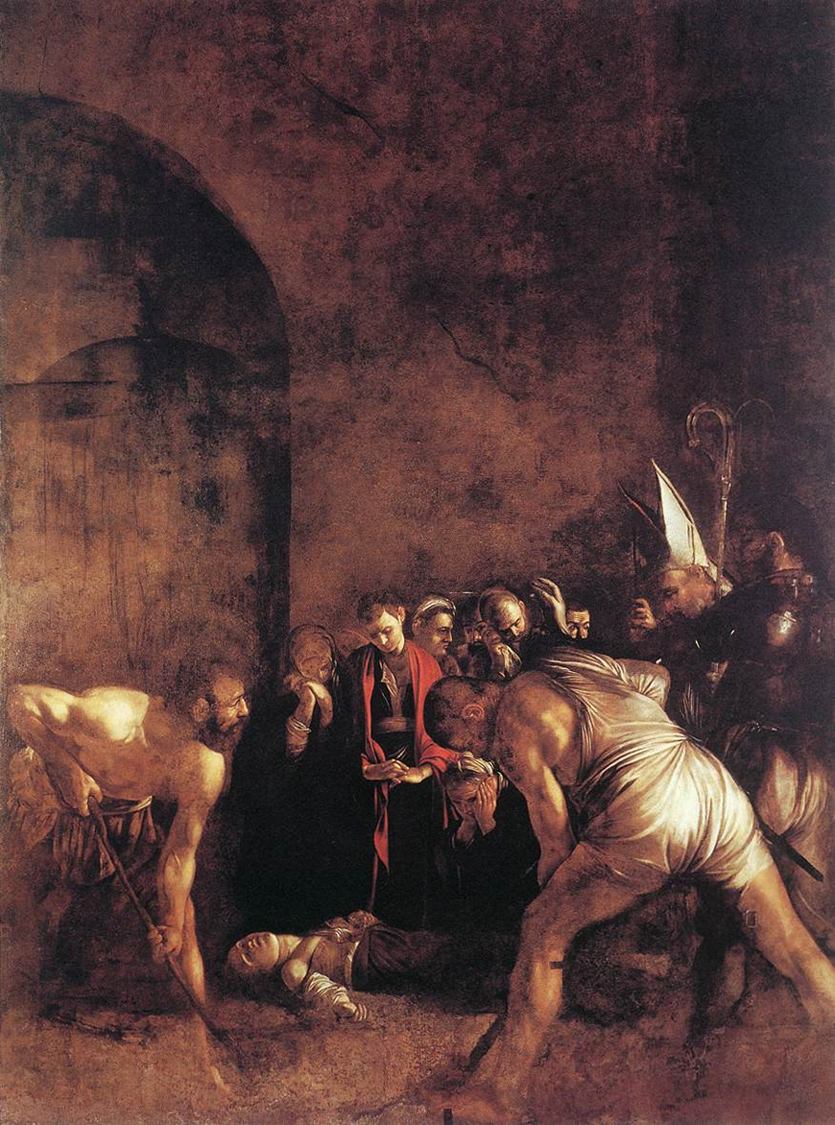
Caravaggio
1608
Period/Movement: Baroque (Naturalism, Tenebrism)
Original Location: Cathedral of Syracuse, Sicily
Current Location: Cathedral of Syracuse, Sicily
Patron: Commissioned by the confraternity of St. Lucy, Syracuse
Material/Media/Medium: Oil on canvas
Technique: Chiaroscuro, Tenebrism, Realism
CONTENT
The painting depicts the burial of St. Lucy, a Christian martyr who was martyred in Syracuse in the 4th century.
St. Lucy’s lifeless body is being carried by mourners to its burial site. She is shown lying on a bier, with candles beside her, and is surrounded by grieving figures.
In the scene, two women, presumably mourners, are placing her body into the grave. There is a palpable sense of reverence, but also the harshness of death is depicted in stark contrast to the peaceful expression on the saint’s face.
The use of light highlights St. Lucy’s face and body, emphasizing her spiritual purity even in death, while the figures around her are shown in shadow, representing the earthly grief of the moment.
FORM
Composition: Caravaggio uses diagonal lines to create a sense of motion and depth, leading the viewer’s eye toward the central figure of St. Lucy. The dark background contrasts with the illuminated figures, emphasizing the saint's sacredness.
Color: The earthy tones, such as dark browns and deep reds, contrast with the lighter tones of the saint’s face and robe, creating a sense of divine focus.
Lighting: As with many of Caravaggio's works, dramatic lighting (tenebrism) plays a crucial role, casting a powerful light on St. Lucy, making her the focal point of the painting while shrouding the other figures in shadow. This lighting symbolizes the divine illumination that surrounds the saint, highlighting her holiness in contrast to the grief of the moment.
Perspective: The figures are shown in realistic scale, and the composition is grounded, which makes the viewer feel they are witnessing the scene up close. The realism of the figures and the physicality of the saint's body increase the emotional intensity of the work.
CONTEXT & FUNCTION
The burial of St. Lucy is an important religious event for the people of Syracuse, where St. Lucy’s relics were revered and the church had a deep connection to the saint. The Commission for this painting would have been part of a larger religious devotion to her.
The painting's emotional power was meant to remind the viewer of St. Lucy's martyrdom and her role as a protector and intercessor for the faithful.
During this period, the Catholic Church used art to convey the spiritual significance of Christian saints and martyrs, with works like this one encouraging devotion and reflection on sacrifice and divine grace.
STYLE & MEANING
Realism and Emotion: The raw realism of the painting, particularly the depiction of death and grief, was revolutionary for the time. Caravaggio’s focus on naturalistic detail creates a real emotional response from the viewer, reminding them of the fragility of life and the divinity of martyrdom.
Chiaroscuro and Tenebrism: Caravaggio’s trademark use of light and dark contrasts the divine and earthly realms. The light on St. Lucy’s face suggests her sacredness, while the shadows around the figures imply the mourning of the living. The use of darkness suggests the veil between life and death.
Martyrdom and Sanctity: By placing St. Lucy’s serene face at the center of the composition, Caravaggio emphasizes her spiritual purity and divine grace, which transcends the earthly grief around her. Her peaceful countenance, even in death, signals her sanctity and redemption.
Physicality of Death: The stark and graphic portrayal of death contrasts with the sanctity of the martyr, emphasizing both the brutality of the world and the spiritual triumph of the saint. The grief of the mourners is set in stark contrast with St. Lucy’s calm, suggesting that while the body may die, the soul is eternal.
ARTISTIC INNOVATION
Caravaggio’s innovative approach to religious themes was deeply rooted in naturalism and emotional realism, focusing on physical human emotions. The depiction of death and martyrdom in such a realistic, almost visceral way was groundbreaking, making this moment of sacred significance feel both immediate and personal.
The use of dramatic lighting and contrast emphasized the spiritual presence of St. Lucy amidst the real-world sorrow, establishing Caravaggio’s hallmark style of tenebrism and his ability to convey the divine and the human in a deeply impactful way.
David with the Head of Goliath (Self-Portrait)

Caravaggio
1609-10
Period/Movement: Baroque (Naturalism, Tenebrism)
Original Location: Galleria Borghese, Rome
Current Location: Galleria Borghese, Rome
Patron: Likely commissioned for a private collection (specific patron unknown)
Material/Media/Medium: Oil on canvas
Technique: Chiaroscuro, Tenebrism, Realism
CONTENT
The painting depicts David, the biblical figure who famously defeated the giant Goliath, holding Goliath’s severed head in one hand and a sword in the other.
What is notable about this particular version of the scene is the reflection of Caravaggio’s face on the severed head of Goliath, which suggests that David is portrayed as a self-portrait of the artist.
The expression on David’s face is one of mixed triumph and sorrow, as he gazes down at the head of Goliath, yet his facial features show a sense of unease, possibly reflecting Caravaggio’s inner turmoil and personal struggles.
The dark background and dramatic lighting (tenebrism) are characteristic of Caravaggio’s work, drawing attention to the violent nature of the scene and the psychological complexity of the moment.
FORM
Composition: The figure of David is positioned prominently, with a strong, muscular pose, holding Goliath’s head almost directly in front of him. The severed head is placed in the foreground, making it the focal point of the composition.
Color: The use of rich, earthy tones—mainly dark browns, reds, and the stark whiteness of Goliath’s head—creates a contrast between the bloodied violence and the calmness of David.
Lighting: Caravaggio employs tenebrism (his signature technique), where the figure of David is dramatically lit, with the light focused on his face and Goliath's severed head, creating a sharp contrast with the darkness surrounding the scene. The light on David symbolizes his victory, while the darkness may represent Caravaggio’s own emotional struggles.
Perspective: The use of realistic proportions and the close-up nature of the figures brings a sense of intimacy and raw realism to the scene. The viewer is drawn into the psychological drama of the moment through the focus on emotion rather than mere spectacle.
CONTEXT & FUNCTION
This work was created during a period when Caravaggio was in exile after being involved in a murderous brawl in Rome, adding personal weight to the narrative. The self-portrait of the artist in the figure of David may reflect Caravaggio’s feelings of guilt, self-doubt, and his ongoing struggle with his own violent nature.
The biblical theme of David and Goliath has been traditionally understood as a symbol of divine triumph over evil, but Caravaggio’s version adds a psychological depth to this story, blending the spiritual and the personal in a way that reflects the turbulent social and emotional context of the artist's life.
The painting likely served as a personal reflection for Caravaggio, possibly an expression of remorse or redemption in the face of his own violent actions and exile.
STYLE & MEANING
Naturalism and Emotion: As is typical in Caravaggio's work, the figures are depicted in a naturalistic manner, with a focus on human emotion and realistic details. David’s expression is not one of pure triumph but rather a complex mix of victory and regret, adding a layer of psychological depth to the work.
Chiaroscuro and Tenebrism: The use of sharp light contrasts emphasizes the moral duality of the scene: David’s victory is set against the darkness of Goliath’s death, suggesting a moral and emotional complexity beyond simple good versus evil.
Self-Portrait and Psychological Insight: The self-reflection in Goliath’s head could indicate Caravaggio’s recognition of his own flaws and violence, making this work a deeply personal and self-aware exploration of the artist’s own inner struggles. The use of David, a figure known for his youthful energy and righteousness, contrasts sharply with the artist’s own sense of guilt and self-doubt.
Martyrdom and Redemption: The biblical story of David and Goliath represents a classic theme of redemption and divine justice, but Caravaggio’s personal involvement in the narrative suggests a cathartic release, possibly hinting at his own desire for forgiveness or reconciliation.
ARTISTIC INNOVATION
Caravaggio’s self-portrait in the figure of David was a bold move, using the story to explore personal redemption through the lens of a religious icon. The psychological complexity of the work, including the sense of self-awareness, was groundbreaking and placed the artist’s own experiences at the forefront of the scene.
The use of tenebrism in this painting—along with the psychological realism of the expression on David’s face—offers a deeply humanized version of a biblical narrative, drawing the viewer into the emotional and spiritual turmoil of the artist himself.
Caravaggisti/ Caravaggismo
Refers to the followers of the Baroque painter Caravaggio, who adopted his distinctive use of chiaroscuro (the strong contrast between light and dark) and naturalism. This movement flourished in the late 16th and early 17th centuries, influencing artists across Europe. Key characteristics include dramatic lighting, a focus on human emotion, and the portrayal of everyday individuals in religious narratives. Prominent Caravaggisti include artists like Artemisia Gentileschi, Orazio Gentileschi, and Giovanni Baglione, who contributed to the spread of this style in their respective regions.
David Contemplating the Head of Goliath
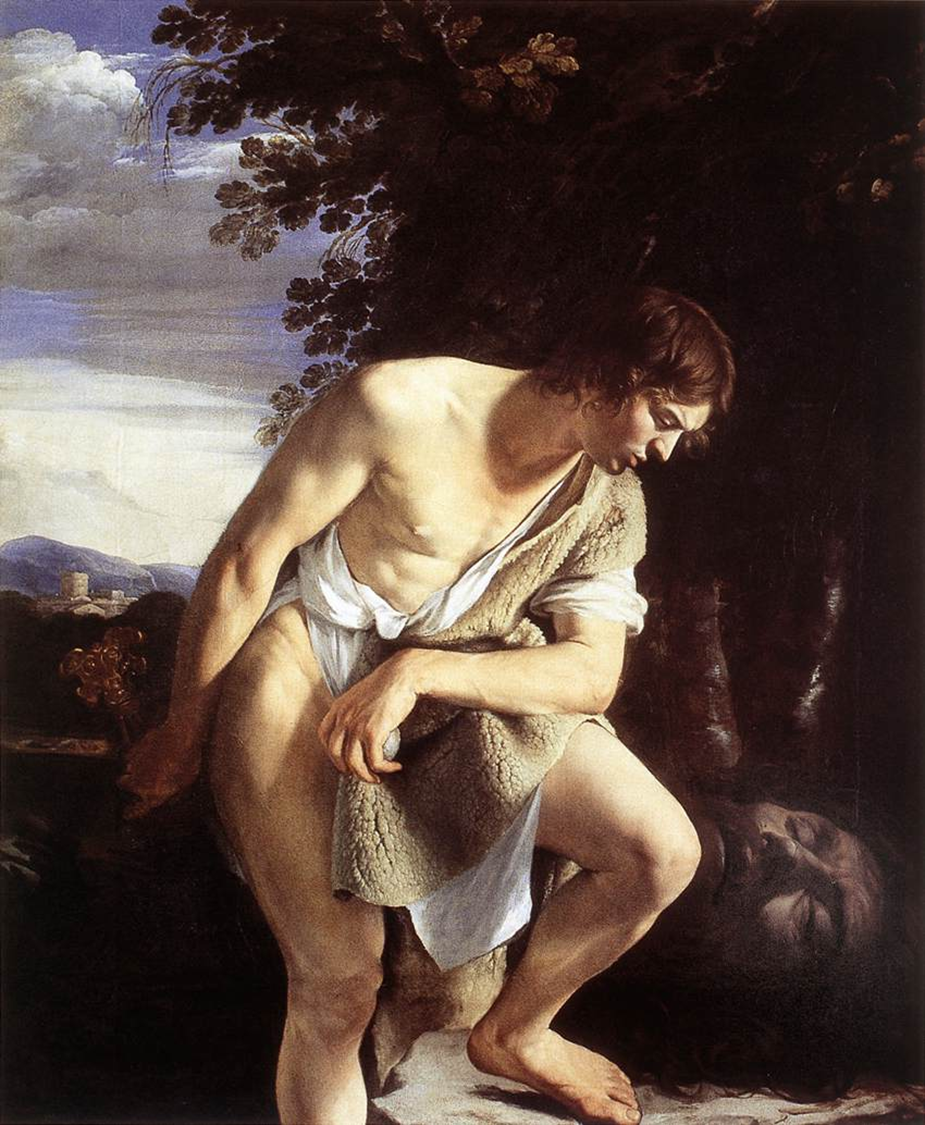
Orazio Gentileschi
ca. 1610
Period/Movement: Baroque
Original Location: Likely commissioned for a private collection (specific location unknown)
Current Location: Palazzo Rosso, Genoa, Italy
Patron: Likely a private collector, possibly connected to the artist's royal commissions
Material/Media/Medium: Oil on canvas
Technique: Chiaroscuro, Naturalism, Tenebrism
CONTENT
The painting depicts David, the biblical hero, holding the severed head of Goliath and contemplating it with a solemn expression. Unlike some other representations where David’s mood might be one of pure triumph, in this version, there is an almost melancholic introspection as David looks down at the head of his vanquished foe.
The dramatic lighting (tenebrism) and dark background further enhance the somber mood, focusing on David’s emotional reaction rather than the battle itself.
Goliath’s head is shown in the lower portion of the composition, emphasizing the physical brutality of the event. The contrast between light and dark underscores the tension between divine triumph and the violence required to achieve it.
FORM
Composition: David is positioned centrally, with the head of Goliath placed before him. His pose and contemplative expression draw the viewer’s attention, making the subject's emotional state the focal point of the composition. The figure of David is slightly tilted, suggesting a sense of reflection rather than physical triumph.
Color: The rich tones of brown and gold contrast sharply with the lighter skin tones of David and the head of Goliath, drawing attention to the gruesome detail of the severed head. The dark background adds to the tense atmosphere, focusing the light on the figures.
Lighting: The use of chiaroscuro and tenebrism highlights the central figures, particularly David’s face and hands, while the dark background gives a sense of mystery and depth. The harsh light on the head of Goliath makes it a grim focal point, while the soft lighting on David conveys his internal reflection.
Texture and Detail: The naturalistic depiction of the human form and the intricate details on Goliath’s head (such as the texture of the skin and the blood) contribute to the realistic intensity of the painting.
CONTEXT & FUNCTION
The story of David and Goliath has long been a popular religious subject, representing the triumph of the divine over the earthly or the righteous over the sinful. This particular interpretation, however, focuses on the psychological aftermath of the event. The depiction of David’s contemplation of the violence he has committed is a more nuanced portrayal of the biblical narrative.
Orazio Gentileschi, the father of the famous artist Artemisia Gentileschi, was a skilled follower of Caravaggio, and this work shows his mastery of tenebrism and naturalism. The painting reflects the Baroque emphasis on emotion and psychological realism, marking a significant departure from earlier, more idealized versions of biblical narratives.
The work was likely created for a private collector or noble patron, and it serves as a reflection on the emotional and spiritual consequences of violent triumphs, providing a more reflective and humanized take on the biblical story.
STYLE & MEANING
Naturalism: Like Caravaggio, Gentileschi employed realistic techniques, emphasizing the humanity and psychological depth of his subjects. The naturalistic details, especially in the depiction of David’s expression and the gruesome realism of Goliath’s severed head, create a striking emotional impact.
Chiaroscuro and Tenebrism: The use of dramatic lighting emphasizes the psychological weight of the scene, drawing a stark contrast between the figures of David and Goliath, as well as highlighting David’s introspective mood. This style of lighting elevates the emotional intensity of the scene, emphasizing David’s internal conflict.
Contemplation and Morality: The focus on David’s contemplation suggests a deep exploration of the moral cost of violence. The work invites the viewer to reflect not just on the triumph of good over evil but on the complexity of the emotions and consequences that arise from such an act.
Psychological Complexity: Unlike many depictions that focus purely on the action of battle, Gentileschi’s painting highlights the aftermath—David’s reflection on his actions, which can be seen as an exploration of personal responsibility and the emotional toll of moral decisions.
ARTISTIC INNOVATION
Orazio Gentileschi’s psychological depth in David Contemplating the Head of Goliath offers a more nuanced interpretation of a well-known biblical story. His use of light and shadow not only emphasizes the physical violence but also reflects the inner turmoil of the character.
The emotional complexity of David’s expression, combined with the gruesome realism of Goliath’s head, contributes to a more humanized and empathic reading of the biblical narrative, making it stand out from more traditional, idealized representations of the hero.
Annunciation
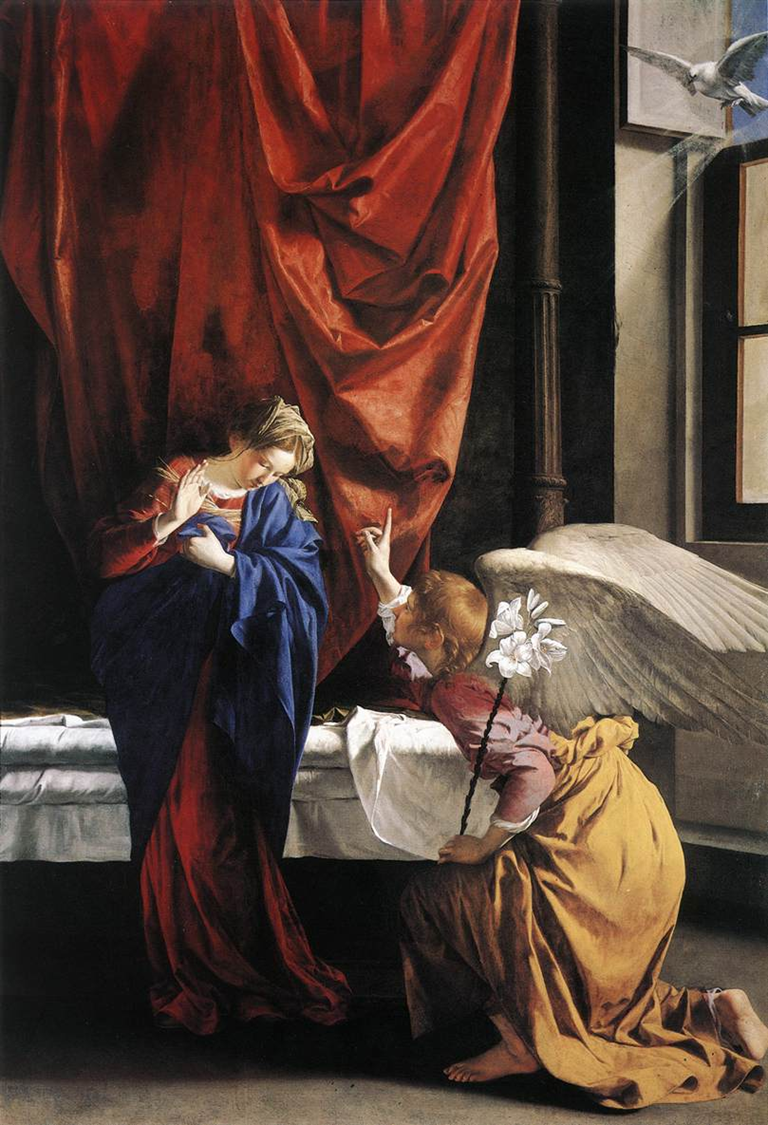
Orazio Gentileschi
ca. 1623
Period/Movement: Baroque
Original Location: Likely created for a private commission, possibly for a chapel or private collection
Current Location: National Gallery, London
Patron: Likely a private patron, possibly associated with religious or noble commissions
Material/Media/Medium: Oil on canvas
Technique: Naturalism, Chiaroscuro
CONTENT
The painting depicts the Annunciation, the moment when the Archangel Gabriel announces to the Virgin Mary that she will conceive the Son of God.
Mary is shown in a humble interior, with a prayerful, contemplative pose, as she listens to Gabriel’s message. Her hands are folded in a gesture of acceptance and submission to God’s will.
Gabriel, often shown with radiant light in Baroque depictions, is depicted hovering above the ground, with outstretched wings, delivering the divine message.
The angel is seen holding a lily, a symbol of purity and virginity, which is a common motif in Annunciation scenes.
The light coming from the angel highlights Mary’s face and hands, indicating the divine nature of the message. The background is dimly lit, enhancing the focus on the central figures and adding depth to the composition.
FORM
Composition: The figures are placed in the foreground, creating an intimate connection between the viewer and the central scene. The diagonal lines of Gabriel’s wings and the folds of Mary’s robe create a dynamic, yet serene, balance.
Color: Rich, earthy tones are used for the interior, creating a sense of warmth and humility. The brilliant white of the lily contrasts with the deep colors of the background and Mary’s robe, drawing attention to both the symbolism of purity and the spiritual significance of the scene.
Lighting: The use of chiaroscuro creates a contrast between the light that shines on Gabriel and Mary, signifying their divine connection, and the darkness of the background, which could represent the earthly world. The angel’s presence is emphasized through strong light, suggesting his divine origin and the heavenly nature of the message.
Texture and Detail: Orazio Gentileschi’s attention to realistic textures, particularly in the depiction of Mary’s robe, Gabriel’s wings, and the drapery, shows his mastery of the naturalistic style that was characteristic of the Baroque period.
CONTEXT & FUNCTION
The Annunciation is a pivotal moment in the Christian narrative, symbolizing Mary’s acceptance of her divine role and her humility. In the Baroque period, artists sought to convey intense emotional experiences, and the Annunciation was a popular subject for this.
Orazio Gentileschi’s interpretation of this moment is quietly contemplative, focusing on the spiritual significance of the encounter between the divine and the human. It is not just a depiction of the event but a reflection of the inner peace and acceptance that comes with Mary’s role in God’s plan.
The Annunciation is often used to highlight the humility and obedience of Mary, and Gentileschi emphasizes these qualities by focusing on her serene expression and calm demeanor, contrasting the divine revelation with the simplicity of the setting.
The work was likely commissioned by a private patron, perhaps for a private chapel, where the intimate nature of the scene would invite contemplation and prayer.
STYLE & MEANING
Naturalism and Emotion: Gentileschi’s naturalistic depiction of both Mary and Gabriel focuses on their humanity, making the divine encounter feel more immediate and personal. The figures are rendered with deep emotional expression, but the overall atmosphere remains tranquil and reverent.
Chiaroscuro: The technique of chiaroscuro (light and dark contrasts) is used to emphasize the spiritual nature of the scene. The lighting highlights the divinity of Gabriel and Mary, symbolizing the divine light that shines upon them, while the darkness of the background provides a contrast to their radiance.
Symbolism: The lily Gabriel holds symbolizes Mary’s purity and virginity, reinforcing the sacredness of the Annunciation. The stillness of the scene, especially in Mary’s contemplative pose, reflects her acceptance of the divine plan and her role in it.
Emphasis on Humility and Devotion: The modest setting and Mary’s humble demeanor convey the humility of the Virgin, emphasizing that the message from Gabriel is not a forceful revelation but one that is accepted willingly by Mary as a devotee of God.
ARTISTIC INNOVATION
Orazio Gentileschi’s calm and meditative approach to the Annunciation is a reflection of his ability to merge Baroque naturalism with spiritual symbolism. His work stands out for the way it captures the subtle emotions of the moment without the overt dramatization found in other Baroque interpretations.
The focus on intimacy and quiet reverence in this painting is a distinctive characteristic of Gentileschi’s work, setting it apart from other depictions of the Annunciation by artists like Caravaggio, who often favored more dramatic lighting and stronger contrasts.
Lavinia Fontana
Influential Italian painter of the late Renaissance and early Baroque periods, born in 1552 in Bologna. She is renowned for being one of the first female artists to gain recognition in the male-dominated world of art. Fontana was trained by her father, Prospero Fontana, who was also a painter. Her work primarily included portraits, religious subjects, and historical narratives, characterized by a vivid color palette and meticulous attention to detail. She often depicted strong female figures and was known for her ability to convey emotional depth in her subjects. Lavinia Fontana became the first woman to gain the title of 'pittore' or painter in the 16th century, leading to commissions from noble patrons, including the Pope. Her legacy paved the way for future generations of female artists, highlighting the capabilities and contributions of women in art during a time when they were often overlooked.
Academia di San Luca
Founded in Rome in 1593, is one of the most prestigious art institutions in Italy, originally established to support and promote the arts during the Counter-Reformation. Named after Saint Luke, the patron saint of painters, the academy aimed to bring together artists, architects, and sculptors under a formal structure that recognized their importance to society and culture. The Academy provided training, support, and a platform for exhibiting works, contributing significantly to the development of Baroque art. Key figures such as Caravaggio, Pietro da Cortona, and Gian Lorenzo Bernini were associated with the Academy, which became a hub for artistic innovation. Throughout its history, the Academy has evolved, adapting to the changing art environment, and it continues to play a vital role in the promotion of contemporary art and artists through exhibitions, awards, and educational opportunities.
Susanna and the Elders
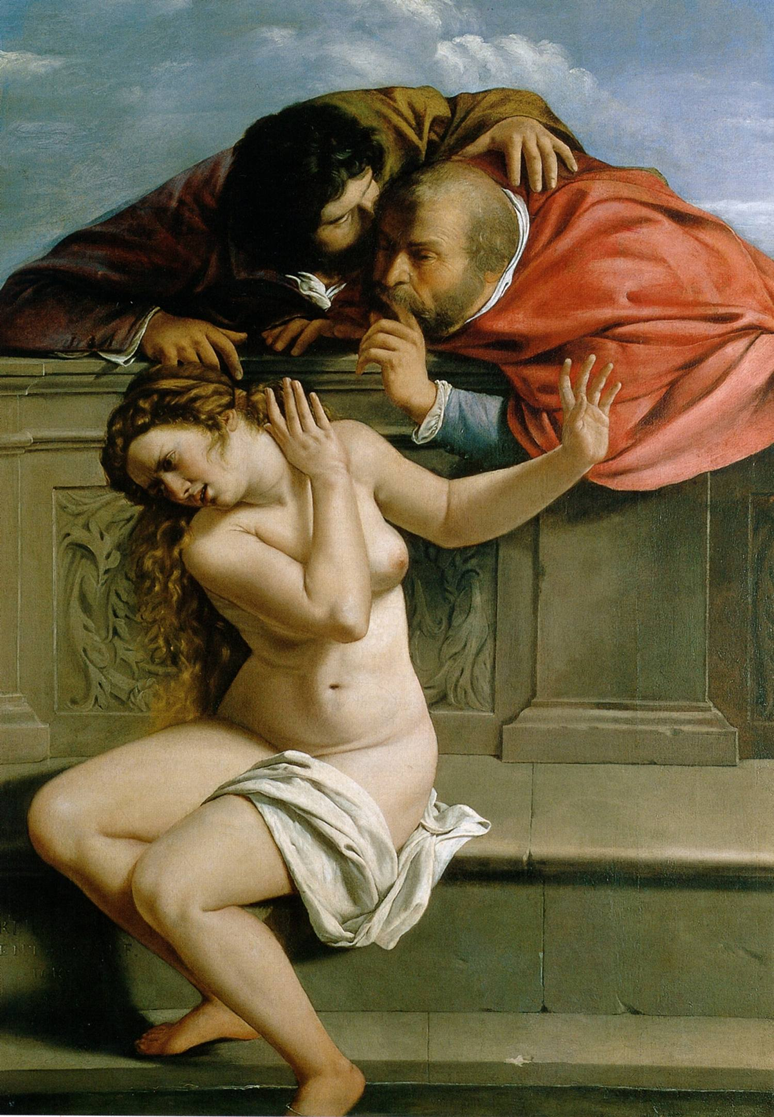
Artemisia Gentileschi
c. 1610
Period/Movement: Baroque
Original Location: Likely created for a private collector
Current Location: Palazzo Pitti, Florence, Italy
Patron: Likely a private patron, possibly a noble or wealthy collector
Material/Media/Medium: Oil on canvas
Technique: Naturalism, Chiaroscuro, Emotional Realism
CONTENT
The painting depicts the biblical story of Susanna and the Elders, from the Book of Daniel. In this scene, Susanna, a young and virtuous woman, is being spied upon by two elders who have lustful intentions.
Susanna is shown in a garden, standing by a bath while the two elders hide behind the foliage and watch her, their eyes fixed on her. Susanna’s expression conveys a mix of surprise, discomfort, and shame, as she realizes she is being watched.
The elderly men are shown in a furtive manner, their faces partially obscured by the foliage to emphasize their sinister intentions. One elder appears to be more prominent, with his face more visible than the other, underlining the imposing nature of their actions.
The lush garden setting symbolizes innocence and purity, which stands in stark contrast to the corruption represented by the elders. The light falls on Susanna’s face and body, highlighting her beauty and vulnerability, while the elders are shadowed, reinforcing their malevolent presence.
FORM
Composition: Artemisia’s depiction is dynamic and balanced, with Susanna placed in the foreground, where the viewer’s attention is drawn to her gestures and facial expression. The elders are hidden in the background, their half-concealed figures suggesting their shameful nature.
Color: The use of rich, vibrant tones enhances the sensuality of the scene. Susanna’s pale skin contrasts with the darker tones of the elders and the surrounding foliage, symbolizing the conflict between purity and corruption.
Lighting: Chiaroscuro is used to create a contrast between light and shadow, highlighting Susanna’s vulnerability and emphasizing her innocence, while the elders are submerged in darkness, reinforcing their role as moral aggressors.
Texture and Detail: The detail in the foliage, Susanna’s skin, and the elders' expressions shows Artemisia’s mastery in creating realistic textures. The soft light on Susanna’s face and body contrasts with the dark shadows in the background, highlighting her emotional turmoil.
CONTEXT & FUNCTION
The story of Susanna and the Elders was a popular subject during the Renaissance and Baroque periods, often depicted to highlight themes of virtue and temptation. This particular version is significant because it focuses not only on the narrative but on Susanna’s emotional response to the elders’ actions.
Artemisia’s personal history, which included being a victim of sexual assault and a protracted court trial, may have influenced her interpretation of this story, making her Susanna a stronger and more empowered figure compared to many earlier depictions.
This painting may have been created for a private patron, possibly a noble family who appreciated the emotional depth and realism that Artemisia brought to the piece. It could have served both as a moral lesson and as an expression of female vulnerability and strength.
STYLE & MEANING
Naturalism and Emotion: Artemisia’s approach emphasizes emotional realism through naturalistic details and a focus on psychological depth. Susanna’s shock, fear, and helplessness are conveyed through her expression and body language. The elders are depicted with a more psychologically charged demeanor, representing lust and greed.
Chiaroscuro: The dramatic contrast between light and dark helps to emphasize the moral dichotomy in the scene—innocence versus corruption. The light that illuminates Susanna’s face and body makes her appear pure and virtuous, while the shadowy figures of the elders suggest their evil intentions.
Feminist Interpretation: Artemisia’s version of the story is often seen as a feminist reimagining of the traditional narrative. In earlier versions, Susanna is often depicted as passive or defenseless, but in Artemisia’s painting, Susanna seems to be portrayed as a victim of male desire, with her emotional expression showing that she is not simply a passive figure.
Empathy and Strength: Artemisia’s work shows Susanna not just as a victim, but as someone who feels the weight of what is happening to her. The artist’s own experiences with violence and injustice may have shaped her depiction of Susanna’s inner strength, making the painting a personal statement on female agency and survival.
ARTISTIC INNOVATION
Emotional Depth: Artemisia's interpretation of Susanna focuses on the psychological impact of the events rather than simply illustrating the narrative. Her Susanna is not just a passive victim but an emotionally complex figure.
Realism: Artemisia’s detailed depiction of Susanna’s body, the expressions of the elders, and the atmosphere of the scene highlights her technical skill in creating realistic emotional tension.
Personalized Approach: Artemisia's experience with trauma likely influenced her more empathetic and nuanced depiction of Susanna’s struggle. This version of the scene stands apart from other Baroque depictions by focusing on emotional realism and psychological depth, rather than simply presenting an allegorical tale.
Agostino Tassi
An influential Italian landscape painter and a significant figure in the Baroque art movement. He was born in Rome and is best known for his dramatic landscapes that often contained mythological or biblical scenes. Tassi's work is characterized by his masterful use of light and shadow, creating a sense of depth and atmosphere within his compositions. He received notable training from the artist and architect Giovanni Battista Salvi, which helped shape his unique style.
Tassi played a key role in the development of landscape painting in Rome, where he was one of the first to elevate the genre to a level of prominence. His landscapes often featured hills, rivers, and architectural elements, reflecting the influence of the natural world and the classical tradition. He was also known for his involvement in the decoration of several Roman palaces, notably for his work in the Palazzo Barberini, where he created large frescoes that showcased his skills in both landscape and figurative painting.
Despite his artistic achievements, Tassi's life was marred by controversy, including a notorious trial for the assault of fellow artist Artemisia Gentileschi, which brought significant attention to both of their careers. Despite his personal struggles, Tassi's contributions to the Baroque landscape genre remain highly regarded, and his influence can be seen in the works of later artists who followed in his footsteps.
Judith Beheading Holofernes
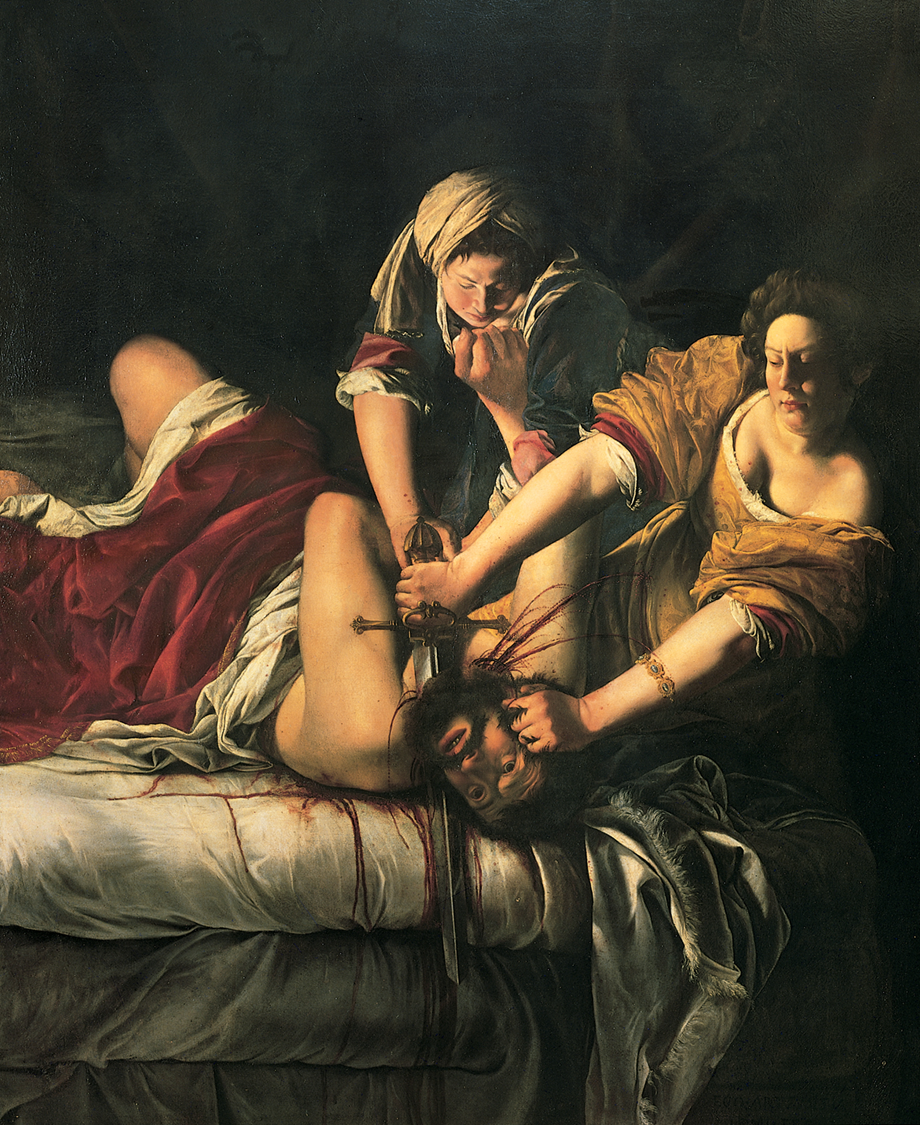
Artemisia Gentileschi
c. 1620
Period/Movement: Baroque
Original Location: Likely a private commission, possibly for a noble patron
Current Location: Galleria degli Uffizi, Florence, Italy
Patron: Likely a private or aristocratic patron, possibly in Rome or Florence
Material/Media/Medium: Oil on canvas
Technique: Naturalism, Chiaroscuro, Dramatic Realism
CONTENT
The painting depicts the biblical story of Judith, a Jewish widow who, in a time of war, saves her people by seducing and then decapitating Holofernes, an Assyrian general.
Judith is shown in the act of beheading Holofernes with a bloody sword, her expression intense and determined, reflecting her courage and resolve.
Holofernes is shown in a violent, anguished moment as he is held down by Judith’s maidservant, who assists her in the struggle. Holofernes' grimace of pain contrasts sharply with Judith’s calm determination.
The violent action and the blood spilling emphasize the brutality of the moment, while also highlighting Judith's strength and agency in taking control of her fate and the fate of her people.
FORM
Composition: The figures are arranged in a dramatic, dynamic composition, with Judith and Holofernes at the center. Judith’s strength is emphasized by her muscular arms and determined posture, while Holofernes’ defeat is illustrated through his flailing limbs and anguished expression.
Color: The colors used are rich and deep, with strong contrasts between dark shadows and the bright, bloody highlights of the scene. Judith’s dark clothing and pale skin stand in contrast to the red of the blood, symbolizing the brutality and courage of her act.
Lighting: Chiaroscuro (light and dark contrasts) is employed effectively to create a dramatic tension. The light falls on Judith’s face and hands, focusing on her strength and determination, while the dark shadows surrounding Holofernes emphasize his defeat.
Texture and Detail: The attention to detail in the textures of the blood, Judith’s skin, and Holofernes' garments shows Artemisia’s mastery in painting both the violent action and the emotional depth of the moment.
CONTEXT & FUNCTION
Biblical Significance: The story of Judith and Holofernes was a common subject in Baroque art, often symbolizing heroism, courage, and the triumph of good over evil. Judith’s action can be seen as an act of divine justice, as she saves her people from destruction by the Assyrians.
Artemisia’s Personal Context: Artemisia’s own experiences with violence and trauma (particularly her rape and trial) are often interpreted as influencing her depiction of Judith’s strength and victory over oppression. Her own experience as a woman in a male-dominated society adds a layer of empathy and personal empowerment to the story.
The violent nature of the scene, with its graphic portrayal of decapitation and blood, could also serve as a reflection of Artemisia’s sense of justice and a personal commentary on female agency, making the painting not only a biblical scene but also a statement about female strength and vindication.
STYLE & MEANING
Emotional Realism: Artemisia’s use of dramatic realism and chiaroscuro enhances the intensity of the moment. The contrast between Judith’s composed expression and Holofernes’ agony underscores the emotional depth of the scene, showing that the act of killing was not easy or without emotional cost for Judith.
Feminist Interpretation: Judith is often portrayed in earlier works as a passive participant or with less focus on her personal emotions. However, Artemisia’s Judith is strong, decisive, and fully in control of the situation. The graphic violence of the scene can be interpreted as a form of catharsis for Artemisia, who may have been asserting her own empowerment through the act of justice.
Violence and Heroism: Artemisia presents a more visceral portrayal of Judith’s act, emphasizing the brutality of the violence. The blood and gore in the painting serve as a reminder of the harsh realities of war and justice, while also highlighting the heroic aspect of Judith’s actions.
Personal Empowerment: The painting can be read as a reflection of Artemisia’s own struggles and resilience in the face of personal trauma. Judith’s strength in decapitating Holofernes mirrors the artist’s own overcoming of obstacles and assertion of power in a male-dominated world.
ARTISTIC INNOVATION
Realism and Dramatic Impact: Artemisia’s attention to emotional depth and violent realism sets her work apart from other Baroque paintings. While the subject of Judith and Holofernes was frequently depicted by many artists, Artemisia’s focus on psychological intensity and raw violence creates a more personal and intense interpretation of the scene.
Use of Chiaroscuro: The dramatic use of light and shadow in the painting helps to enhance the psychological tension between the figures, highlighting Judith’s control and Holofernes’ defeat. This contrast also emphasizes the divine light that surrounds Judith’s actions and her role in delivering justice.
Female Agency in Art: Artemisia’s work is a pioneering example of female empowerment in Baroque art, showcasing a woman who takes control of a violent and pivotal moment, asserting both her personal strength and moral righteousness.
Denys Calvaert
A prominent Flemish painter active in Italy, particularly in Bologna, where he became a significant figure in the Baroque art movement. Born in Antwerp, Calvaert trained under the influence of the Renaissance and early Baroque styles, eventually moving to Italy around 1565. His work is noted for a synthesis of Northern European painting techniques with the vibrant colors and emotional expressiveness typical of Italian Baroque art.
Calvaert is renowned for his religious works, including altarpieces and frescoes, which often depict scenes from the lives of saints and biblical narratives. His compositions are characterized by a dynamic arrangement of figures, dramatic lighting, and a keen attention to detail that enhances the emotional intensity of the scenes. Notable works include his altarpiece for the Church of San Giacomo Maggiore in Bologna and multiple ceiling frescoes which showcase his ability to convey narrative through elaborate iconography and compelling character expressions.
In addition to his painting, Calvaert was a dedicated teacher and mentor to many aspiring artists. He founded an influential workshop in Bologna that trained several notable painters, including Francesco Albani, who would go on to achieve prominence in their own right. His contributions to the field of art extended beyond his lifetime, as his methods and themes continued to influence the trajectory of Baroque painting in Italy and beyond.
Beyond his artistic legacy, Calvaert’s work reflects the cultural and religious tensions of his time, particularly during the Counter-Reformation, as he employed art as means of conveying religious devotion and moral messages to the public. His reputation was solidified in his lifetime, and he was recognized for his contributions to both local and European art, leaving a lasting impact on the Baroque movement.
Add card(s) to the bottomReplace flashcard with thisTry againCancel
Carraccisti/ Carraccismo
Carraccisti refers to the followers and students of the Carracci family—Ludovico, Agostino, and Annibale Carracci—who were pivotal in the development of Baroque art in late 16th and early 17th century Italy. The Carracci brothers established an influential workshop in Bologna, known for its innovative approach to artistic training and the promotion of a more naturalistic style that sought to blend the classical tradition of the Renaissance with the emotional expressiveness characteristic of the Baroque period.
The movement they initiated, often referred to as Carraccismo, emphasized a return to nature and the study of real life, departing from the rigid and artificial qualities seen in some Mannerist works. They encouraged their students to observe and depict the world accurately, focusing on human emotion, movement, and the play of light, thereby creating a vibrant sense of realism in their compositions.
Ludovico Carracci, the eldest, was known for his mastery in serious religious subjects, while Annibale Carracci distinguished himself with remarkable frescoes, including the renowned ceiling of the Gallery at Palazzo Farnese in Rome, which exemplified their ability to unite narrative elements with imaginative spatial design. Agostino Carracci contributed significantly to printmaking and promotion of the group’s ideals, facilitating the spread of their influence.
The Carraccisti also played a crucial role in professionalizing the artist's status in society, advocating for the importance of the artist’s social role. They became key figures in the establishment of the Accademia degli Incamminati in 1582, which was intended to provide serious training to aspiring artists through rigorous academic methods focusing on drawing and composition.
Overall, Carraccismo represents not only a significant artistic movement but also a methodology of teaching and creative practice that had a lasting impact on the trajectory of Western art, influencing the Baroque style across Europe and inspiring future generations of artists.
The Flagellation of St. Andrew
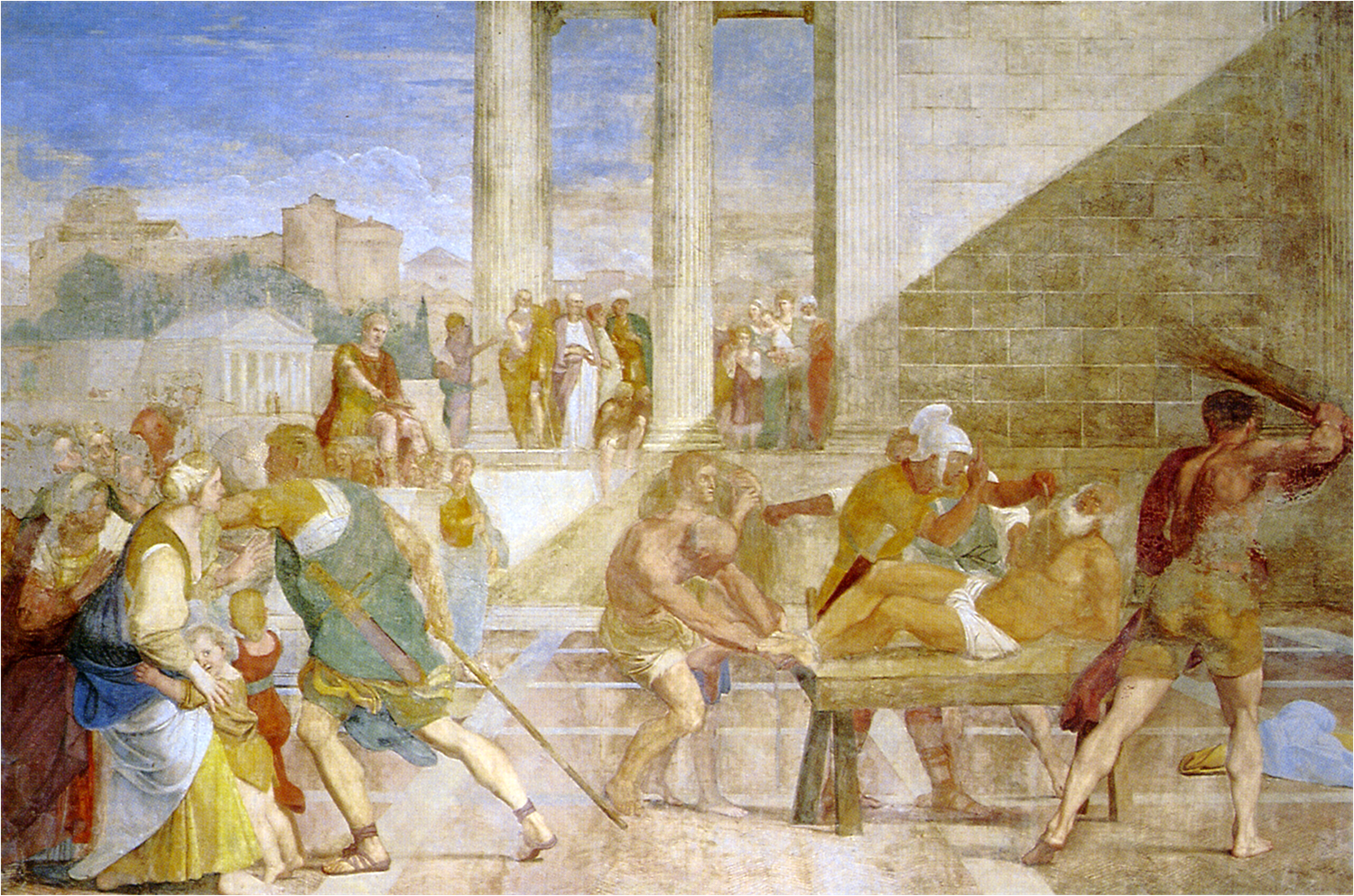
Domenichino
1608
Period/Movement: Baroque
Original Location: Likely commissioned for a church or private collection
Current Location: Galleria Nazionale d'Arte Antica, Rome, Italy
Patron: Likely a church or private collector, commissioned as part of a larger religious cycle
Material/Media/Medium: Oil on canvas
Technique: Naturalism, Chiaroscuro, Dramatic Realism
CONTENT
The painting depicts the Flagellation of St. Andrew, where the saint is shown being flogged as part of his martyrdom.
St. Andrew, the Christian apostle, is shown in a moment of intense suffering, his body contorted in pain as he is struck by several men with whips.
The focus is on the violence of the moment and the suffering of St. Andrew. His expression is one of anguish, while his body is shown in action, with his limbs tense and his face contorted in pain.
The figures around him, including the men administering the flagellation, are shown in the act of punishing him, their faces filled with determination or anger. The physical action is portrayed with dynamic movement, heightening the emotional intensity of the scene.
FORM
Composition: Domenichino uses a dynamic composition, with St. Andrew positioned at the center, surrounded by figures that create a sense of movement and action. The use of space and arrangement of figures enhances the dramatic nature of the scene, guiding the viewer’s attention to St. Andrew’s suffering.
Color: The rich reds, earth tones, and deep shadows create a sense of drama and heighten the emotional intensity of the scene. The whip marks and blood on St. Andrew’s body are painted with detail, emphasizing the violence and pain of the act.
Lighting: The strong use of chiaroscuro enhances the contrast between light and dark, with St. Andrew’s face and body highlighted against the dark background, emphasizing his martyrdom and the violence of his punishment.
Texture and Detail: The texture of the flesh, the movement of the whipping, and the expressive facial details of the figures demonstrate Domenichino’s mastery in creating a realistic and emotional portrayal of the scene.
CONTEXT & FUNCTION
Biblical Significance: The painting represents the martyrdom of St. Andrew, who was crucified on an X-shaped cross (known as the Saltire Cross). His flagellation was a part of the torture he endured before his execution.
Theological Context: The scene reflects the suffering and sacrifice of Christian saints, emphasizing faith and devotion in the face of violence. It highlights St. Andrew's strength of character and piety even in the face of brutal punishment.
Domenichino’s Style: Domenichino was part of the Bolognese School and was influenced by the classicizing style of artists like Rafael and Carracci. This work showcases his focus on dramatic realism, with a strong emphasis on the human experience of suffering.
STYLE & MEANING
Baroque Naturalism: Domenichino’s depiction of the flagellation is a prime example of Baroque naturalism, where he blends emotional intensity with naturalistic detail. The violent action and physical tension are depicted in a way that evokes sympathy and sorrow in the viewer.
Chiaroscuro: The use of light and shadow emphasizes the emotional depth of the scene, with the light highlighting the figure of St. Andrew, making him the focal point of the composition. The contrast between light and dark helps to create a sense of drama and intensity.
Emotional Realism: Domenichino captures the emotional depth of the moment, focusing on the suffering of St. Andrew and the violence of his punishment. His portrayal of the pain and anguish of the saint is empathetic, creating a connection with the viewer through shared emotion.
Religious and Heroic Themes: The depiction of suffering and sacrifice in the image of St. Andrew aligns with Christian themes of martyrdom and the ultimate reward for those who remain faithful in the face of adversity. The act of flagellation is a symbolic reminder of the sacrifices made by saints in the name of faith.
ARTISTIC INNOVATION
Dramatic Depiction of Suffering: Domenichino’s depiction of the Flagellation of St. Andrew is intensely dramatic, focusing not only on the physical act of violence but also on the emotional and psychological toll of the punishment. His attention to the human aspect of the scene is what sets it apart from other Baroque works.
Emphasis on Realism: Domenichino’s realistic portrayal of the figures and the violent action conveys a raw emotional power. He emphasizes realistic details such as the anguish on St. Andrew’s face, the movement of the whipping, and the physical strain of the figures involved, making the scene feel immediate and visceral.
Chiaroscuro Mastery: Domenichino’s use of chiaroscuro enhances the psychological tension and highlights the drama of the scene. The contrast between light and dark adds to the emotional impact, making the viewer focus on the suffering of the saint and the violent nature of the flagellation.
Scipione Borghese
(acquired or stole) An influential Italian cardinal, art collector, and patron during the Baroque period, best known for his extensive contributions to the arts and his significant role in the collection and promotion of masterpieces of Renaissance and Baroque art. Born into the prominent Borghese family in Rome, Scipione was the nephew of Pope Paul V, which provided him with powerful connections that he leveraged to enhance his artistic endeavors.
Scipione's passion for art and culture manifested in the creation of his own art collection, which became one of the most illustrious in Europe. Among his most celebrated acquisitions were works by Caravaggio, who was one of his favored artists. Scipione owned several of Caravaggio's significant paintings, including the renowned 'Young Sick Bacchus' and 'The Musicians.' His patronage of Caravaggio is credited with facilitating the artist's rising fame and mastery in naturalistic representations, dramatic lighting, and emotional depth.
In addition to Caravaggio, Scipione collected works from other leading artists of the time, including Raphael, Titian, and Gian Lorenzo Bernini. His interest in sculpture is particularly noteworthy, as he commissioned Bernini to create several significant pieces, including the famously dynamic 'Apollo and Daphne,' which showcases Bernini's extraordinary skill in marble and his capacity to convey movement and emotion intricately.
To house his vast collection, Scipione commissioned the construction of the Villa Borghese, a magnificent estate that became a center for intellectual and artistic exchange. The villa's gardens and galleries were designed to display his artworks and provided a serene setting for contemplation and appreciation of art. The Borghese Gallery, part of the villa, now houses one of the finest art collections in the world, attracting numerous visitors and art enthusiasts.
Scipione Borghese also played a crucial role in the cultural life of Rome during his time, hosting significant events that brought together artists, intellectuals, and patrons, thereby influencing the artistic direction of the Baroque period. Despite his ecclesiastical position, he was an active participant in the flourishing of art and culture, leaving behind a legacy that profoundly shaped the artistic landscape of Rome and beyond.
affetti
Refers to Italian for movements of the soul or passions a concept central to Renaissance and Baroque art theory
Last Communion of St. Jerome
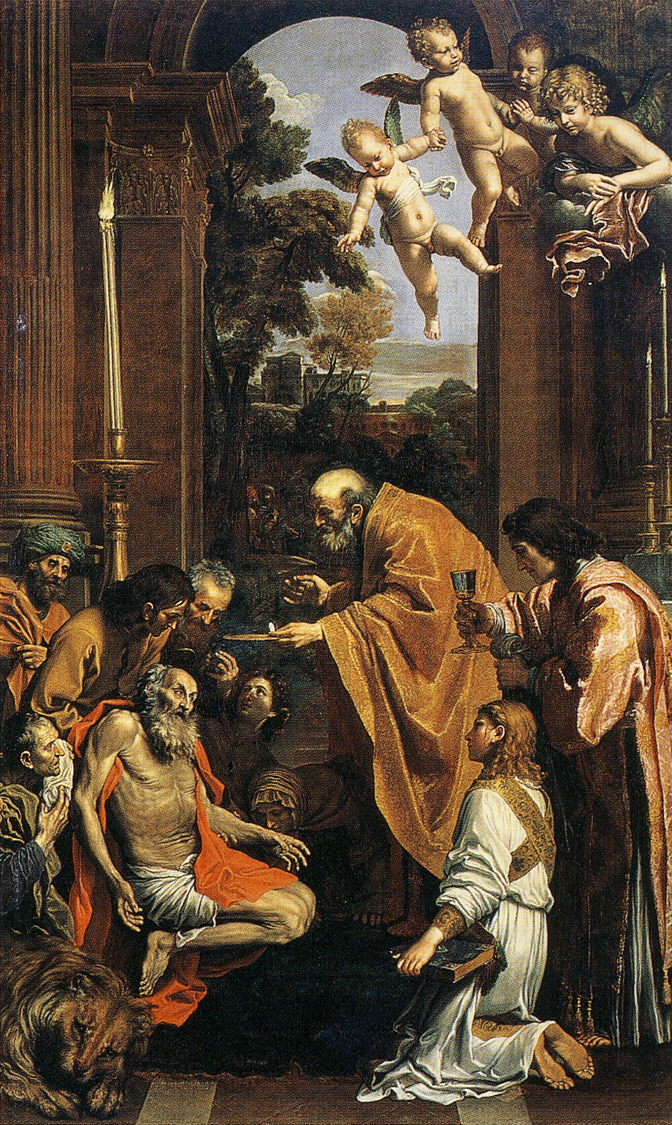
Domenichino
1614
Period/Movement: Baroque
Original Location: Likely commissioned for a church or private chapel
Current Location: Galleria Nazionale d'Arte Antica, Rome, Italy
Patron: Commissioned by a religious institution, possibly a church in Rome
Material/Media/Medium: Oil on canvas
Technique: Naturalism, Chiaroscuro, Classicism
CONTENT
The painting depicts St. Jerome in the final moments of his life, receiving the sacrament of communion from a priest. The scene emphasizes spiritual devotion and the importance of the Eucharist in the Christian faith.
St. Jerome, known for his translation of the Bible into Latin (the Vulgate), is depicted with great humility, accepting the communion as he faces death. His expression reflects calmness and reverence, as he prepares for the next phase of his spiritual journey.
The light source falls upon St. Jerome's face, symbolizing his connection with the divine. The figures around him, including the priest and a servant, are shown in a reverent and subdued manner, emphasizing the solemnity of the scene.
The emotional atmosphere of the painting is one of spiritual peace, as St. Jerome's face radiates inner peace in his final moments.
FORM
Composition: The composition is centered on St. Jerome, who is placed in a reclining position on a bed, symbolizing his imminent death. The priest offering communion stands at his side, with other figures surrounding the scene in a serene and respectful arrangement. The balance of the figures and their quiet actions contributes to the overall sense of calm.
Color: The color palette consists of earthy tones, including warm browns, soft reds, and golden highlights that enhance the spiritual warmth of the scene. The subdued tones emphasize the peaceful atmosphere and the sacred nature of the event.
Lighting: Domenichino employs chiaroscuro, with a strong light focusing on St. Jerome’s face, signifying the divine presence and his spiritual clarity at the time of his death. The surrounding figures are painted in soft shadow, drawing attention to the saint’s serenity and his connection with the divine.
Texture and Detail: Domenichino's attention to fine details in the textures of the fabrics, the light reflection on the cup, and the gentle depiction of the saint’s age and frailty shows his skill in creating a realistic and emotionally resonant portrayal of a moment of spiritual transcendence.
CONTEXT & FUNCTION
Biblical Significance: The painting represents the last communion of St. Jerome, who was known for his ascetic life and deep devotion to the Christian faith. In his final moments, he receives the Eucharist, symbolizing the holy union with Christ as he prepares for death.
Theological Context: The scene reflects the importance of communion as a sacrament in the Catholic tradition, marking the moment when the believer is united with Christ before death. It also serves as a reminder of faith, repentance, and spiritual peace in the face of mortality.
Domenichino’s Influence: Domenichino’s style was influenced by the classicizing principles of Rafael and the Carracci family, focusing on emotional realism, classical composition, and the depiction of spiritual themes with calm restraint. His works are often known for their naturalism and emotional depth, which is evident in this quiet and solemn scene.
STYLE & MEANING
Baroque Naturalism: Domenichino’s use of naturalism emphasizes the humanity of the saint, portraying him with gentle realism rather than as a saintly figure disconnected from real emotions. The peaceful expression of St. Jerome, the careful gestures of the priest, and the subdued presence of the servants create a calm atmosphere that contrasts with the often dramatic nature of Baroque religious art.
Chiaroscuro: Domenichino uses chiaroscuro to illuminate St. Jerome's face, emphasizing the moment of spiritual clarity and the sacredness of the communion ritual. The darkness surrounding the figures creates a spiritual void, which St. Jerome is about to transcend in his death.
Contemplative Moment: The painting focuses on reflection and inner peace rather than physical action or intense drama. St. Jerome’s final communion is a moment of quiet faith, inviting the viewer to contemplate the relationship between the body, soul, and faith at the moment of death.
ARTISTIC INNOVATION
Naturalistic Depiction of Death and Communion: Domenichino presents a more calm, contemplative interpretation of a saint’s final moments, departing from the usual intense drama found in some other Baroque representations of death. The peacefulness of the scene makes it stand out in the artist's career and adds a layer of quiet dignity to the act of death and spiritual communion.
Emotional Restraint: The emotionally restrained nature of the painting contrasts with the more dramatic works of his contemporaries. Domenichino’s approach to the subject emphasizes the intimacy and personal connection between St. Jerome and the divine, elevating the quiet moment over grand spectacle.
Classicism: The painting shows Domenichino's continued focus on classicizing techniques, with the serene composition and elegant, restrained figures echoing the classical influences of Rafael and the Carracci School, which was foundational to Baroque art.
MEANING & IMPACT
Devotion and Peace in Death: The painting conveys a deep sense of spiritual peace and reconciliation with God at the moment of death. It suggests that true communion with Christ offers not only redemption but also peace in the face of mortality.
Quiet Reflection of Faith: The work invites the viewer to reflect on the final moments of life and the importance of faith and sacraments. St. Jerome’s calm acceptance of the Eucharist serves as a model for the viewer’s own spiritual preparation for death.
imitatio, emulatio
Imitatio and Emulatio are two fundamental concepts in art and literature that describe the ways in which artists and writers have historically engaged with their predecessors. Rooted in classical rhetoric and philosophical traditions, these concepts emphasize the relationship between the original works of art and their imitators, providing insight into the creative process and the evolution of artistic styles.
Imitatio (Imitation):
Imitatio refers to the practice of imitation, where artists replicate the style, techniques, or subject matter of previous masters. In the Renaissance and Baroque periods, this concept was central to artistic training, as young artists were often encouraged to closely study and reproduce the works of their predecessors, such as Raphael, Titian, or Michelangelo.
This process of imitation served multiple purposes, including:
Skill Development: Aspiring artists honed their technical skills by replicating the compositions, forms, and colors of established masters, learning the fundamentals of their disciplines.
Cultural Transmission: Through imitation, artists preserved and transmitted cultural and artistic values, bridging the gap between different historical periods and styles.
Establishing Authority: Many artists sought to align themselves with the greatness of their predecessors, establishing their authority in the art world by demonstrating mastery of established techniques.
Emulatio (Emulation):
Emulatio, by contrast, encompasses a more ambitious approach, where the artist not only imitates but also seeks to surpass or rival the original works. This practice involves absorbing the qualities of distinguished works and channeling them into innovative expressions, reflecting a desire for originality and excellence.
Key aspects of emulatio include:
Creative Transformation: Artists reinterpreted traditional themes or styles, often injecting personal insights or contemporary understandings, thereby revitalizing established conventions.
Cultural Dialogue: Emulation fosters an ongoing dialogue within the artistic community, as new interpretations arise in response to the works of previous generations, allowing art to evolve and adapt to changing audiences and societal values.
Competition and Recognition: Emulatio encourages a spirit of competition among artists as they strive to make their mark, leading to the innovation of new techniques and forms that push the boundaries of artistic expression.
Overall, imitatio and emulatio represent two interconnected approaches that have shaped the history of art and literature, illustrating the complex interplay between tradition and innovation. Understanding these concepts provides valuable insight into the creative processes of artists and the ways in which they interact with the legacies of those who came before them.
Archery Contest of Diana and Her Nymphs (Hunt of Diana)
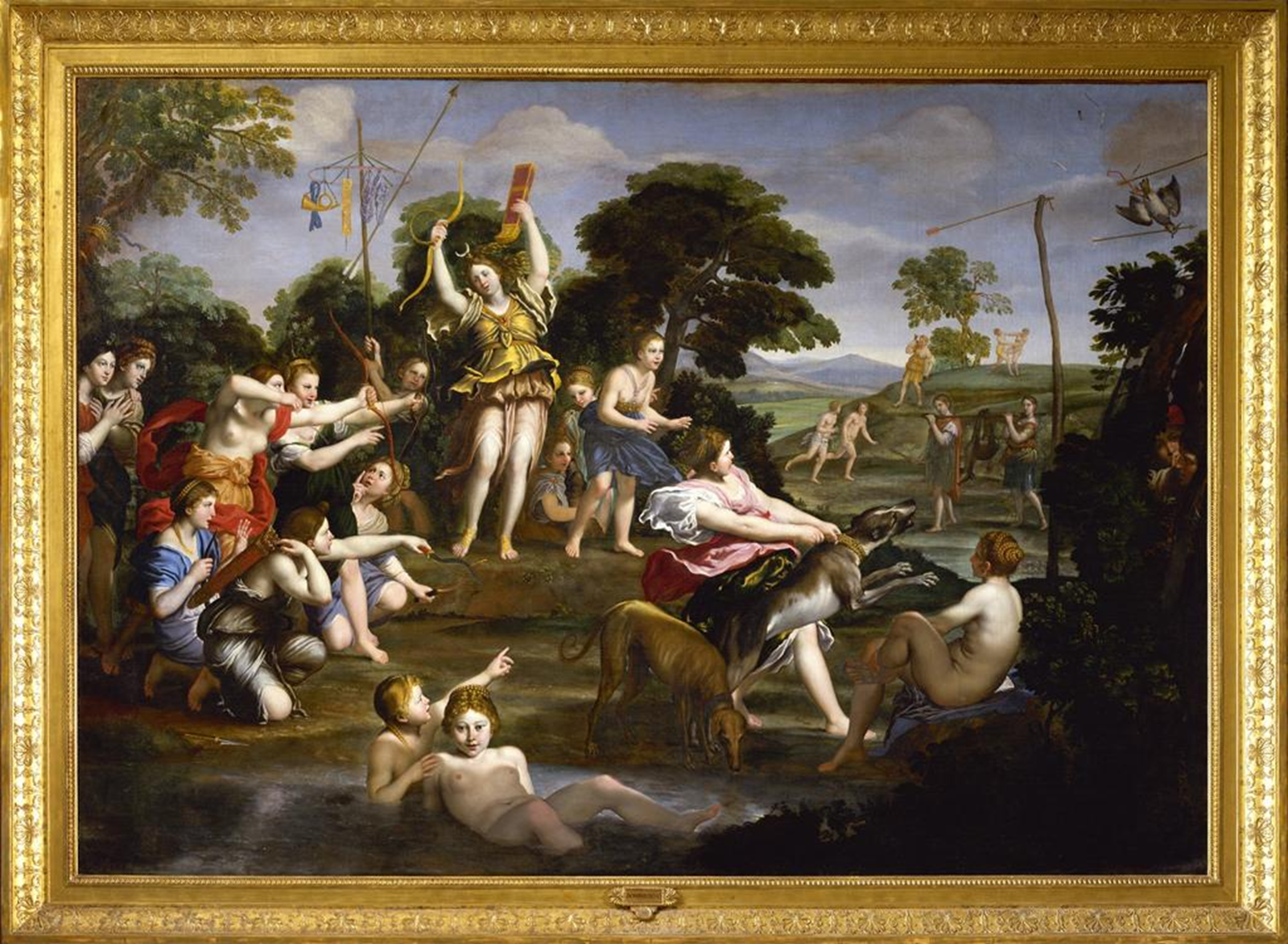
Domenichino
1616
Period/Movement: Baroque
Original Location: Palazzo Farnese, Rome (part of a series of frescoes for the Farnese Gallery)
Current Location: The Palazzo Farnese (now the French Embassy in Rome), although the frescoes are largely preserved in the building
Patron: Cardinal Alessandro Farnese, who commissioned the frescoes for the Farnese Gallery
Material/Media/Medium: Fresco
Technique: Classical, Baroque naturalism, dynamic movement, use of light and shadow
CONTENT
The scene depicts Diana, the Roman goddess of the hunt, in a friendly archery contest with her nymphs. They are shown in a dynamic and competitive moment, as they aim their arrows at a target.
Diana is traditionally depicted as a virgin goddess, associated with nature, wildlife, and the hunt. Here, the nymphs, her followers, also participate in the contest, emphasizing the themes of female empowerment and fellowship.
The archery contest captures a sense of movement, with the figures poised mid-action. The figures are active, and there is a clear sense of competitive energy and grace.
Diana’s companions are shown with graceful, athletic poses, reflecting their strength, agility, and feminine power. The natural environment around them emphasizes their connection to nature.
FORM
Composition: The composition is balanced, with Diana and her nymphs placed dynamically across the space. The use of diagonal lines and archery poses creates a sense of movement, while the grouping of figures brings the scene together.
Color: Domenichino uses vibrant, earthy tones in the figures’ clothing, juxtaposed with natural greens and blues that highlight the forest setting. The bright contrast between the goddesses' figures and their natural surroundings helps the viewer focus on the action of the contest.
Lighting and Shadow: As is typical in Baroque works, Domenichino employs chiaroscuro, using dramatic lighting to create depth and highlight the athleticism and emotion of the figures. The shadows emphasize the movement, giving the scene a sense of three-dimensionality.
Texture: The textures of the natural elements, such as trees, leaves, and clothing, are rendered in meticulous detail, enhancing the realism and adding to the scene's richness. The fine line work in the figures' limbs and clothing emphasizes the elegance of their actions.
CONTEXT & FUNCTION
Classical Inspiration: The subject matter comes from Roman mythology, and the contest among the nymphs and Diana draws inspiration from ancient texts about Diana's character. The Hunt of Diana was a popular subject in Renaissance and Baroque art, representing chastity, strength, and nature.
The Farnese Gallery Frescoes: This work is part of a larger cycle of frescoes painted for the Farnese Gallery, where Domenichino worked alongside other artists like Annibale Carracci. The theme of the goddess Diana in nature highlights the classical ideals of beauty and harmony, aligning with the classicizing movement of the Baroque.
Diana’s Symbolism: Diana’s contest reflects the goddess’s association with virginity and self-sufficiency, where her nymphs are shown as capable and empowered women. This connects to broader Baroque ideals of elevating human power and exaltation of nature.
STYLE & MEANING
Baroque Naturalism: Domenichino’s naturalism in this work is evident in the movement and vitality of the figures. The use of chiaroscuro enhances the dramatic action, giving the work an intense sense of three-dimensionality and realism, characteristic of Baroque art.
Movement and Action: The dynamic poses of the nymphs and Diana in action create a sense of energy that draws the viewer's attention into the contest, making it feel like an event that could be unfolding before them.
Power and Femininity: The female figures in this painting are depicted as strong, graceful, and active, with the archery contest serving as a metaphor for the empowerment of women. Unlike other contemporary works where women were often passive or objectified, here they are shown in positions of strength and control, celebrating their agency.
MEANING & IMPACT
Symbolism of Diana: The hunt and contest convey themes of chastity, strength, and independence, emphasizing the power of women within both mythological and societal contexts.
Baroque Focus on Movement and Emotion: The work reflects the Baroque desire to engage the viewer through dynamic compositions, emotional expression, and a strong connection to nature. It’s a visual celebration of youth, energy, and fertility within the confines of the mythological narrative.
Cultural Reflection: As part of the Farnese Gallery cycle, the work reflects the aristocratic interests in classical mythology, as well as the Catholic church’s push to affirm its power during the Baroque period by showcasing moral virtue and classical ideals.
Pietro Aldobrandini
an influential Italian nobleman, bishop, and art patron, recognized for his significant role in the cultural and artistic landscape of early 17th-century Rome. As a member of the prominent Aldobrandini family, he was the nephew of Pope Clement VIII, which enhanced his prominence and influence within the ecclesiastical hierarchy and the artistic community.
Background:
Born into one of the most powerful families in Rome, Pietro Aldobrandini's connections provided him access to court life and the leading artists of his time. He was educated in the arts and humanities, cultivating a passion for literature, philosophy, and visual arts.
Religious and Political Influence:
He served as a bishop and held various ecclesiastical offices, which allowed him to wield considerable influence in both religious and secular matters. His high-ranking position within the Church also made him a key figure during the Counter-Reformation, as he supported initiatives that aligned with the Catholic Church's interests and artistic directives.
Art Patronage:
Aldobrandini was an avid patron of the arts, collecting works from various artists and commissioning significant projects. His patronage included funding altarpieces, frescoes, and decorative schemes for churches and palaces, notably for the Church of Santa Maria in Via and other religious institutions.
Among the artists he commissioned were prominent figures like Caravaggio, who created dramatic and emotive works, and Francesco Borromini, a leading architect of the Baroque style. Aldobrandini's support of these artists contributed to the flourishing of Baroque aesthetics in Rome.
Cultural Contributions:
His involvement extended beyond mere collecting; he was deeply invested in the promotion of art as a vehicle for religious and moral messages. Under his patronage, artists were encouraged to express themes that resonated with Counter-Reformation ideals, emphasizing spirituality, virtue, and the divine.
Aldobrandini was also known to host gatherings that combined intellectual discourse with artistic critique, facilitating a vibrant cultural exchange among artists, theologians, and political figures, furthering the development of artistic trends during this period.
Legacy:
Pietro Aldobrandini's legacy is multifaceted; he is remembered not only for his contributions to art and architecture but also for his role in fostering a community of artists that shaped the Baroque movement. His influence in promoting high-quality artistic production reinforced the importance of patronage in the development of art, signaling the transition from the Renaissance ideals toward the expressive and emotional tendencies that characterized Baroque art.
Today, the works commissioned or influenced by Aldobrandini continue to be studied and admired, reflecting the rich heritage of 17th-century Roman art and the complex interplay between art, politics, and religion.
Scipione Borghese
a prominent Italian cardinal, art collector, and patron whose influence was pivotal in shaping the art world of the Baroque period, particularly in Rome. He was born into the powerful Borghese family, and as a nephew of Pope Paul V, he leveraged his familial connections to cultivate an extensive network within ecclesiastical and artistic circles.
Background and Early Life:
Scipione was educated in the humanities and the arts, developing an early appreciation for culture and aesthetics. His education laid the groundwork for his future endeavors as one of Rome's most significant art patrons.
He was appointed as a cardinal in 1605, which not only enhanced his prestige but also allowed him substantial influence over artistic patronage in the city.
Art Collection and Patronage:
Scipione Borghese's art collection was one of the finest of its time, comprising numerous masterpieces by celebrated artists, reflecting his discerning taste and commitment to the arts. He actively sought out works by masters such as:
Caravaggio: His patronage included acquiring notable paintings like 'The Young Sick Bacchus' and 'The Musicians.' Scipione's connection with Caravaggio significantly impacted the artist's career, as he was able to provide a crucial platform for Caravaggio's burgeoning fame.
Bernini: Scipione commissioned several key sculptures from Gian Lorenzo Bernini, including 'Apollo and Daphne' and 'The Rape of Proserpina,' which exemplify the dramatic movement and emotional depth characteristic of Baroque art. These works are celebrated for their technical mastery and intricate detail, showcasing Bernini's exceptional sculptural prowess.
Raphael and Titian: In addition to his contemporary artists, Borghese collected works by great Renaissance masters, demonstrating his appreciation for the art traditions that preceded him.
Villa Borghese:
To house his extensive collection, Scipione commissioned the construction of the Villa Borghese, a magnificent estate designed by architect Flaminio Ponzio. This villa became a cultural hub, featuring expansive gardens and galleries tailored to display his artworks.
The Borghese Gallery, which is part of the villa, was specifically created to exhibit his art collection. The gallery is renowned for its architectural beauty and its impressive assemblage of classical sculptures and Baroque masterpieces. It now serves as a major museum, attracting visitors from around the world who admire its rich collection.
Cultural Influence and Legacy:
Scipione was not only a collector but a crucial facilitator of artistic dialogue in Rome. He hosted intellectual gatherings that brought together artists, scholars, and political figures, fostering an environment of creativity and collaboration that significantly influenced Baroque art and culture.
His legacy extends beyond his lifetime; Scipione's contributions to the arts helped to define the character of Baroque aesthetics and left an indelible mark on the trajectory of Western art. His commitment to nurturing the arts and his role in commissioning monumental works continue to be celebrated and studied in art history.
Impact on the Art Market:
His extensive collection and the importance placed on patronage during his tenure contributed to the evolving notion of the artist's status in society. Artists began to be recognized not just as craftsmen but as creators worthy of accolades, setting a trend that would reshape the relationship between art and audience in subsequent generations.
Overall, Scipione Borghese stands as a quintessential figure of the Baroque era, whose devotion to art and culture significantly influenced the development of artistic practices in 17th-century Rome.